

17 Fun First Day Of School Writing Activities
The smell of freshly painted halls, the excited chatter of returning students bursting with two months’ worth of gossip to share—it must be the first day at school again.
Rusty pens and dusty pencils are hastily pulled from the bottom of school bags where, for many, they’ve lain all summer, ready for back to school.
You’ll need engaging writing activities to get those atrophied writing muscles back in shape. The standard ‘What I Did This Summer’ essay won’t cut it.
Luckily, we have 17 Great Back-to-School Writing Activities for you to help shake off the cobwebs and get your students’ writing skills back on par. Let’s get started.
Ice Breaker
Writing activities.
At the start of each school year, there’s likely to be a new face or two in the class, and while two months isn’t a long time in the grand scheme of things, our students can do a lot of growing and changing in that time.
Ice-breaker writing activities allow students to connect with others in the class. They give students some insight into the lives of their classmates.
Here are some fun ice-breaker writing activities to get the new school year off to a strong start writing-wise.
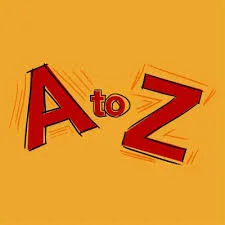
The A to Z of Me! Poem
Students write an acrostic poem about themselves in the A to Z of Me. The poem’s first line starts with the letter A, and each new line begins with the following letter of the alphabet, which should reveal something about the poet.
This may be too long for younger students – it’d be a 26-line poem after all. In this case, you can quickly adapt the activity to employ the letters of the student’s first name.
This activity aims for students to capture the essence of who they are in their poems. They can write a phrase or line based on their interests, appearance, things they have done, hobbies, desires, ideas, where they’re from, etc.
You can make this more challenging for older and stronger students by insisting they employ a rhyme scheme throughout their poems.
For example, they could write their poem in couplets (AA, BB, CC, etc.) or with an alternate line rhyming scheme (AB, AB, AB, etc).
When students have finished writing their acrostic poems about themselves, they can perform it to the whole class as a class poetry slam.
Guess Who? Writing Task
This fun activity challenges students to recall what they know about their classmates or, in the case of a newly formed group of students, to explore their initial impressions of each other.
In Guess Who?, the teacher divides the students into two groups. Each group writes down a unique fact about themselves on a piece of paper, folds it , and gives it to the teacher.
If everyone already knows each other very well, you might want to limit the facts to something they did over the summer that the others in the class are unaware of.
Students could write about a hobby or talent, a language they speak, a place they visited, or anything that makes them unique or special.
Students then take turns reading a fact written by someone from the other group, and they then guess who wrote it.
A point is awarded for each correct guess, the winning team being the team with the most points.

Interview A Classmate Writing Activity :
This activity allows students to get to know each other better while developing their interviewing, note-taking, and writing skills.
Begin this activity by asking the students to compile a list of questions that they would use to get to know someone they’d met for the first time.
The first questions the students generally tend to be surface-level small-talk-type questions such as:
- Where are you from?
- How many brothers and sisters do you have?
- What’s your favourite subject at school?
- What are your hobbies?
- What do you want to be when you grow up?
- What’s the best thing about you?
Write these on the whiteboard, of course. They’ll be helpful to as warm-up openers at the beginning of the interviews, but we want to encourage a deeper dive.
For the interviewer to better understand the interviewee, they’ll need to probe further.
Encourage students to come up with more challenging questions to ask in the interview and write these on the board. These questions should be geared toward gaining insight beyond the superficial.
Explain to the students that when they are the interviewee, if they’d prefer not to answer a specific question, they can just say “next” and the interviewer will move immediately onto the next question.
Some examples of deeper, more probing-type questions might include questions like:
- Can you tell me about an event or a story that significantly impacted your life?
- Who has had the most significant influence on who you are?
- What is the most challenging thing you’ve ever had to do?
- What is your best memory? Worst?
At the end of this brainstorming session, a considerable list of questions should be on the whiteboard.
Students are then partnered up. They will then take turns interviewing each other, with each interviewer taking comprehensive notes as they interview.
Students should not use voice recording equipment during this activity. This activity aims to improve note-taking abilities.
When the interviews are over, students write them up as best they can, using their notes and memories to recreate them.
For the more advanced students, this will involve recreating the interview’s dialogue and weaving a narrative around it to convey the interviewee’s character, expressions, and mannerisms.
First Day of School Persuasive Wish List Task
The start of a new school year is a time of hope and possibility captured in the form of a wish list.
But this isn’t an old wish list but a persuasive one.
The students will write a wish list of things they hope for from the new school year.
The twist is that they must make their case for why they should receive the concessions they seek.
Some items that might make the wish list could be the desire to see more time for their favourite activities, less homework, or creating a class council. It doesn’t matter what is on the list but that the student makes as strong a case as possible for them.
Students should be encouraged to use the full range of persuasive writing techniques available, from emotional language to social proof, from repetition to evidence and statistics.
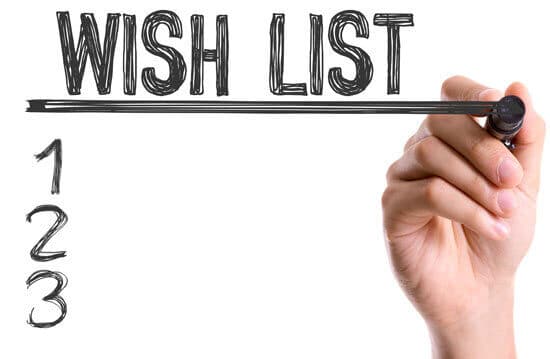
Collaborative Writing Activities
Collaborative writing activities offer students opportunities to work with a partner, a small group, or the whole class to produce a shared piece of writing.
As with the previous activities, these activities can break the ice. More than that, they help students establish a level of comfort working together to achieve a shared goal – a key dynamic to encourage at the start of any school year.

Snowball Story-Writing
In this simple but fun activity, each student starts by writing the beginning of a story. There should be an allotted amount of time to complete this, the length of which will depend on the age and abilities of the students.
When the allotted time is up, students should stop writing, roll their paper into a ball, and throw it towards the top of the classroom!
Students should then each retrieve one of the ‘snowballs’ from the front of the classroom and, when the timer is started, read the beginning of the story and then write the story middle until the time is up.
Again, the students throw their snowballs to the front of the classroom, before selecting a new snowball to write the ending.
When the stories are completed, they should be returned to the students who wrote the story beginning. This student should write a final draft of the story to ensure it reads well
Students can then share their stories by reading them out to the class.
Sometimes, students struggle to start their writing. To help them get going, it can be helpful to provide them with a sheet of paper with a writing prompt. This prompt can be a sentence or even a picture.
These prompts can be easily differentiated to suit the age and abilities of your students. For example, more prescriptive prompts are helpful for younger students, while more open-ended prompts will suit older and/or stronger students.
Tapestry Poems
Tapestry poems are a collaboration between two students. So, as a first step, you need to assign each student a partner to work with.
The next step requires you to assign a topic for each pair of students in the class. Each partner then independently writes a 9-line poem on the assigned topic.
When each student has finished their 9-line poem, they share them with their partner.
The task is for the students to work together now to produce an 18-line poem from the two 9-line poems they have created.
To do this, the students must collaborate to make the composite poem work. The idea here is to weave the different threads of the two topic interpretations into a single ‘tapestry’.
Students must include the nine lines of both poems, but they have room to edit for verb tense and make minor grammatical changes to make things work.
The partners must also compromise to agree on a single title for their shared piece.

The Peer Editing Exercise
This is a great way to introduce peer assessment into your classroom, especially with a group of students who are not familiar with the concept.
You will need to explain the editing and proofreading process to the students at the start. The specific criteria will, of course, depend on the age and abilities of your students.
To begin, organize the class into pairs of editing partners. Students should then swap their written work to be edited by their partners.
Any of the previous writing activities in this article would serve this purpose well.
Students can edit their partner’s work by annotating with a different colour pen, or, for more detailed commentary, they could use a separate sheet of paper.
Students then share their feedback.
This is an opportunity for students to see each other as resources to help them on their learning journey throughout the year.
It also helps students to develop resilience and an ability to absorb constructive criticism.
Students then rewrite their text in light of the feedback given.
Time for a plenary session should be made at the end to discuss their experiences of the process as a class.
The Summer Yearbook Writing Task
This writing project is based on the idea of school yearbooks.
School yearbooks are compilations of memories, photographs, and quotes. In this version, students compile a compendium based on their collective experiences during the school break.
The format can inspire many writing activities.
Students can gather quotes on the various events of vacation time together. These can be sourced from family, friends, classmates, etc.
They can also collect photographs and write suitable captions for inclusion in the yearbook. The book could include a page for the students’ autographs and a page for summer memories and hopes for the coming year.
Technology can be easily incorporated into this lesson by producing a digital version. Collaborative applications such as Google Drive are perfect for this type of work.

Year Long Inference Based Writing Activities

Tap into the power of imagery in your classroom to master INFERENCE as AUTHORS and CRITICAL THINKERS .
⭐⭐⭐⭐⭐ (26 Reviews)
This YEAR-LONG 500+ PAGE unit is packed with robust opportunities for your students to develop the critical skill of inference through fun imagery, powerful thinking tools, and graphic organizers.
Memory Writing Activities
While we want to avoid the cliched ‘ What I Did This Summer ’ essay, it doesn’t mean that memories of the long holidays can’t serve as an ‘ in’ to some worthwhile writing activities.
In the following writing activities, students will be asked to access their memories of summer to serve as a jumping-off point. Let’s get started!

Paint a Picture With Words
Essentially, this writing activity challenges students to write by employing their senses to evoke a memory.
First, ask the students to choose from a memory of a place they visited during the summer vacation. It doesn’t matter whether it’s a beach trip or a visit to a shopping mall; they’ll both serve equally well for this activity.
Students must then endeavour to recreate the scene as they recall it through careful selection of vocabulary and description.
The main focus of this type of writing will be the use of sensory language. Students should meditate on what they saw, heard, smelled, tasted, and felt while in their chosen place.
Students should work to paint a vivid, multi-dimensional picture in the reader’s minds-eye. For this reason, they should choose a static memory, such as a scene they recall. This activity has more in common with landscape painting than with film-making. A plot is not required.
This activity allows students to hone their descriptive writing skills, which will help them improve their writing in many genres.
Haiku Writing Activity
As with the last activity, this type of poetry is typically focused on evoking a scene. In the case of the haiku, this is usually a natural scene.
Before putting pen to paper, be sure students are suitably familiar with the features of the haiku:
- It consists of 3 lines
- It contains 17 syllables
- The 1st and 3rd lines have 5 syllables and the 2nd line has 7 syllables
- It does not need to rhyme
- It’s usually about nature or a natural phenomenon
- Often has two contrasting or juxtaposed subjects woven into it.
This activity is best introduced by reading and examining a couple of well-written haikus, such as those by Basho in translation, to ensure student familiarity with the form.
This is a very meditative writing form. It is essential to set a suitable mood and atmosphere in the classroom to encourage the necessary concentration and reflection the writing process will require. Playing gentle instrumental music is one way to help achieve this ambience.

Fun Back To School Writing Activities
While the first of our Back to School Writing Activities focuses clearly on breaking the ice and drawing on memories, the primary focus of the following writing activities is on having fun.
These activities will also offer students opportunities to develop some technical aspects of their writing skills; the main emphasis here is on students seeing writing as a fun, creative activity where they have the space and time for self-expression.
Don’t forget to read our complete guide to Fun Writing activities here.

Creative Excuses Writing Task
To start this activity, students must devise a list of 10 chores or tasks they absolutely hate doing.
Next, students should choose four from this list of their most detested tasks and write a letter explaining why they cannot complete them.
Encourage students to get creative with their excuses. The crazier and more imaginative the excuses are, the better. This activity is an opportunity for students to let their imaginations loose.
‘What If?’ Writing Prompts
Writing prompts are an excellent way for students to break through writer’s block. In this activity, students generate their own writing prompts by creating ‘ what if? ’ scenarios for other students in the class to use as writing prompts.
Many of the best and most creative stories start with an inquiry into what would happen if x happened. These scenarios can be silly, serious, fantastical, or humorous if they provide a jumping-off point for the student writer.
When students have completed their prompts, the teacher should gather them to distribute randomly among the class.
Students can share their work with the class When they have finished writing their responses to their assigned prompts. This will be especially interesting for the writer of the original prompt.

The Book Of Summer
This writing activity is an upgrade from the “My Summer Vacation” type essays.
In this activity, each student will compile their Book of Summer, describing and depicting their holidays using as many different writing genres as possible.
For example, the student might include the following in their Book of Summer:
- A non-chronological report on a day trip
- A comic strip based on a family celebration
- A review of a movie they saw or book they read
- A fictionalized account of their summer
- A recipe of a meal they made
- A playscript for a sleepover they went on
- A haiku on the end of summer
The scope for creative interpretations here is almost endless.
For younger students , it may be best to be more prescriptive about the various genres to include and the titles for each piece.
But for students with the ability, the open-endedness of this task allows their creativity to run loose while affording you a valuable opportunity to see just what they are capable of.
Be sure to read our complete collection of back-to-school writing activities.
Fictional Interviews Writing Task
This activity involves a little bit of writing and a lot of role-playing.
In this activity, students should be paired up with a partner. Each partner chooses a fictional character they will role-play. The character can be from any fiction, for example, movies, comic books, or literature.
Partners must prepare and write up a series of interview questions for their partner’s fictional character.
Partners take turns interviewing each other while the interviewee is in character.
This is a great way to bring a bit of drama into the classroom, but if you want to emphasize the writing aspect of the activity, you can set the students up for the interview in the style of a magazine feature article. This will require the student to weave some narrative writing around the back and forth of the questions and answers of the interview.

Write A Story From A Different Point Of View
Narrative writing requires competency in a broad range of complex skills . We can roughly divide those skills into structural ones (such as text organization) and language-related skills (such as sentence construction and creativity).
Getting your students to write a story is a great way to assess their abilities in these areas.
In this activity, however, you provide most of the structure for the student, giving them the space to exercise their imagination and a chance to focus on their grammatical control – among other things.
In this exercise, ask your students to select a favourite fairy tale or other traditional story they know well. The student’s task is to rewrite their favourite fairy tale from the point of view of another important character in the story.
For example, they might want to retell the Jack and the Beanstalk story from the point of view of the Giant or Jack’s mother.
Retelling The Ugly Duckling , the student might want to write from Mother Duck’s perspective to explore her feelings about the runt of her litter suddenly transforming into a beautiful (if alien!) swan
Summer Headlines Writing Activity
Headlines are fun to write .
They should be short and pithy, seizing the reader’s attention by telling them just enough about the story to pique their interest but still leave them wanting to read more.
There are several things that students can do to ensure their headlines have the desired effect, including:
- Choose powerful words designed to make an impact
- Use alliteration to create catchy, snappy headlines
- Employ humour to entertain and intrigue the reader
- Create suspense by posing the headline as a question
For this activity, students should list the main events of their summer break and create a headline for each event.
In this way, the students will have produced an account of their summer written entirely in headlines.
As an extension to this exercise, when they’ve finished producing their headlines, have them present them to the class or in smaller groups.
The best headline is selected from each list, which the student has to turn into a complete newspaper-style article on that event.

Rap and Verse Writing Task
Few genres of writing can be as divisive.
Some are dismayed by the mere mention of the word ‘poetry’ – The “ Why can’t poets just say what they mean? ” camp.
Then, some can barely write a shopping list without a bit of unnecessary versifying.
Love it or loathe it, poetry is on the curriculum and our students need to get to grips with it.
For this activity, students write a series of poems inspired by the events of their summer holidays. Essentially, they are writing a poetic account of their vacation.
To challenge the students, they must use a different type of poetry for each event they wish to retell.
For example, they might write a series of haikus on the weather during the summer break.
Perhaps they’ll produce a calligram or shape poem describing the treehouse they made.
Maybe they’ll write an elegy to a pet that died or a limerick on that disastrous camping trip.
They might like to use the headlines from the previous activity A Summer in Headlines as starting points for their poems.
By the end of this activity, your students will have a collection of self-authored poetry they can share with the class in the form of a poetry slam.
You may wish to provide your students with checklists of the various features of the different types of poetry to help them during this activity.
So, there we have seventeen engaging activities to kick start the writing process at the start of the school year.
There is quite a variety from here, with some activities honing technical aspects of the writing process while others are more centred on the fun of creativity.
Remember, at the start of the school year, what the students write isn’t so important, but what they write!
With the selection of activities above, you’re sure to find one to suit even the most pen-shy students!
Daily Quick Writes For All Text Types

Our FUN DAILY QUICK WRITE TASKS will teach your students the fundamentals of CREATIVE WRITING across all text types. Packed with 52 ENGAGING ACTIVITIES
OTHER GREAT WRITING ACTIVITIES TO TRY

7 Evergreen Writing Activities for Elementary Students

10 fun writing activities for the reluctant writer

13 Fun Reading Activities for Any Book
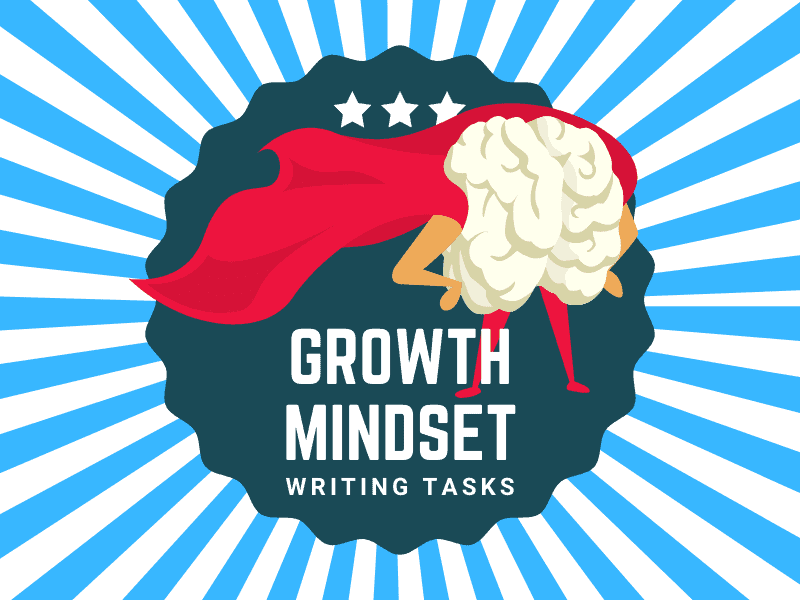
5 Fun Growth Mindset Writing Activities Students and Teachers Love

6 YouTube Writing Activities for Students and Teachers
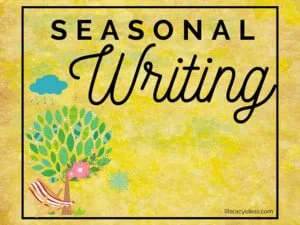
5 Fun Seasonal Writing Activities Students and Teachers Love
- CORE CURRICULUM
- LITERACY > CORE CURRICULUM > Into Literature, 6-12" data-element-type="header nav submenu" title="Into Literature, 6-12" aria-label="Into Literature, 6-12"> Into Literature, 6-12
- LITERACY > CORE CURRICULUM > Into Reading, K-6" data-element-type="header nav submenu" title="Into Reading, K-6" aria-label="Into Reading, K-6"> Into Reading, K-6
- INTERVENTION
- LITERACY > INTERVENTION > English 3D, 4-12" data-element-type="header nav submenu" title="English 3D, 4-12" aria-label="English 3D, 4-12"> English 3D, 4-12
- LITERACY > INTERVENTION > Read 180, 3-12" data-element-type="header nav submenu" title="Read 180, 3-12" aria-label="Read 180, 3-12"> Read 180, 3-12
- LITERACY > READERS > Hero Academy Leveled Libraries, PreK-4" data-element-type="header nav submenu" title="Hero Academy Leveled Libraries, PreK-4" aria-label="Hero Academy Leveled Libraries, PreK-4"> Hero Academy Leveled Libraries, PreK-4
- LITERACY > READERS > HMH Reads Digital Library, K-5" data-element-type="header nav submenu" title="HMH Reads Digital Library, K-5" aria-label="HMH Reads Digital Library, K-5"> HMH Reads Digital Library, K-5
- LITERACY > READERS > inFact Leveled Libraries, K-5" data-element-type="header nav submenu" title="inFact Leveled Libraries, K-5" aria-label="inFact Leveled Libraries, K-5"> inFact Leveled Libraries, K-5
- LITERACY > READERS > Rigby PM, K-5" data-element-type="header nav submenu" title="Rigby PM, K-5" aria-label="Rigby PM, K-5"> Rigby PM, K-5
- LITERACY > READERS > Science & Engineering Leveled Readers, K-5" data-element-type="header nav submenu" title="Science & Engineering Leveled Readers, K-5" aria-label="Science & Engineering Leveled Readers, K-5"> Science & Engineering Leveled Readers, K-5
- SUPPLEMENTAL
- LITERACY > SUPPLEMENTAL > A Chance in the World SEL, 8-12" data-element-type="header nav submenu" title="A Chance in the World SEL, 8-12" aria-label="A Chance in the World SEL, 8-12"> A Chance in the World SEL, 8-12
- LITERACY > SUPPLEMENTAL > Amira Learning, K-6" data-element-type="header nav submenu" title="Amira Learning, K-6" aria-label="Amira Learning, K-6"> Amira Learning, K-6
- LITERACY > SUPPLEMENTAL > Classcraft, K-8" data-element-type="header nav submenu" title="Classcraft, K-8" aria-label="Classcraft, K-8"> Classcraft, K-8
- LITERACY > SUPPLEMENTAL > JillE Literacy, K-3" data-element-type="header nav submenu" title="JillE Literacy, K-3" aria-label="JillE Literacy, K-3"> JillE Literacy, K-3
- LITERACY > SUPPLEMENTAL > Waggle, K-8" data-element-type="header nav submenu" title="Waggle, K-8" aria-label="Waggle, K-8"> Waggle, K-8
- LITERACY > SUPPLEMENTAL > Writable, 3-12" data-element-type="header nav submenu" title="Writable, 3-12" aria-label="Writable, 3-12"> Writable, 3-12
- LITERACY > SUPPLEMENTAL > ASSESSMENT" data-element-type="header nav submenu" title="ASSESSMENT" aria-label="ASSESSMENT"> ASSESSMENT
- MATH > CORE CURRICULUM > Arriba las Matematicas, K-8" data-element-type="header nav submenu" title="Arriba las Matematicas, K-8" aria-label="Arriba las Matematicas, K-8"> Arriba las Matematicas, K-8
- MATH > CORE CURRICULUM > Go Math!, K-6" data-element-type="header nav submenu" title="Go Math!, K-6" aria-label="Go Math!, K-6"> Go Math!, K-6
- MATH > CORE CURRICULUM > Into Algebra 1, Geometry, Algebra 2, 8-12" data-element-type="header nav submenu" title="Into Algebra 1, Geometry, Algebra 2, 8-12" aria-label="Into Algebra 1, Geometry, Algebra 2, 8-12"> Into Algebra 1, Geometry, Algebra 2, 8-12
- MATH > CORE CURRICULUM > Into Math, K-8" data-element-type="header nav submenu" title="Into Math, K-8" aria-label="Into Math, K-8"> Into Math, K-8
- MATH > CORE CURRICULUM > Math Expressions, PreK-6" data-element-type="header nav submenu" title="Math Expressions, PreK-6" aria-label="Math Expressions, PreK-6"> Math Expressions, PreK-6
- MATH > CORE CURRICULUM > Math in Focus, K-8" data-element-type="header nav submenu" title="Math in Focus, K-8" aria-label="Math in Focus, K-8"> Math in Focus, K-8
- MATH > SUPPLEMENTAL > Classcraft, K-8" data-element-type="header nav submenu" title="Classcraft, K-8" aria-label="Classcraft, K-8"> Classcraft, K-8
- MATH > SUPPLEMENTAL > Waggle, K-8" data-element-type="header nav submenu" title="Waggle, K-8" aria-label="Waggle, K-8"> Waggle, K-8
- MATH > INTERVENTION > Math 180, 5-12" data-element-type="header nav submenu" title="Math 180, 5-12" aria-label="Math 180, 5-12"> Math 180, 5-12
- SCIENCE > CORE CURRICULUM > Into Science, K-5" data-element-type="header nav submenu" title="Into Science, K-5" aria-label="Into Science, K-5"> Into Science, K-5
- SCIENCE > CORE CURRICULUM > Into Science, 6-8" data-element-type="header nav submenu" title="Into Science, 6-8" aria-label="Into Science, 6-8"> Into Science, 6-8
- SCIENCE > CORE CURRICULUM > Science Dimensions, K-12" data-element-type="header nav submenu" title="Science Dimensions, K-12" aria-label="Science Dimensions, K-12"> Science Dimensions, K-12
- SCIENCE > READERS > inFact Leveled Readers, K-5" data-element-type="header nav submenu" title="inFact Leveled Readers, K-5" aria-label="inFact Leveled Readers, K-5"> inFact Leveled Readers, K-5
- SCIENCE > READERS > Science & Engineering Leveled Readers, K-5" data-element-type="header nav submenu" title="Science & Engineering Leveled Readers, K-5" aria-label="Science & Engineering Leveled Readers, K-5"> Science & Engineering Leveled Readers, K-5
- SCIENCE > READERS > ScienceSaurus, K-8" data-element-type="header nav submenu" title="ScienceSaurus, K-8" aria-label="ScienceSaurus, K-8"> ScienceSaurus, K-8
- SOCIAL STUDIES > CORE CURRICULUM > HMH Social Studies, 6-12" data-element-type="header nav submenu" title="HMH Social Studies, 6-12" aria-label="HMH Social Studies, 6-12"> HMH Social Studies, 6-12
- SOCIAL STUDIES > SUPPLEMENTAL > Writable" data-element-type="header nav submenu" title="Writable" aria-label="Writable"> Writable
- For Teachers
- PROFESSIONAL DEVELOPMENT > For Teachers > Coachly" data-element-type="header nav submenu" title="Coachly" aria-label="Coachly"> Coachly
- PROFESSIONAL DEVELOPMENT > For Teachers > Teacher's Corner" data-element-type="header nav submenu" title="Teacher's Corner" aria-label="Teacher's Corner"> Teacher's Corner
- PROFESSIONAL DEVELOPMENT > For Teachers > Live Online Courses" data-element-type="header nav submenu" title="Live Online Courses" aria-label="Live Online Courses"> Live Online Courses
- For Leaders
- PROFESSIONAL DEVELOPMENT > For Leaders > The Center for Model Schools (formerly ICLE)" data-element-type="header nav submenu" title="The Center for Model Schools (formerly ICLE)" aria-label="The Center for Model Schools (formerly ICLE)"> The Center for Model Schools (formerly ICLE)
- MORE > undefined > Assessment" data-element-type="header nav submenu" title="Assessment" aria-label="Assessment"> Assessment
- MORE > undefined > Early Learning" data-element-type="header nav submenu" title="Early Learning" aria-label="Early Learning"> Early Learning
- MORE > undefined > English Language Development" data-element-type="header nav submenu" title="English Language Development" aria-label="English Language Development"> English Language Development
- MORE > undefined > Homeschool" data-element-type="header nav submenu" title="Homeschool" aria-label="Homeschool"> Homeschool
- MORE > undefined > Intervention" data-element-type="header nav submenu" title="Intervention" aria-label="Intervention"> Intervention
- MORE > undefined > Literacy" data-element-type="header nav submenu" title="Literacy" aria-label="Literacy"> Literacy
- MORE > undefined > Mathematics" data-element-type="header nav submenu" title="Mathematics" aria-label="Mathematics"> Mathematics
- MORE > undefined > Professional Development" data-element-type="header nav submenu" title="Professional Development" aria-label="Professional Development"> Professional Development
- MORE > undefined > Science" data-element-type="header nav submenu" title="Science" aria-label="Science"> Science
- MORE > undefined > undefined" data-element-type="header nav submenu">
- MORE > undefined > Social and Emotional Learning" data-element-type="header nav submenu" title="Social and Emotional Learning" aria-label="Social and Emotional Learning"> Social and Emotional Learning
- MORE > undefined > Social Studies" data-element-type="header nav submenu" title="Social Studies" aria-label="Social Studies"> Social Studies
- MORE > undefined > Special Education" data-element-type="header nav submenu" title="Special Education" aria-label="Special Education"> Special Education
- MORE > undefined > Summer School" data-element-type="header nav submenu" title="Summer School" aria-label="Summer School"> Summer School
- BROWSE RESOURCES
- BROWSE RESOURCES > Classroom Activities" data-element-type="header nav submenu" title="Classroom Activities" aria-label="Classroom Activities"> Classroom Activities
- BROWSE RESOURCES > Customer Success Stories" data-element-type="header nav submenu" title="Customer Success Stories" aria-label="Customer Success Stories"> Customer Success Stories
- BROWSE RESOURCES > Digital Samples" data-element-type="header nav submenu" title="Digital Samples" aria-label="Digital Samples"> Digital Samples
- BROWSE RESOURCES > Events" data-element-type="header nav submenu" title="Events" aria-label="Events"> Events
- BROWSE RESOURCES > Grants & Funding" data-element-type="header nav submenu" title="Grants & Funding" aria-label="Grants & Funding"> Grants & Funding
- BROWSE RESOURCES > International" data-element-type="header nav submenu" title="International" aria-label="International"> International
- BROWSE RESOURCES > Research Library" data-element-type="header nav submenu" title="Research Library" aria-label="Research Library"> Research Library
- BROWSE RESOURCES > Shaped - HMH Blog" data-element-type="header nav submenu" title="Shaped - HMH Blog" aria-label="Shaped - HMH Blog"> Shaped - HMH Blog
- BROWSE RESOURCES > Webinars" data-element-type="header nav submenu" title="Webinars" aria-label="Webinars"> Webinars
- CUSTOMER SUPPORT
- CUSTOMER SUPPORT > Contact Sales" data-element-type="header nav submenu" title="Contact Sales" aria-label="Contact Sales"> Contact Sales
- CUSTOMER SUPPORT > Customer Service & Technical Support Portal" data-element-type="header nav submenu" title="Customer Service & Technical Support Portal" aria-label="Customer Service & Technical Support Portal"> Customer Service & Technical Support Portal
- CUSTOMER SUPPORT > Platform Login" data-element-type="header nav submenu" title="Platform Login" aria-label="Platform Login"> Platform Login
- Learn about us
- Learn about us > About" data-element-type="header nav submenu" title="About" aria-label="About"> About
- Learn about us > Diversity, Equity, and Inclusion" data-element-type="header nav submenu" title="Diversity, Equity, and Inclusion" aria-label="Diversity, Equity, and Inclusion"> Diversity, Equity, and Inclusion
- Learn about us > Environmental, Social, and Governance" data-element-type="header nav submenu" title="Environmental, Social, and Governance" aria-label="Environmental, Social, and Governance"> Environmental, Social, and Governance
- Learn about us > News Announcements" data-element-type="header nav submenu" title="News Announcements" aria-label="News Announcements"> News Announcements
- Learn about us > Our Legacy" data-element-type="header nav submenu" title="Our Legacy" aria-label="Our Legacy"> Our Legacy
- Learn about us > Social Responsibility" data-element-type="header nav submenu" title="Social Responsibility" aria-label="Social Responsibility"> Social Responsibility
- Learn about us > Supplier Diversity" data-element-type="header nav submenu" title="Supplier Diversity" aria-label="Supplier Diversity"> Supplier Diversity
- Join Us > Careers" data-element-type="header nav submenu" title="Careers" aria-label="Careers"> Careers
- Join Us > Educator Input Panel" data-element-type="header nav submenu" title="Educator Input Panel" aria-label="Educator Input Panel"> Educator Input Panel
- Join Us > Suppliers and Vendors" data-element-type="header nav submenu" title="Suppliers and Vendors" aria-label="Suppliers and Vendors"> Suppliers and Vendors
- Divisions > Center for Model Schools (formerly ICLE)" data-element-type="header nav submenu" title="Center for Model Schools (formerly ICLE)" aria-label="Center for Model Schools (formerly ICLE)"> Center for Model Schools (formerly ICLE)
- Divisions > Heinemann" data-element-type="header nav submenu" title="Heinemann" aria-label="Heinemann"> Heinemann
- Divisions > NWEA" data-element-type="header nav submenu" title="NWEA" aria-label="NWEA"> NWEA
- Platform Login
SOCIAL STUDIES
PROFESSIONAL DEVELOPMENT
29 Back-to-School Writing Prompts for Middle and High School

The first day of school is approaching, and as a teacher, your schedule is likely already filling up with organizational and instructional prep work. However, despite all of your efforts, you may find that some students may emerge slowly from their summer hazes.
Before your middle school or high school students start their assigned reading, get them engaged with these back-to-school writing prompts. Fill up some class time with a few warm-up writing prompts below, or send students home with a larger assignment to get them back into the swing of things!
First Day of School Writing Prompts: Middle School Students
Classroom Prompt Assignments
- Stream of consciousness is when a character lets their thoughts continuously flow. Write a stream of consciousness story of your own and see where your thoughts take you.
- For the new school year, what new skill would you choose to learn if you had the time, money, and ability? Why?
- Write a critique of a book, movie, or show you recently read or watched. What were its strong points? What were its weak ones?
- Describe the reigning emotions you felt this summer. Why did you feel that way, and how do you think these emotions might change as the school year progresses?
- Choose a place you traveled to this summer, either locally or far away, and write a blog post about that location. Should other people visit as well? It could be a restaurant, a town, a shop, or a favorite spot to hang out.
- If there is a club, sport, class, or event you are excited about this year, write what you already know about it. Follow up with some expectations that you have for the experience and yourself.
- A flashbulb memory is a very detailed memory that you have from when you were young. Do you have any memories like that, and if so, what are they about? Are there any events that have happened recently that you think you will remember for a long time?
- Do you have any traditions? If not, which one would you want to start this year?
- Describe the most memorable school project that you’ve ever done. Would you like to do a similar project this year, and if so, how can it be adapted to what you’re learning now?
- If you could create a themed book display for your school library, what would it be? Which titles would it include, and why?
Take-Home Writing Assignments
- Write a letter to your younger self, and then another to your older self.
- One important rule of creative writing is to “Show Don’t Tell.” Write a 1,500-word short story in your favorite genre, following this rule.
- Write a local wildlife guide to your backyard, neighborhood, local park, or even the school itself. What flora and fauna exist there?
- Write a 1,000-word essay about an aspect of your summer that focuses on the five basic senses—Sight, Hearing, Smell, Taste, and Touch.

First Day of School Writing Prompts: High School Students
- Set three resolutions for yourself to accomplish this year and describe why those are the ones you chose.
- Write a list of How-To instructions for something that you know how to do. It could be making a meal, cleaning something, playing a game, babysitting, drawing a picture, etc.
- Create a dream college for you to attend once you graduate. Which academic programs does it offer? What sports, art classes, and clubs are offered? Where is it located?
- Write a short story using only dialogue. Work on creating different voices for each character. If it helps, take notes on each character before the dialogue starts. Does one character use slang? Is the other excitable? Is one character older than the other?
- Write a song on a subject that isn’t usually heard in other songs.
- Create a new class for your school to offer. Why do you think that class is necessary? What are the learning goals for that class, and what are the assignments?
- Which app do you spend the most time on? What are the positive aspects of using the app? What are the negatives?
- Is there a cause that you want to be a part of? What is it, and why is it important to you?
- Create a new club for your community or school. What is the club about? What are your goals, and who do you hope will join?
- Describe three things that you are looking forward to this year.
- What is your ultimate dream job? Research the industry, company, or role you’re interested in and report on what it is and how to get there. Conclude with your expectations before and after your research. Is the job what you thought it was?
- Choose a position with the local government to run for and outline a platform to run on. Then, write a speech to voters about your platform. Make sure to research your current representatives to learn what their platforms are.
- What is going on in the town or city that you live in? Research local events, places, volunteer opportunities, parks, clubs, etc. Visit a new place or attend a new event, then write a review of your experiences using descriptive language. Would you go back again? Why or why not?
- An executive summary is an intro to a business plan that is designed to grab the reader’s attention by summarizing what the new business will accomplish. Write an executive summary between 500 and 1,000 words for a product, venture, or business that you wish existed.
- Research a historical figure that looks a little like you do (bonus points if you’ve never heard of them before now). What did they accomplish?
No matter how much or how little your students read this summer, get their creativity flowing with these thought-provoking journal prompts to kick off the year. By focusing on descriptive language, persuasive arguments, and ideas for the future, your middle school or high school class will find their writer's stride in no time.
Try Writable to support your ELA curriculum, district benchmarks, and state standards with more than 600 fully customizable writing assignments and rubrics for students in Grades 3–12 .
Try out a free trial of Writable today by following these steps:
- Go to hmh.writable.com
- Click "Log in or Create Account"
- Choose "I'm a teacher"
- Sign in with Google or Microsoft account
- Select the grade level you teach
- Activities & Lessons
- Grades 9-12
Related Reading

8 Fun Last-Day-of-School Activities for Elementary School
Alicia Ivory Shaped Editor
April 18, 2024

Podcast: Embracing Data and Planning with It Feat. Latonia Grant in GA on Teachers in America
Jennifer Corujo Shaped Editor

10 Effective Teaching Strategies for Every Classroom
Shaped Contributor

First Day of School Writing Prompts: Start the Year with Words
My name is Debbie, and I am passionate about developing a love for the written word and planting a seed that will grow into a powerful voice that can inspire many.
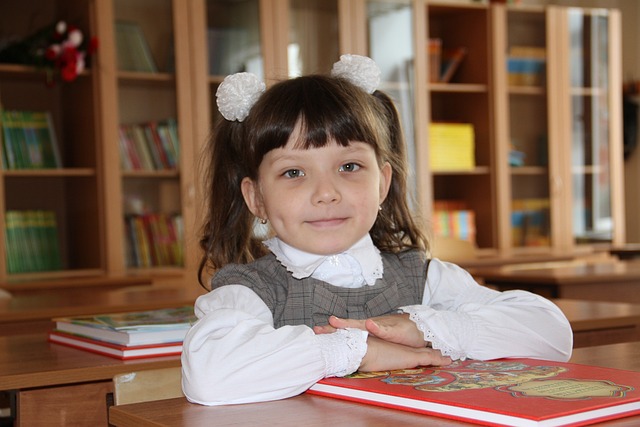
Promote Creativity and Reflection with First Day of School Writing Prompts
Encouraging self-expression: captivating writing prompts for the first day of school, building connections and fostering community through writing on the first day of school, empowering students: effective writing prompts to kickstart the school year, inspire confidence and growth with first day of school writing activities, setting goals and creating a positive classroom atmosphere with first day writing prompts, ignite imaginations: thought-provoking writing prompts for the start of the school year, frequently asked questions, future outlook.
Kickstart the new school year with a burst of creativity and encourage your students to reflect on their experiences with our collection of engaging writing prompts for the first day of school. Writing prompts provide an excellent way to inspire imagination, boost critical thinking skills, and foster self-expression. Whether you’re an educator or a parent, these prompts offer a perfect opportunity to encourage your students or children to articulate their thoughts, fears, and aspirations as they embark on a fresh academic journey.
Our carefully crafted prompts tap into a range of themes, from personal reflections to imaginative scenarios. Students can explore and express their emotions, goals, and ambitions for the upcoming year. They can also delve into their unique learning experiences, ponder new friendships, or even imagine exciting adventures they’d like to embark upon. With a diverse collection of thought-provoking prompts at your disposal, you’ll empower your students to think critically, write confidently, and develop their own individual voices.
- Encourage students to reflect on their favorite summer memories and share what they’ve learned from them.
- Prompt students to envision the perfect classroom atmosphere and describe what they believe will make it an ideal learning environment.
- Challenge students to compose a letter to their future selves, outlining their academic and personal goals for the year ahead.
- Ask students to create a fictional story about a time-traveling adventure that takes them to a historical event of their choice.
By incorporating these fun and thought-provoking writing prompts on the first day of school, you’ll not only cultivate creativity and self-reflection, but also set a positive tone for the rest of the academic year. Foster the development of critical writing skills, while simultaneously strengthening students’ ability to articulate their thoughts and feelings. Let your students embark on a writing journey filled with imagination, self-discovery, and endless possibilities.

As the new school year begins, it’s crucial to create a classroom environment that fosters creativity and self-expression. One effective way to achieve this is through engaging writing prompts that will encourage students to share their thoughts and ideas. Here are some captivating writing prompts that are perfect for the first day of school, allowing students to introduce themselves while also sparking their imagination:
- Reflect on your summer adventures: Ask students to write about their favorite summer memory or the most exciting thing they did during the break. This prompt not only helps them share their experiences but also sets a positive and vibrant tone for the class.
- Design your ideal learning space: Encourage students to let their creativity flow by asking them to describe or sketch their perfect learning environment. This prompt allows them to think outside the box and express their preferences, making them feel a sense of ownership in the classroom.
Writing prompts like these provide an opportunity for students to explore their individuality, establish a positive classroom community, and ignite their passion for learning. By creating a safe and inclusive space for self-expression from the very beginning, teachers can set the stage for meaningful and engaging discussions throughout the entire school year. So, let’s kickstart this academic adventure with captivating writing prompts that will inspire endless creativity in our students!
On the first day of school, bringing students together and creating a sense of community is essential. With a simple yet powerful activity using writing, we can foster connections right from the start. By encouraging students to express themselves through writing, we provide a platform for each individual to be heard and understood, while also establishing a supportive and inclusive classroom environment.
One effective way to do this is through an interactive journaling session. Set aside time for students to write freely about their thoughts, feelings, and expectations for the upcoming year. Encourage them to express their goals, hopes, and even concerns. By giving them the freedom to write openly and honestly, we can create a safe space where students feel comfortable sharing and connecting with their peers.
- Provide prompts that encourage self-reflection, such as asking students to write about their favorite book or about a challenge they overcame.
- Encourage students to respectfully comment and share their thoughts on each other’s writing, fostering dialogue and understanding.
- Consider using icebreaker activities that involve writing, such as having students write a short poem introducing themselves to their classmates.
By incorporating writing into the first day of school, we establish a foundation for building connections and fostering a supportive community. Writing encourages self-expression, empathy, active listening, and understanding. It enables students to share their unique voices and experiences, while also developing their reading and critical thinking skills. Let’s embrace the power of writing to create a classroom environment where everyone feels valued and connected.

Writing is an essential skill that allows students to express their thoughts, ideas, and emotions. It is crucial to provide students with engaging and effective writing prompts to ignite their creativity and boost their confidence as communicators. Here are some unique and inspiring writing prompts to kickstart the school year:
- 1. Reflect on a significant life experience: Encourage students to explore and share a personal experience that had a profound impact on their lives. This prompt not only allows them to tap into their emotions but also helps develop their narrative writing skills.
- 2. Invent a futuristic gadget: Challenge students to imagine a groundbreaking invention that would revolutionize the future. This prompt promotes critical thinking, creativity, and persuasive writing skills as they describe the gadget’s purpose and benefits.
- 3. Write a letter to your future self: Have students envision their lives five years from now and write a letter to their future selves. This prompt encourages reflection, goal-setting, and expository writing as they convey advice, hopes, and aspirations.
By incorporating these empowering writing prompts into the curriculum, students will be motivated to develop their writing skills while exploring their unique perspectives and ideas. These prompts not only provide a platform for self-expression but also foster creativity, critical thinking, and effective communication skills – essential for their personal and academic growth. Let the journey of writing begin!
The first day of school can be both exciting and nerve-wracking for students. To help ease their worries and foster a positive and growth-oriented mindset, incorporating writing activities into the day’s agenda can be a tremendous tool. These activities not only inspire confidence but also encourage self-expression and creativity.
One engaging writing activity is to have students create a “Letter to My Future Self.” Ask them to imagine themselves at the end of the school year and encourage them to write a letter to their future self, expressing their goals, hopes, and dreams. This activity helps students set intentions for the school year ahead, allowing them to visualize their growth and progress. To make it even more interactive, you can provide decorative materials like colorful pens, stickers, and post-it notes for students to personalize their letters.

Starting the school year off on the right foot is essential for building a positive classroom atmosphere and setting achievable goals. One effective way to accomplish this is by utilizing first day writing prompts. These prompts provide students with an opportunity to reflect on their strengths, interests, and aspirations, while also encouraging them to think about how they can contribute to a supportive and inclusive learning environment. By incorporating these prompts into your lesson plans, you can foster a sense of community, boost self-confidence, and create a positive classroom dynamic.
First day writing prompts can cover a diverse range of topics, such as personal experiences, academic goals, or even fun icebreaker questions. Here are a few ideas to get you started:
- “Describe a time when you felt proud of an accomplishment. What did you learn from that experience?”
- “What are your goals for this school year, both academically and personally? How do you plan to achieve them?”
- “Share an interesting fact about yourself that others might not know.”
Encourage students to express themselves freely and authentically. Remind them that there are no right or wrong answers, and that their responses will help shape the classroom environment. By allowing students to share their thoughts and insights, you can establish a foundation of trust and respect from day one, fostering a positive and inclusive atmosphere where everyone feels valued.

Welcome back, students! As we kick off the new school year, it’s time to get those creative gears turning with some thought-provoking writing prompts. These prompts will not only ignite your imaginations but also encourage you to explore new ideas, challenge your thinking, and develop your writing skills. Get ready to embark on an exciting journey of self-expression and discovery!
1. Reflective Prompts:
- Describe a time when you overcame a difficult challenge and what you learned from it.
- Imagine you are a character in your favorite novel. Rewrite the ending, exploring an alternate outcome.
- Think about a personal accomplishment you are proud of. Explain why it is important to you and how it has shaped you.
2. Imaginative Prompts:
- Transport yourself to a futuristic world and write a short story about how society has drastically changed.
- Create a conversation between two inanimate objects. What would they talk about?
- If you could possess any superpower, what would it be and how would you use it to make the world a better place?
Remember, writing is not just about grammar and punctuation; it’s about expressing your thoughts, emotions, and unique perspective. Use these prompts as a springboard to showcase your creativity and engage in meaningful self-reflection. Let your imagination roam free and allow your words to paint vibrant pictures on the canvas of paper. Get ready to embark on a captivating writing journey this school year!
Q: What are some first day of school writing prompts? A: Some first day of school writing prompts include: – Describe your summer vacation in 5 words. – Write a letter to your future self. What do you hope to achieve this school year? – If you were a teacher for a day, what would you do differently? – Imagine you could create a new subject for your school. What would it be and why? – Reflect on a time when you overcame a challenge. How did it make you feel?
Q: Why are first day of school writing prompts important? A: First day of school writing prompts are important because they encourage students to start the year off with creative thinking and self-reflection. They help to establish a positive and engaging classroom atmosphere, allowing students to express their thoughts and ideas freely.
Q: How can writing prompts benefit students on their first day? A: Writing prompts benefit students on their first day by creating a sense of excitement and curiosity about the upcoming school year. They also allow educators to gain insight into their students’ interests, personalities, and writing abilities early on, helping to shape their instruction and meet individual student needs.
Q: Will students enjoy writing on their first day of school? A: Generally, students do enjoy writing on their first day of school, as it gives them an opportunity to express themselves creatively and share their experiences. It breaks the ice and helps build a positive classroom environment where students feel comfortable sharing their thoughts and ideas.
Q: How can teachers use first day writing prompts in the classroom? A: Teachers can use first day writing prompts in various ways. They can start the day with a short writing activity to engage students as they enter the classroom. Teachers can also assign longer writing tasks, encouraging students to share their work with classmates and engage in peer feedback. Additionally, these prompts can be used as a resource throughout the year, inspiring writing assignments or fueling classroom discussions.
Q: Are there any benefits of using writing prompts beyond the first day of school? A: Absolutely! Writing prompts are a versatile tool that can be used throughout the year. They promote critical thinking, creativity, and help develop students’ writing skills. Writing prompts can also serve as catalysts for classroom discussions, allowing students to explore various topics in depth and express their ideas confidently.
Q: Can writing prompts be adjusted for different grade levels? A: Yes, writing prompts can be adjusted to suit different grade levels. For younger students, prompts can be more visual or involve drawing pictures alongside the writing. Older students may be given more complex prompts that require synthesizing information or analyzing concepts. Teachers can adapt the level of difficulty based on the specific needs and abilities of their students.
Q: How can teachers make writing prompts more engaging for students? A: To ensure writing prompts are engaging for students, teachers can make them relevant to their lives and experiences. They can incorporate current events , popular culture references, or allow students to choose their own writing topics. Additionally, providing clear instructions, creative examples, and opportunities for peer collaboration can make the writing process more enjoyable for students.
In conclusion, using writing prompts on the first day of school is a great way to engage students and kickstart their creativity for the year ahead.
Penguin Writing Prompts: Explore Tales of Antarctic Adventures
Virginia SOL Writing Prompts: Prepare for State Assessments
Leave a Comment Cancel reply
Save my name, email, and website in this browser for the next time I comment.
Reach out to us for sponsorship opportunities.
Welcome to Creative Writing Prompts
At Creative Writing Prompts, we believe in the power of words to shape worlds. Our platform is a sanctuary for aspiring writers, seasoned wordsmiths, and everyone. Here, storytelling finds its home, and your creative journey begins its captivating voyage.
© 2024 Creativewriting-prompts.com
- Writing Prompts
56 Back To School Writing Prompts (+ Free Printable)
I bet the last thing your child wants to do when going back to school is writing (or more homework as they’ll say)! Not to worry we have come up with 56 back-to-school writing prompts that will help your child settle in and take away those first-day fears. We all know how the first day of school is daunting for most kids, that’s why it is important to slowly prepare your kids for the back-to-school routine. One way to support your child is to encourage them to write down their feelings in a journal or notebook. Getting your child to think about school before actually going will help to prepare for any challenges or fears they might have. We have specially created these writing prompts to not only prepare your child for going back to school but also to help them with their writing skills.
56 back-to-school writing prompts
Get ready to go back to school with these back-to-school writing prompts:
- How do you feel about going back to school? What are your top 5 fears and what 5 things are you excited about?
- Write about the best thing that happened to you during the summer holidays. You can talk about this with your friends when you go back to school.
- What was the worst part of your summer holidays?
- What one thing did you learn during the summer holidays and how did you learn it?
- What school subject are you most looking forward to? What do you like about this subject?
- What subject are your least excited about and why?
- Do you want to make new friends in the new school term? How would you go about making friends? List a few points to help you or someone else.
- What is your goal for the new school year? What would you like to achieve by the next summer holidays? Write down at least 3 goals.
- How would you better organise your time this school year, so you can complete all your assignments on time and have time to do things you enjoy?
- Do you want to join any after-school or lunchtime clubs this year? Which clubs would you like to join or would you create your own?
- What 3 things would you improve or change about yourself this year?
- What 3 things would you keep the same about yourself and will carry on doing this year?
- Which part of the school year are you most looking forward to?
- Imagine your dream teacher. What would they look like? How would they speak? What personality traits would they have?
- What was the best thing that happened to year last school year? Describe this moment in detail.
- What was the biggest thing you struggled with last school year? And how do you plan on improving on this issue this year?
- Which subject did you find the hardest last year, and why? How can you get better at this subject this school year?
- Make a list of your favourite teachers from the last school year. Next to their names, write down at least one reason why they are your favourite.
- Make a top ten list of your favourite school subjects. One is your favourite and ten is your least favourite.
- Write a day in the life story of a typical day for your head teacher at your school.
- Make a top ten list of your favourite school meals to eat at lunchtime.
- Create a packing list of everything you need to pack in your backpack for the first day of school.
- Create a how-to guide on how to walk or travel to school safely.
- Create a character profile for the perfect friend. What personality traits would this person have? What about their interest and appearance?
- If you were the head teacher of your school. What new rules would you put in place for the new school year? Try to think of at least three rules.
- Complete the following sentence in three different ways: I can’t wait to start school because…
- Write a letter to a classmate that you have never spoken to before. You can ask about their interests and what they did over the summer holidays.
- Would you rather be the most popular kid in your school year or get straight A’s this school year?
- Write a how-to guide on dealing with bullies at school.
- Write down 10 tips on how to study for a pop quiz or test.
- Write down a journal entry for your first day back in school. What were the highs of the day? What were the lows of the day?
- Continue the following story starter: On my way to school, I heard a strange noise. I turned around and saw…
- On a scale of 1 to 10, how do you feel about going back to school? One being really scared or worried and 10 being very excited. Explain your answer.
- What is your dream school trip? Where would you really want to go this year?
- Write down at least 5 reasons why school is important.
- If you could create a new school club what would it be and why?
- If you could get rid of one subject at school, which subject would it be and why?
- Write a day in the life story of a typical day as a student at your school.
- Write a haiku poem about your first day at school.
- Write a limerick poem about a boy or girl who hates school. You can start the poem using this sentence: There once was a boy/girl who hated school
- Would you rather be home-schooled or go to a public school? Explain your choice.
- Imagine you are back in school for the first time in a few years. How would you feel? What would you say to your friends and teachers?
- Write a letter to your younger self from about 5 years ago telling them about school. What advice with you give your younger self and why?
- What is the worst thing you have done in school? Why did you do it? What will you do to make sure this does not happen again?
- Write a letter to your favourite teacher. Tell them what you are looking forward to this year and how you would like to improve.
- What would your dream school uniform look like? What would you want to wear? Try drawing a picture and writing a detailed description.
- Imagine that your head teacher asks you for some new school subject ideas. What new subject do you wish was taught in school, and why?
- What is one way that you can make your school feel more like a home to you?
- How would you feel if you received a failing grade in a subject at school? What steps would you take to improve your grade?
- Imagine you are a teacher and you have to choose 5 students from your class to be on a TV talent show. What five students would you choose, and what would their talent be?
- Imagine that your school head teacher is looking for a new school mascot. What would this mascot look like? Can you describe them in detail?
- Write a poem dedicated to your favourite teacher.
- Imagine you are a teacher and you want to write a letter to a child about a problem they have had. What do you say in the letter?
- Write a song about the best school lesson you have ever had.
- Imagine you are in charge of the school budget this year. What would you spend most of your money on and why?
- Create a snappy slogan or motto for your school. A motto is a short sentence that summarises the beliefs of your school in a powerful and engaging way.
Download your free printable back-to-school writing prompts pack!
Any tips for helping your child with going back to school?
What back-to-school routines do you have for helping your child when comes to their first day back? Let us know your ideas and thoughts in the comments below. If your child is particularly anxious about going back to school, take a look at these 12 hilarious back to school picture books .
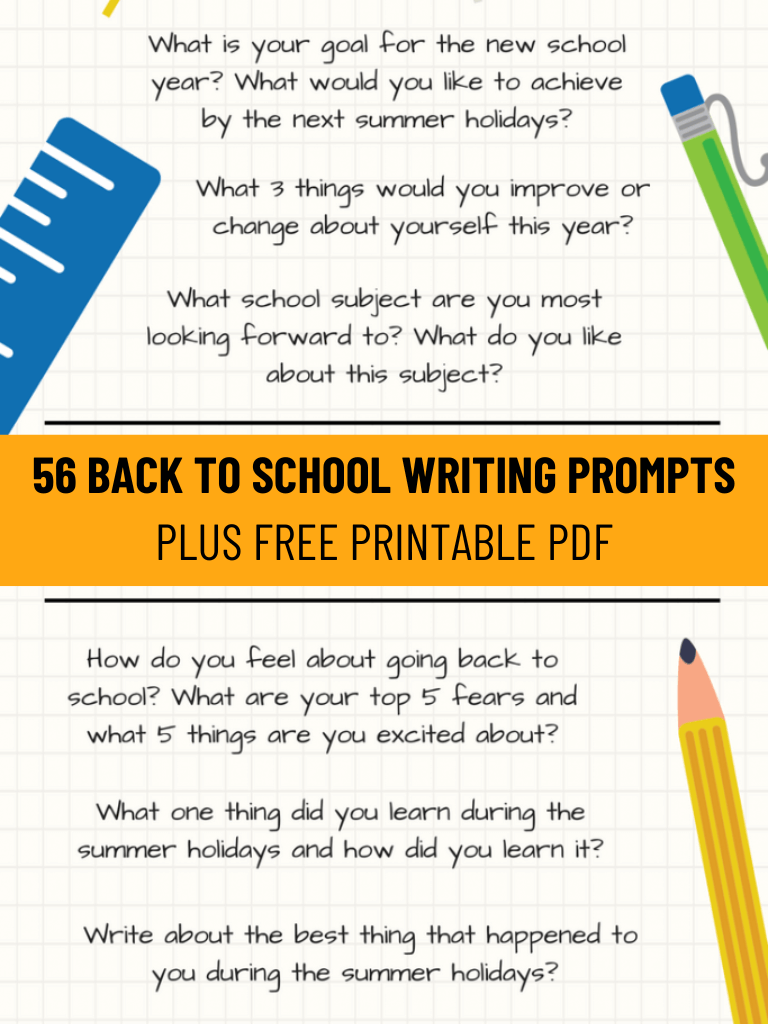
Marty the wizard is the master of Imagine Forest. When he's not reading a ton of books or writing some of his own tales, he loves to be surrounded by the magical creatures that live in Imagine Forest. While living in his tree house he has devoted his time to helping children around the world with their writing skills and creativity.
Related Posts

Comments loading...
First Day Of School Journal Prompts

💾 Print or download a free PDF copy of this page:

Jumpstart the school year with our "first day of school journal prompts". Unleash your child's creativity and enhance their writing skills with these engaging and insightful prompts, designed to make school beginnings exciting.
Attending the first day of school every year is a whirlwind of emotions and experiences. Turning these moments into words can be a cathartic and enriching process. Journaling about it not only helps to capture these memories but also fosters creativity and improves writing skills.
In this article, we’ll be sharing a trove of first day of school journal prompts that will guide your writing journey. Whether you’re a student looking to record your experiences, a teacher intending to encourage classroom activity, or a parent wishing to engage your child in meaningful dialogue, our expertly-curated list of prompts is here to inspire you.
So, sharpen your pencils, open your journal, and let’s embark together on this exciting journey of capturing those first-day-of-school moments. 💼📚
Reflecting On Summer Vacation
Reflecting on Summer Vacation allows students to look back on their experiences, unwind their thoughts, and record memorable moments before jumping back into the academic year. Here are 20 journal prompts to inspire reflection on Summer Vacation:
- Describe the most exciting experience you had this summer.
- Recount a day when you felt incredibly relaxed.
- Write about an unexpected adventure or event that happened.
- Describe the tastiest food or meal you tried over the summer.
- Write about a moment where you felt proud of yourself.
- List three new places you visited and what you loved about each one.
- Write about a book you read this summer that inspired you.
- Reflect on something new you learned about yourself.
- Describe a memorable interaction with a person you met or spent time with.
- Write about a challenge you faced and how you overcame it.
- Recount a fun tradition or recurring event over the summer.
- Reflect on a happened event that influenced your view on some things.
- Describe a beautiful scene you witnessed in nature.
- Write about a moment this summer when you missed school and why.
- List three things you wish you had the opportunity to do but didn't.
- Reflect on the goals you set at the start of the summer and whether you achieved them.
- Write about a project or activity you undertook that made you happy.
- Describe a habit you developed this summer that you would like to keep during school.
- Write about something unexpected that surprised you.
- Reflect on the most important lesson you learned this summer and how it will help you in the upcoming school year.
Sharing Goals For The New School Year
Sharing Goals for the New School Year through journal prompts encourages students to set ambitions and express aspirations, helping them start the academic term with clarity and purpose. Here are 20 writing prompts that center around sharing goals for the coming academic year:
- Write down your main goal for this school year and explain why it is important to you.
- Recall a goal you achieved last year and describe how you felt when you achieved it.
- List three steps you can take to achieve your main goal.
- Write about a skill you want to improve this school year.
- Picture yourself on the last day of this school year. What would you like to have accomplished?
- Describe an academic obstacle that you would like to overcome this school year.
- Write down a goal related to your favorite subject. Why is this goal significant to you?
- If you could learn anything this year, what would it be?
- Write about a personal growth goal for the school year.
- Write a letter to your future self about the goals you wish to achieve.
- Describe what success looks like to you by the end of this school year.
- What hobby or extra-curricular activity would you like to pursue or excel at this year?
- List down three habits you want to cultivate this school year to help you achieve your goals.
- Write about a book or topic you'd like to explore further this year.
- Describe a goal that involves your friends or classmates.
- Write down a goal related to a subject or topic you find challenging.
- What change would you like to see in your school life this year?
- Describe a new experience or activity you want to try this school year.
- Write down a goal that scares you a little. Why does it scare you, and why do you want to achieve it?
- How can achieving your school year goals make you a better person?
Introducing Yourself
The concept of "Introducing Yourself" gives you a chance to share about your hobbies, interests, family, and goals with a new set of glassmates on the first day of school through creative journal writing. Below are 20 journal prompts that will inspire you to break the ice and show your personality openly and honestly:
- Start by penning down your full name, and describe what it means to you.
- Write about where you were born and raised.
- Share your favorite hobbies and why you enjoy them.
- Create a list of your favorite books and movies. State why you connect with them.
- Detail your summer vacations, specifically what you loved about the experience.
- Describe your favorite school subject and why it fascinates you.
- Write about your closest friend and how you met.
- Share a story about a memorable family tradition.
- Detail your dream job and why you aspire to it.
- Write about your most cherished memory and what makes it special.
- Express what stresses you out, and how you cope with stress.
- Create a list of things you want to accomplish this school year.
- Share a personal goal and what steps you plan to take to achieve it.
- Write about your favorite meal and describe why it’s your favorite.
- Share an interesting fact or story about your hometown.
- Write about an accomplishment you're proud of and why.
- Share your favorite song or band, and why their music speaks to you.
- Pen down your favorite quote or saying, and explain why it inspires you.
- Write about a challenge you’ve faced and how you overcame it.
- Finish by sharing your hopes for this school year and what you're looking forward to.
Hopes And Anxieties
Hopes and anxieties are common feelings surrounding the first day of school, and journaling can provide a healthy and productive outlet to explore these emotions. To guide your writing, consider the following 20 prompts about hopes and anxieties:
- Write about one hope and one fear related to meeting new people.
- Describe how you want to present yourself on your first day.
- Create a list of activities you are looking forward to this school year.
- Discuss a time when a fear you had about school turned out to be unfounded.
- What are your three biggest concerns about the upcoming school year?
- Imagine it's the end of the school year. What achievements do you hope to have accomplished?
- How would you handle a situation in which you felt left out or isolated?
- Write a letter to your future self about your hopes for this school year.
- Visualize an ideal school day. What happens?
- Document your feelings about maintaining your grades this year.
- Discuss your feelings towards meeting your new teacher or teachers.
- What are some strategies you could employ if you start to feel overwhelmed?
- Illustrate how you hope to balance school, extracurriculars, and personal life.
- Describe a potential situation that makes you anxious, and how you would deal with it.
- Write a list of personal goals for this academic year.
- Imagine a conversation with a new friend you hope to make.
- Discuss any anxiety you feel about leaving behind an old school or class.
- What are some steps you can take if school becomes too stressful?
- Describe a character strength you hope to further develop this school year.
- Write about any worries you have regarding academic or social pressures.
Expectations For The First Day
Settling into the dynamics of a new routine on the first day of school can be both scary and exciting. Here are 20 journal prompts about your expectations for the first day:
- Write about three things that you are most excited about for the first day.
- List five of your worries about your first day of school.
- Pen down your plan of action if your day starts going off-track.
- Imagine the best case scenario for your first day. What does it look like?
- Consider the worst case scenario for your first day. How would you respond to it?
- Describe your ideal first impression on your new teacher and class mates.
- Write about one personal goal you want to achieve on your first day.
- Think about what kind of student you want to be known as. Why?
- Contemplate on the biggest challenge you may face on your first day, and how you'd overcome it.
- Write about the type of classroom environment you hope to encounter.
- Reflect on a lesson your previous school term taught you that you'll use on your first day.
- Write about the qualities you are looking for in a new friend.
- Describe your thoughts about riding the school bus for the first time/again.
- Reflect on your feelings about having lunch in a new cafeteria/with new people.
- Jot down your thoughts on adapting to a new learning style.
- List three things that you're nervous about and how you plan to handle these feelings.
- Write down what you expect the most challenging subject will be, and why.
- Describe any personal strengths or talents you'd like to bring into the classroom.
- Share your expectations about after-school activities.
- Reflect on your hopes for achieving a good work-life balance during the new term.
Teacher Impressions
Recording our first impressions of our new teachers helps to remember our initial reactions and feelings about our new academic year. Here are 20 writing prompts centered around Teacher Impressions:
- Write about your new teacher's appearance.
- Note down the first words your teacher said to the class.
- How did the teacher make you feel when you first saw them?
- Describe the teacher's demeanor during the first class.
- Share any unique teaching method you noticed on the first day.
- Highlight one thing the teacher said that sparked your interest.
- Did the teacher begin the class with a story or an anecdote? Write it down.
- How did your teacher react to the students' questions or responses?
- What are three expectations your teacher set for the class?
- What subject does the teacher seem most enthusiastic about teaching?
- Write a note about any special materials or tools the teacher uses.
- If you had to describe your teacher in one word, what would it be and why?
- Did your teacher give any advice or life lessons on the first day? What were they?
- What is one thing you think you are going to enjoy in this teacher's class?
- Are there any classroom rules that your teacher insisted upon?
- How does this teacher's style compare to last year's teacher?
- Is there anything about the teacher's approach that you think you might find challenging?
- Share your thoughts on the teacher's classroom layout or organization.
- Did your teacher mention a favorite book or author? Who was it?
- Write about your hopes of what you want to learn from this teacher this year.
New Classroom Environment
Exploring the new classroom environment through journaling can help students adjust, observe, and appreciate their surroundings, and it also plays a crucial role in cultivating their sense of belonging and comfort in their new learning space. Here are 20 prompts that focus on the new classroom environment:
- Write about your first impressions of your new classroom. What caught your eye immediately?
- Illustrate a map of your new classroom. Label the different areas and what they're used for.
- Pen down three things that you like about your new classroom.
- Write about any fears or concerns you have about the new classroom.
- Compare your new classroom to the last one, citing at least three differences.
- Write a short note to your teacher suggesting an improvement to the classroom environment.
- Describe a part of your classroom that makes you feel comfortable and why.
- Write about any unique or interesting features of your new classroom.
- In your view, what could make the environment in this classroom more conducive for learning?
- What is something you would like to change about your new classroom, and why?
- How would you describe the "vibe" or atmosphere of the new classroom?
- Write about one place in the classroom you look forward to exploring or using.
- What does your new classroom tell you about your teacher or the school in general?
- Imagine you could add one thing to your classroom, what would it be and why?
- Describe how you organize your own workstation in the classroom.
- Write a thank you note to someone who helped you get comfortable in the new classroom.
- Pen your thoughts about the role of a classroom in your learning.
- Write about a classroom rule you do not understand and why.
- Describe how you found your seat on the first day and who sits next to you.
- Write about ways you would personalize your corner of the new classroom if given a chance.
First Day Friendships
First Day Friendships are the initial connections or interactions made during the first day of school that often help shape a student's early school experience. Here are 20 journal prompts about First Day Friendships:
- Write about the first classmate you met on the first day. What was your initial impression of them?
- Create a dialogue of how you introduced yourself to a new classmate.
- Describe the moment you found a friend on the first day.
- Jot down three qualities you would like in a new school friend.
- Imagine a day spent with your new first-day friend, what would you do together?
- Reflect on any initial challenges you faced while trying to make new friends.
- Write about someone who helped you feel welcome on the first day.
- Explore a funny or embarrassing moment you shared with your new friends.
- Detail a random act of kindness you witnessed between two classmates on the first day.
- Write a short letter to your future self about the friendships you hope to keep throughout the year.
- Describe someone who made your first day of school more enjoyable.
- List three things you learnt about your new friend on the first day.
- Write about a group activity that helped you interact with others.
- Share your first impressions of your classmates and what drew you to your new friends.
- Consider a highlight of your first school day shared with a friend.
- Detail the common interests you and your new friend discovered on the first day.
- Record any apprehensions you had about making new friends on the first day and how you overcame them.
- Write a thank you note to a classmate who made your day less stressful.
- Discuss how friendships formed on the first day could change your school experience.
- Reflect on your hopes for these new friendships as the school year progresses.
Favorite Summer Moments
Reflecting on Favorite Summer Moments through first day of school journal prompts enables the re-living of joyful experiences and the expression of gratitude, enriching our writing and fostering positivity. Below are 20 prompts to guide you in recalling your Favorite Summer Moments:
- Describe your most memorable day during the summer. What made it special?
- Which person did you spend the most time with and why did you enjoy their company?
- Write about a new place you visited this summer.
- Share a funny incident that happened during the summer.
- Reflect on something you learned about yourself during the summer break.
- Write about a favorite meal or treat you enjoyed during the summer.
- Describe a moment of luck or surprise you experienced.
- If you could relive one day from the summer, which day would you choose and why?
- Jot down a list of three things you are grateful for from this past summer.
- Describe the connection between a song or book you enjoyed and an event from the summer.
- Write about an outdoor activity or adventure you embarked upon.
- Share about a stranger you remember and the impact they had on you.
- Write about an achievement, accomplishment or milestone reached this summer.
- Describe the most beautiful sunset you watched this summer.
- Write about your best beach or pool experience.
- Share about a summer project or hobby you started or finished.
- Recall a day you spent totally unplanned – what did you enjoy about it?
- Describe a challenge you faced and how you handled it.
- Reflect on a conversation from the summer that's stayed with you.
- Write about how your pets or animals you encountered added joy to your summer.
Early School Year Predictions
"Early School Year Predictions" is a captivating segment of first day of school journal prompts, fostering anticipation for the coming year and setting personal performance goals. Here are 20 interesting writing prompts to explore this topic:
- Illustrate what you think might be the most challenging subject this year and how you plan to tackle it.
- Write about a new skill you wish to acquire by the end of this school year.
- What is one thing you hope to achieve socially in your class this year?
- Jot down how you envision your ideal study space to boost productivity.
- Predict a challenge you might face with your classmates and how you could address it.
- Contemplate on an extracurricular activity you're excited to pursue this school year.
- Describe your vision of a perfect school day.
- Propose a technique you plan to implement to improve time management this year.
- List five objectives you want to reach by the end of the school year.
- Document some academic milestones you hope to reach this term.
- Write about which subjects you think you will excel at this year.
- Visualize what your report card might look like at the end of the school year.
- Envisage the new friendships you hope to form this school year.
- Design a plan to balance school work and personal life effectively.
- Pen your thoughts on what change you would like to see in your school this year.
- Describe the steps you plan to take to achieve your highest grade.
- Define what success means to you for this upcoming school year.
- Envision the impact your favorite subject will have on your future career.
- Identify a weakness you want to overcome this school year.
- Picture a school trip or event you're curious and excited to experience this year.
Setting Academic Goals
Delving into setting academic goals through journaling can encourage a sense of purpose and direction, fostering a proactive approach towards education. Here are 20 writing prompts that can guide you in articulating and refining your academic goals:
- Write down a major academic goal you want to achieve this school year.
- Detail the actions you will take to accomplish this goal.
- Reflect on an academic goal you achieved last year. How did you feel?
- Describe an academic hurdle and how you intend to overcome it.
- List three strategies you plan to use to maintain focus on your goals.
- Envision where you see yourself acadically at the end of the school year.
- Write down a goal that seems difficult to achieve. Break it down into smaller goals.
- Describe a subject or topic you want to improve in and a goal to achieve that.
- Reflect on a goal that seems easy to achieve. How would achieving it make you feel?
- Write a letter to your future self about your hopes for the school year.
- Describe a person who inspires you academically. What qualities do they have that you aspire to develop?
- List steps you will take when you feel overwhelmed by your academic responsibilities.
- Write about how achieving your academic goals will contribute to your overall life goals.
- Reflect on a time when you didn’t meet your academic goals. What did you learn?
- Describe a study habit you want to develop to help you achieve your goals.
- Create a timeline for important tasks related to achieving your academic goals.
- Reflect on what motivates you to maintain perseverance when striving to achieve your academic goals.
- Write about the potential obstacles to your academic goals and ways to address them.
- Describe how you plan to celebrate when you achieve your academic goals.
- Write a gratitude note to yourself for the progress you will make in achieving your academic goals.
Meeting New People
Meeting new people is an integral part of the first day of school experience, offering opportunities for students to forge connections, learn about diverse backgrounds, and foster empathy and understanding. Here are 20 writing prompts that delve into the realm of meeting new people:
- Write about your first impression of your new seatmate.
- Describe in detail the new friend you made.
- Write a letter to a new classmate telling them what you'd like them to know about you.
- Reflect on a conversation with someone who has a very different background from you.
- What was something intriguing you learnt about a new acquaintance?
- Discuss your thoughts on the newly introduced teacher's methods or demeanor.
- What was the most interesting introduction given by a new classmate?
- Write about what stood out about a new person you met today.
- Imagine a conversation you could have with a new friend next week.
- List the unique qualities you observed in three new people you met.
- Describe a surprise interaction you had with a new person.
- Tell a short story of a meaningful interaction you had with a new classmate.
- Write from the perspective of a new classmate meeting you for the first time.
- What made you feel connected with a new person you met today?
- Think about a question you wish you had asked a new friend or teacher.
- Pen down your thoughts on the diversity in your new class or school.
- Describe a funny encounter you had with someone new.
- Write about the moment you realized you made a new friend today.
- Reflect on a scenario where you felt misunderstood by a new acquaintance.
- Describe what you might have in common with a new classmate, based on your first impressions.
Finding Extracurricular Interests
Exploring extracurricular interests through journaling can provide an avenue to discover new passions and hobbies, broadening personal enrichment and joy. Launch your discovery with these 20 writing prompts centered around finding extracurricular interests:
- List five extracurricular activities you have tried before and note what you liked or disliked about each.
- Discuss an extracurricular activity you have always wanted to try and how you feel about eventually pursuing it.
- Write about your dream hobby or interest, however unattainable it may seem.
- Consider a hobby or interest that may challenge you. Write about what you find compelling about it.
- Write a letter to your future self about an extracurricular interest you hope to be proficient in.
- Describe an experience where you tried a new hobby and it didn't work out. What lessons did you learn from this?
- Detail a day in the life of a professional in the field of an extracurricular interest you admire.
- Imagine you could instantly obtain any skill necessary for an extracurricular activity. What skill would you choose and why?
- Write about an extracurricular activity you believe can help you in your daily life or future career.
- List three people who inspire you with their extracurricular pursuits and discuss why.
- Create a plan of action for getting involved in a new hobby or interest you've always wanted to try.
- Consider a hobby or interest you've abandoned in the past. Why did you give it up and would you ever consider picking it up again?
- Write a dialogue between yourself and a friend, discussing your favorite hobbies and why you enjoy them.
- Describe a time when you felt proud about an achievement in an extracurricular activity.
- Detail any barriers or challenges that might be preventing you from pursuing a specific extracurricular interest and brainstorm solutions.
- Imagine if financial and time constraints were non-existent. What hobby or interest would you pursue?
- Write about an extracurricular interest you would like to share with your friends or family.
- Think of a person you know who is deeply passionate about their hobby. Write about what draws you to their enthusiasm.
- Describe an extracurricular activity that made a significant impact on your life.
- Reflect on an extracurricular achievement you hope to reach by the end of the school year.
Planning School Lunches
Planning school lunches within the scope of first day of school journal prompts encourages kids to express their thoughts and preferences about their meals while simultaneously enhancing their decision-making and planning skills. Here are 20 journal prompts related to planning school lunches:
- Write down what your ideal school lunch would look like. Include a main dish, two sides, and a drink.
- How would you make your current school lunch healthier?
- Describe your favorite school lunch from last year. What made it your favorite?
- If you were in charge of the school cafeteria for a day, what meals would you serve?
- Write about a school lunch you've had that you never want to eat again. Why was it so unappealing to you?
- If you had to pack a lunch for a classmate, what would you prepare and why?
- Think about a time when you shared your lunch with a friend. How did that experience make you feel?
- Reflect on a day where you forgot your lunch or didn't have one. How did you manage?
- Design a perfect 'theme' lunch – everything from the food to the packaging matches a particular theme.
- Write about your favorite lunchtime memory at school.
- List three snacks you would love to see in your lunchbox every day.
- Describe a foreign meal you've never tried but would like to include in your school lunch.
- Record a week's worth of school lunch menus you would enjoy.
- Write about why it’s important to have a balanced and nutritious school lunch.
- If you could choose to eat lunch with anyone in the world, who would it be and what would you serve?
- Describe what the atmosphere is like during lunchtime at school.
- Imagine you're a chef for a day, what kind of innovative lunch meal would you create for students?
- Write about your thoughts when opening a lunchbox packed by someone else.
- If you could update the school's lunch policy, what changes would you suggest?
- Document your feelings before and after having a good lunch at school.
Personal School Memories
Reflecting on Personal School Memories in the context of first day of school journal prompts allows us to explore and relive the unique experiences and feelings associated with these important milestones. Below are 20 journal prompts that aim at stimulating your memories of personal school experiences:
- Write about your most memorable first day of school. What made it stand out?
- Describe how you felt on your first day of high school.
- Recall your first school bus ride. What can you remember about that journey?
- What was the first lunch you brought or bought at school? Why do you remember it?
- Describe your favourite first day of school outfit and why you chose it.
- Write about a friend you made on your first day of school. Are you still friends with them?
- Detail your earliest memory of a school playground or recess time.
- Who was your first teacher, and what impact did they have on your school journey?
- Describe your reaction when you first saw your school building. What impressions did it leave?
- What is the most embarrassing memory you have from the first day at school?
- Reflect on some of your school traditions. Which one do you remember from your first day?
- Describe the feeling when you had to say goodbye to your parents on the first day of school.
- Write about the first time you felt really proud of an achievement at school.
- How did you feel at the end of your first day at school? Were your feelings different from the start of the day?
- Detail one instance from your first day of school that you would change if you could go back. Why?
- Write about a funny incident that happened on your first day at school.
- Describe the first classroom you sat in. What was it like?
- Reflect on a first day of school tradition you wish your school had implemented.
- Describe your emotions before and after your first day at the new grade.
- Reflect on how your first day of school experiences shaped your perception of education.
Back To School Shopping
Back to school shopping is an essential part of preparing for the first day of school, providing an opportunity to write about anticipations, worries, and excitement. Here are 20 journal prompts regarding this topic:
- Detail the list of items you need to buy for the new academic year.
- Write about the excitement of shopping for new school supplies.
- Describe how you feel when you choose your first day of school outfit.
- What is your favorite item you purchased during back to school shopping and why?
- Compare your preferences for school supplies this year to those of last year.
- Write about the frustrations you encounter during back to school shopping.
- Describe the planning process for back to school shopping. How do you prioritize what to buy?
- Write about the experience of shopping with your friends or family for school supplies.
- Imagine an ideal shopping trip for school supplies. What does it look like?
- Discuss whether you prefer online or in-store shopping for school supplies and why.
- Narrate a funny or surprising incident that happened during previous back to school shopping.
- Record your thoughts on seeing new backpacks, lunchboxes, or school uniforms in the store.
- What do the new items you purchased for school say about you as a student?
- Document the financial aspect of back to school shopping. How do you or your family budget for it?
- Write about your thoughts on reusing last year's supplies or clothes.
- Draft a dialogue that might occur during your shopping expedition for school supplies.
- Describe the feeling of tagging and labeling your new school items.
- Record your thoughts when you see the back to school section in the stores for the first time.
- Explain how back to school shopping contributes to your readiness for the new academic year.
- Write about your thoughts on the transition from summer to school facilitated by back to school shopping.
Understanding New Lessons
Delving into new lessons on the first day of school through journaling encourages adaptability and comprehension skills, aiding academic and personal growth. Below are 20 prompts related to understanding new lessons:
- Write about one lesson you are excited to learn this year. Why does it interest you?
- Journal about any anxieties you have concerning a subject you'll be studying.
- Record your initial thoughts on your first math lesson of the year.
- Describe your feelings about your first language or literature lesson.
- What did you find challenging about your science lesson today, and how do you intend to cope with it?
- Write about the most surprising thing you learned in your history lesson today.
- Detail what you found enjoyable about your first art lesson of the year.
- Discuss your expectations for a new subject you're taking up this year.
- Note down any questions you have after your first geography lesson of the school year.
- What strategies can you adopt to understand your lessons thoroughly?
- Write about one lesson you think will be difficult and why.
- Describe a moment from your first PE lesson that you found exciting or challenging.
- Share your thoughts on a new topic introduced in your social studies class today.
- Detail your first impressions about your teacher’s style of introducing new lessons.
- Write about a lesson today that you feel you grasped quickly. Why do you think this was the case?
- Journal about a new idea you encountered in your first philosophy or ethics lesson.
- Write down three things you aim to improve in order to understand your lessons better.
- Share your first thoughts about a new concept introduced in your computer class.
- Describe your experience of group work or discussions during your first lessons.
- Based on the first day, how confident do you feel about understanding your school lessons this year and why?
Organizing School Supplies
Organizing school supplies is a practical yet creative task that can serve as a cornerstone for several exciting first day of school journal prompts. Here are 20 prompts related to the world of pencils, notebooks, crayons, and book bags:
- Describe the school supplies you can’t wait to use and why they excite you.
- Pen down your thoughts about the smell of new notebooks and its effect on you.
- How do you plan to decorate and personalize your school supplies?
- Write about the feelings that the act of organizing school supplies evokes in you.
- Imagine a scenario where your school supplies come to life. What would they say?
- Think about the messiest desk you've ever seen. How would you organize it?
- Describe your ideal workspace for homework and studying.
- Write a story based on the perspective of a lonely eraser left in your school bag.
- What are some creative ways you can reuse or recycle old school supplies?
- If you could invent a new school supply, what would it be and why?
- Describe the sensation of writing with a brand-new pen for the first time.
- Think about your favorite color of crayon or marker. Write about why you love it.
- How do you feel when a pencil breaks or a pen runs out of ink?
- Envision a world without any school supplies. How would school work change?
- Detail a day in the life of a backpack during the school year.
- Write about a time you lent a school supply to a friend. How did you feel?
- Discuss different ways of organizing supplies and your preferred method.
- Imagine your school supplies were magic. What special powers would they have?
- How do you feel about sharing your school supplies with others?
- If your schoolbag could talk about its contents, what would it say?
Describing Your First Day Outfit
Understanding and reflecting on your First Day Outfit describes an essential aspect of your first day of school, articulating more than just outward appearance, but also attitudes, feelings, and self-perception. Here are 20 journal prompts on Describing Your First Day Outfit:
- Draw or describe in detail what you wore on your first day of school.
- Explain why you chose this outfit for the first day of school?
- Did your outfit reflect your mood or attitude towards the first day? Elaborate.
- What part of your outfit did you like the most and why?
- Was your outfit comfortable or was it chosen purely for style? Discuss.
- Were there any accessories you wore? Why did you pick these?
- Did your outfit instill confidence in you?
- Did you receive any compliments or comments about your outfit? Describe how they made you feel.
- Was your outfit inspired by a certain fashion trend or style? For instance, casual, sporty, or formal?
- Did the weather have any effect on the outfit you chose?
- Were you worried about what others might think of your outfit?
- If you could change one thing about your outfit, what would it be and why?
- Was there a color theme in your outfit? What is the significance of this color to you?
- What's your favorite memory associated with this outfit from the first day of school?
- Did anyone wear a similar outfit? How did you feel about that?
- Write about how you felt while getting dressed.
- Describe your thought process while picking this outfit.
- Did you plan your outfit or was it a last-minute decision? Why?
- If this outfit could talk, what would it say about you?
- Looking back, how has your style evolved since this first day of school outfit?
Navigating Through The School Building
Navigating the school building on the first day can be a daunting experience packed with emotions, observations and discoveries, making it a rich topic for journaling. Here are 20 prompts that revolve around this theme:
- Describe the first time you saw your new school building.
- Detail your first impressions upon stepping into the school building.
- Write about your journey from the entrance to your classroom. What did you see along the way?
- Draw a map of your school and describe how you would explain the layout to a new student.
- Recall how you felt when you first got lost in the school.
- Reflect on a time when you asked for directions in school. How did it go?
- Write about your favorite spot in the school building and explain why it stands out to you.
- Chronicle your experience of visiting the restroom for the first time. What was different or unexpected?
- Detail an interesting interaction you had in the hallways.
- Reflect on your journey to the cafeteria. How did it smell, what did you hear?
- Write about an unfamiliar corner of the building you've yet to explore.
- Describe a funny or surprising event you witnessed in the common areas.
- Relive your first assembly in the school auditorium. What was the atmosphere like?
- Recall your first visit to the school library. Describe the books, the people, the quietness.
- Write about a time you found solace in a secluded part of the school.
- Describe something unique or quirky about your school building.
- Recall a time when you realized that you know your way around the school definitely.
- Write about your journey from your classroom to your school bus or home after the classes.
- Describe the classrooms. How are they different from or similar to your last school's classrooms?
- Reflect on a time when you felt at home in your school building.
Learning New Subjects
Exploring new topics through journaling can stimulate intellectual curiosity and foster a positive attitude towards learning novel subjects on the first day of school. Here are 20 insightful prompts to get you started:
- Write down three things you are excited to learn about in your new classes.
- Describe your feelings about undertaking a new subject you know nothing about.
- Pen down a new learning goal you have for this school year.
- Identify a fear or worry you have about studying a new subject, and outline how you aim to overcome it.
- Write a letter to your future self about what you hope to achieve in your new subjects.
- Imagine explaining a new subject you're studying to someone who knows nothing about it.
- What are some strategies you want to try for effective learning in a new field?
- Identify a habit you want to form that would aid in mastering a new subject.
- Express three questions you might have about a new subject you are going to learn.
- Reflect on a time when you initially struggled with a new topic, but ended up being good at it.
- Put down what the word 'learning' means to you in the context of new subjects.
- Write about a teacher you hope to have this year and why.
- Imagine it’s the end of the school year. What do you hope to say about your learning experience?
- Identify the resources that you need for being successful in learning new subjects.
- What subject do you think will be your favourite this year and why?
- Write a motivational note to yourself to get through the first hard chapter of a new subject.
- Reflect on previous mistakes made while learning a new subject and how you could avoid them this year.
- Write about how you plan to organize your notes for effective learning.
- How do you plan to ask for help when you encounter difficulties in a new subject?
- Put down the name of a person who inspires you to learn and become better. How can you implement their techniques?
Expectations For Homework
Understanding Expectations for Homework through journal writing is a helpful tool in setting clear goals and strategies for managing school assignments. Here are 20 topics to prompt reflection on homework expectations:
- Describe the ideal homework environment for you.
- What are your current strategies for managing homework effectively?
- List three challenges you might encounter while doing homework and how you plan to overcome them.
- Recall a past experience where you successfully completed a challenging assignment. How did you feel?
- Write down the importance of setting homework priorities.
- Discuss your personal views about the purpose of homework.
- What do you expect your biggest homework challenge to be this year?
- Describe what you imagine an ideal homework assignment looks like.
- How do you incorporate break time within your homework schedule?
- Imagine being a teacher. What type of homework would you assign and why?
- Reflect on a time when you did not meet your homework expectations. How would you make it different?
- List five resources that could help you complete your homework efficiently.
- How would you explain the concept of homework responsibility to a younger sibling?
- Explore how your perspective on the importance of homework has changed over the years.
- How do you manage homework stress? Discuss your coping strategies.
- Write a letter to your future self describing your current homework habits.
- How do you balance homework assignments with extracurricular activities?
- Reflect on a homework assignment that you are most proud of. Why?
- Discuss three things you do to ensure that your homework is submitted on time.
- What is your plan if you ever need help with a homework task?
Exciting Classroom Activities
Using first day of school journal prompts for Exciting Classroom Activities encourages students to reflect on their expectations, feelings, and goals for the new school year in a unique and enjoyable way. Below are 20 writing prompts that focus on engaging classroom activities:
- Write about one activity you are excited to try in school this year. Why does it interest you?
- Describe a project or activity that you want to accomplish by the end of the first semester.
- Imagine you are asked to create a new school event. What would it be and why?
- Write a short script for a classroom role-play about making new friends.
- Debate in your journal the pros and cons of group assignments versus individual work.
- Create a list of fun class discussion topics you want to explore with your peers.
- Reflect on your favorite classroom game from the last school year. Why did you enjoy it?
- Think about a new club you'd like to start at school. Detail the club's purpose and possible activities.
- Describe a "Dream Class Field Trip". Where would it be and what would you do?
- If you were to organize a classroom talent show, which talent would you showcase and why?
- Propose a new strategy for classroom cleanup duties. Why do you think your proposal would work well?
- Write about a scientific experiment you'd like to conduct in class. What do you hope to discover?
- Describe the perfect class party. What would be there and who would attend?
- Write about an activity you think would help everyone in class to get to know each other better.
- Plan a 'Mystery Box' challenge for your class. What’s inside the box and what are the clues?
- Discuss a charity project you would like your class to participate in.
- Detail an artefact you would bring in for a 'show and tell' session and its significance.
- Describe a medieval feast you're planning for a history lesson. What foods and entertainment will there be?
- If you were to start a week-long class project, what would it be and why?
- Create a plan for a DIY project you would like to introduce to your art class.
Classroom Rules And Regulations
Classroom Rules and Regulations play a pivotal role in guiding student's behavior and shaping a conducive learning environment, and reflecting upon them through journaling can foster a better understanding and observation of these decorums. Here are 20 writing prompts about Classroom Rules and Regulations:
- Describe your feelings about the classroom rules on your first day of school.
- Write about a time when you broke a classroom rule. What was the consequence?
- Imagine being a teacher. What rules and regulations would you enforce in your classroom?
- Recall an incident when you saw a classroom rule being violated. How did you react?
- How does following classroom rules and regulations make you feel? Do they enhance your learning experience?
- Describe a classroom rule that you find challenging to adhere to and why.
- Write about an instance where following a classroom rule benefited you.
- State three ways you can help enforce the classroom rules and regulations.
- Reflect on a classroom rule that you think is essential for every classroom.
- How do you feel when others don't abide by the classroom rules?
- Write a thank you letter to your teacher for maintaining the discipline with classroom rules and regulations.
- Explain whether you think all classroom rules are fair or if there are any you would change.
- Describe how the classroom rules and regulations help maintain harmony among the students.
- Write your own interpretation version of the golden rule of your classroom.
- What is the most important rule in the classroom and why?
- Think about a scenario where there were no classroom rules, what would it look like?
- Reflect on a rule that you initially disliked but then came to appreciate.
- How do you feel about the consequences given for breaking rules? Are they fair?
- Write a persuasive argument about changing a classroom rule you disagree with.
- Describe an instance where a classroom rule positively impacted the relationship between students.
Adapting To New School Timings.
Adapting to New School Timings can be a challenging but necessary part of beginning a new school year, and use of journal prompts can facilitate a smoother transition. Here are some prompts to assist you in adjusting to and reflecting on your new schedule:
- How did you feel when you woke up for the first day of school?
- Are the new school timings earlier or later than your previous school year? How do you feel about it?
- Write about your morning routine before school. What did you do first, and why?
- How long did it take for you to get ready for school? Was it a rush or did you have plenty of time?
- Write about how you spent your free time before the school started.
- Was it easy or difficult to adjust to these new timings on the first day? Explain your experience.
- Did you feel alert or drowsy during the day? Why do you think you felt this way?
- Describe your journey to school. Did the new timings affect this at all?
- Did you have trouble concentrating on your lessons? Do you think the new timings had something to do with it?
- Document your feelings when you arrived home. Were you tired, energetic, or something else?
- How did you balance homework with your relaxation time after school with the new timings?
- What adjustments might you make in your daily routine to accommodate with the new school timings?
- How did your lunch or snack times fit in with the new school timings? Was it at a suitable time, or did you feel hungry before?
- Did you have enough time for physical activities? How can you ensure to make time for it moving forward?
15.Ask yourself if you had time for your hobbies or extra-curricular activities on the first day? If not, how can you manage it? 16. Was it a struggle to adjust your sleep schedule for the new school timings? Write about your experience. 17. Were there any positive aspects to the new school timings? 18. Were you able to manage doing all your activities of the day with the new timing schedule? 19. How did you feel by the end of the day? Were you relieved, tired, or maybe even excited? 20. Did you have an opportunity to discuss with your family about your first day and new timings? If so, what was their response?
Share this page with a friend:
Browse more writing guides:.
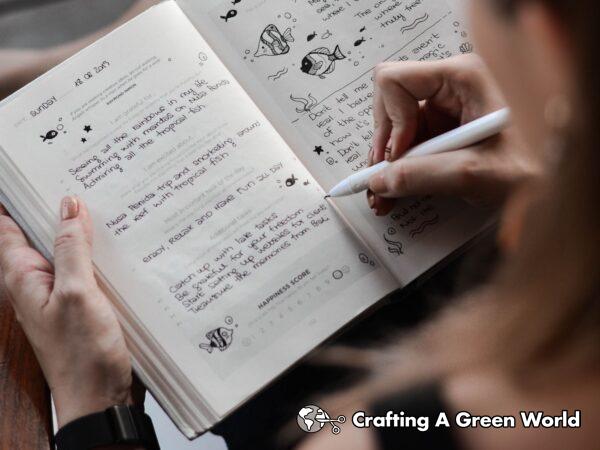
Self Esteem Journal Prompts
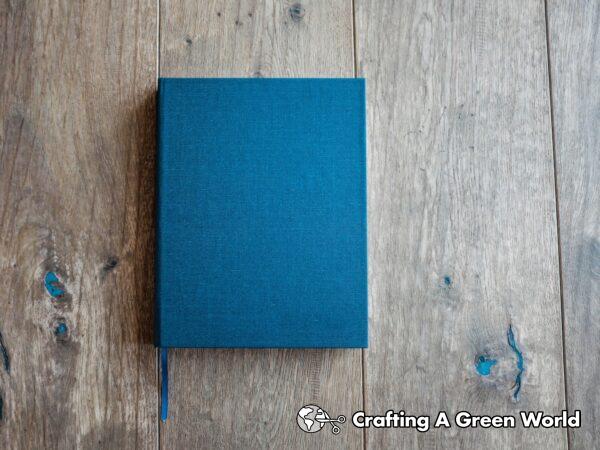
Submissive Journal Prompts

Journal Prompts For Anxious Attachment

May Journal Prompts

Sacral Chakra Journal Prompts

Journal Prompts For Middle School

Journal Prompt Cards

Journal Prompts For Anger
Leave a reply cancel reply.
Your email address will not be published. Required fields are marked *
Start typing and press enter to search

7 Writing Ideas for the First Week of School
This post contains an affiliate link
The first week of school is usually a blur. We are all settling into a new routine and the summer haze is lifting-slowly. This is the time we are getting to know our students, but also the time there is much to be done. We are settling into a new routine, adjusting students to a new routine, filling out enrollment reports, and putting the finishing touches on our classrooms. For this reason, coming up with first week activities can be a bit stressful. For the past few years, I’ve used these seven writing activities the first week of school at various times throughout the day and they all serve their own purpose.
Goal Setting
My fifth grade team is departmentalized and I teach writing. For this reason, I make this activity specifically writing focused, and put these as the first page of their binders on the first day of school. However, I’ve given an example in the picture below of how this can be done for any subject or grade level. Goal setting is extremely important because it reminds students that there is a purpose and a focus to their learning. I refer back to this page often throughout the year so they see whether or not they are meeting their goals. The picture I listed here is general, but I encourage you to have students list several goals and make them specific and attainable. You can download this FREE goal setting template here .

My Three Best Summer Memories
This activity is great for the very first day. Students can reflect on their summer and then share. It’s a great icebreaker because students love to read aloud their memories and share their pictures. Many times, individual personalities also come through and you can get a sense of what student hobbies are!

What I Want My Teacher to Know About Me
This is my favorite writing activity for the first week of school. I learn so many things about my students, and I constantly look back at these pages throughout the year. I’ve had students share simple things with me such as their favorite ice cream flavor, or very personal things such as family situations at home. This assignment is special to me because students feel they can share and they know I will read them. I often make sure I mention them throughout the next few weeks. For example, “Christopher, when do you start soccer practice?” Or, “Kayla, I’ll make sure I give you a signal before I ask you to read out loud because I know it makes you anxious.” This helps reduce the anxiety for students and create a friendly class atmosphere!

This Year I Want to Learn
I love reading what types of things students are interested in learning for the year. Some of which we won’t be able to cover, but I try my hardest to make sure students learn many at least one of the things they share on this sheet. Even if it means they have to do some of their own research! It’s a great way for students again to have a goal and a focus. Download this template for FREE here.

Grade Level KWL
This is something I created as kind of a unique spin on a KWL. In the morning, you can have students write what they k now and w onder about the grade they are starting. At the end of the day, have students write what they l earned about their classroom/grade. It’s a also a great way to reinforce rules and expectations!

The First Day of School
This writing activity is straight forward and simply allows students to share how they felt when they woke up in the morning. It’s also a perfect follow up activity to the book First Day Jitters by Julie Danneberg . The story has an awesome message about how teachers are nervous on the first day also! I’ve read it every year and it’s perfect for any grade level. I’ve read this story in both first and fifth grade!

All About Me
Although this has been done so many different ways, the All About Me activity is a classic! Letting your students be creative and share some special things about themselves is always a great icebreaker. This activity will never get old!

In addition to the free downloads above, you can purchase my full Back to School Activity set here . Have a wonderful start to your school year!

- back to school
- back to school getting to know you
- back to school writing
- back to school writing ideas
- first day of school
- first week of school
- first week of school writing activities
- first week of school writing ideas
- getting to know you writing ideas
- writing ideas
- writing ideas for the first week of school

Related Articles

- Teaching Setting in Fiction Writing: Creating Creative Places
When it comes to fiction writing, sometimes teaching setting can be the most daunting. When…

- Why You Need to Be Teaching Tiered Vocabulary
Vocabulary instruction is often overlooked, since it is typically embedded in our overall daily…

- How do you know which vocabulary words you should be teaching?
How do you know which vocabulary words you should be teaching? Two questions…
Leave a Reply Cancel reply
Your email address will not be published. Required fields are marked *

Recent Posts
- Making the Most of Your Morning Work : A Vocabulary Focus
- Interesting Nonfiction Topics Kids Love to Learn About
Recent Comments
- LMBLiteracy on Using Color as a Writing Strategy
- Maerea on Using Color as a Writing Strategy
- Carrie Rock on Tips for Teaching in a Departmentalized Classroom
- mysite on Teaching Content Through Poetry
- LMBLiteracy on Tips for Teaching in a Departmentalized Classroom
- January 2024
- December 2021
- February 2021
- December 2020
- October 2020
- February 2020
- January 2020
- December 2019
- November 2019
- October 2019
- September 2019
- August 2019
- February 2019
- January 2019
- November 2018
- October 2018
- Teaching Ideas
- Uncategorized
- Grades 6-12
- School Leaders
Get our FREE Field Trip Reflection printable 🦁!
28 Activities for the First Day of School To Start the School Year Off Right
Back to school, here we go!
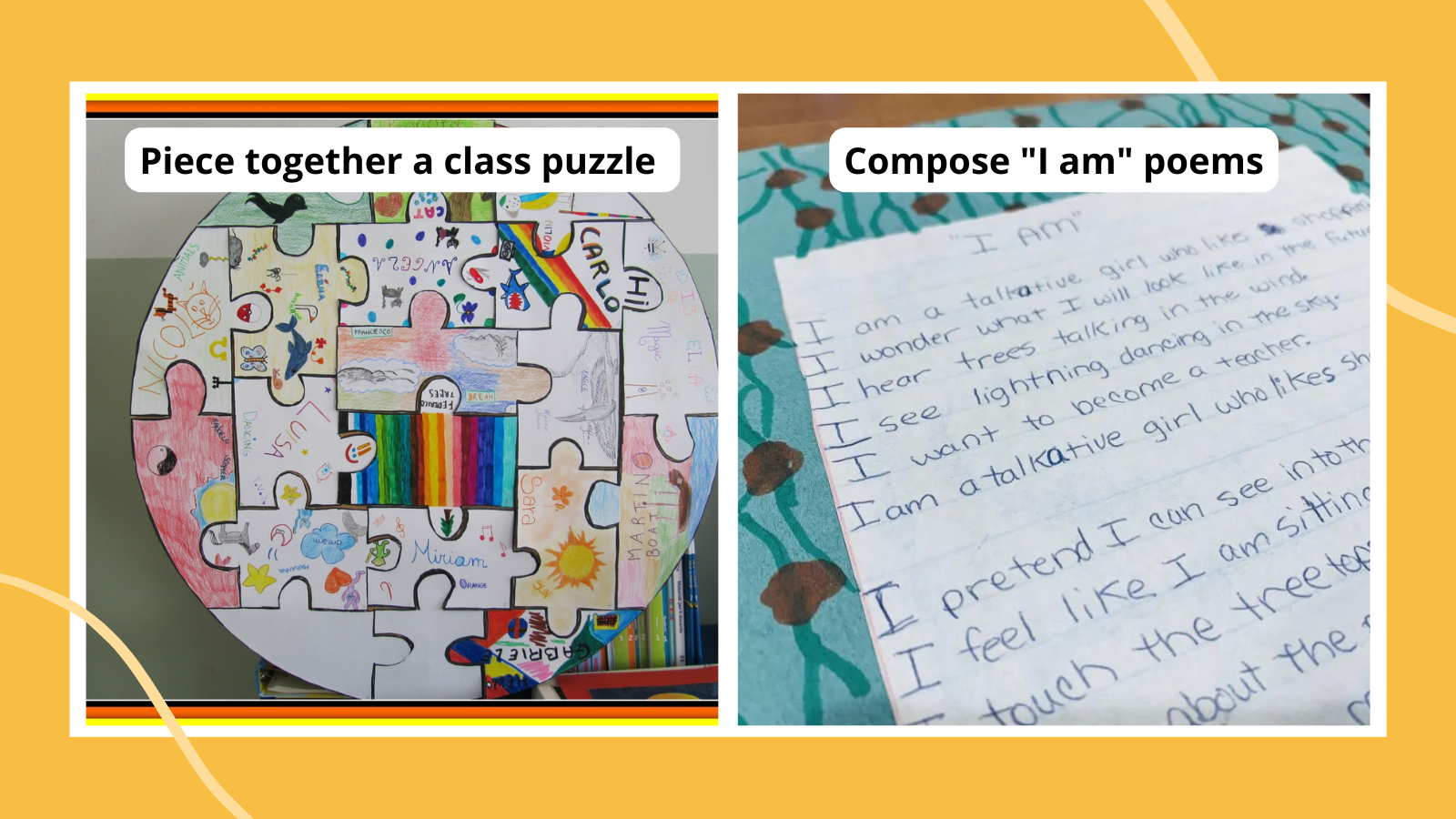
The first day of school can come with lots of excitement and, often, a bit of the jitters. It’s the start of a fresh academic year with new challenges and loads of learning opportunities. It’s also time to meet new people, make new friends, and learn different perspectives. These first-day-of-school activities will help you start off the year with a bang as you and your students form your community and begin your journey together.
1. Take first-day photos
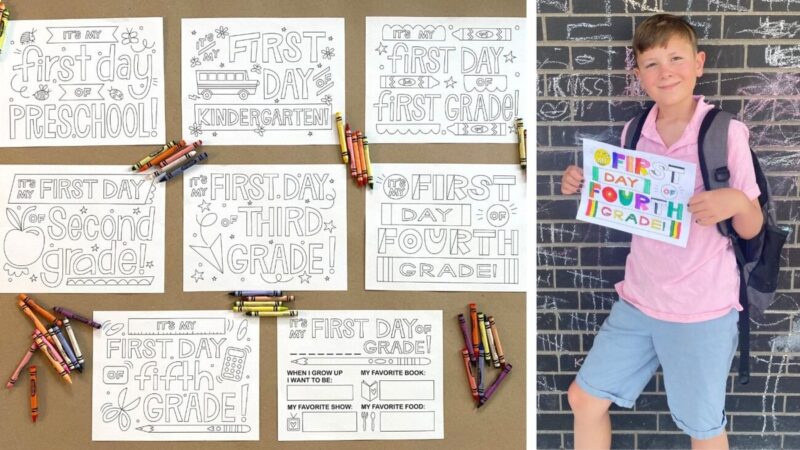
Mark the occasion! These signs for the first day of school are the perfect back-to-school accessory for photo opportunities and activities on the first day of school.
Learn more: Free First-Day-of-School Printable Signs for Every Grade
2. Play a name game
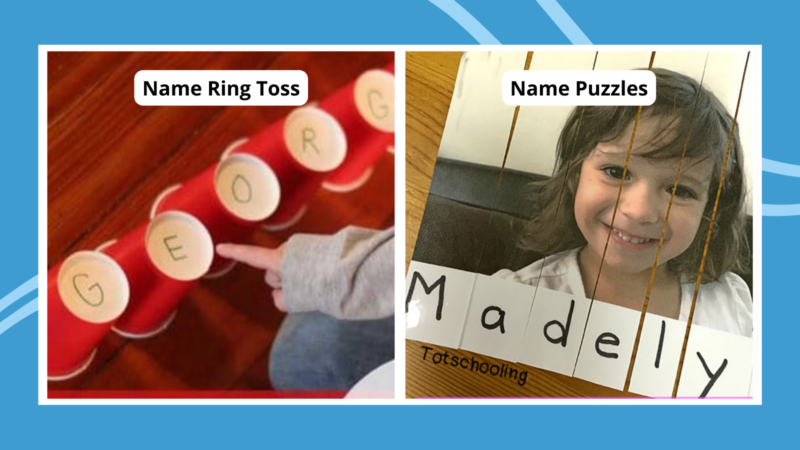
Playing a name game is a fun way to help the entire class place faces with names and learn proper pronunciation. Plus kids are more likely to feel like they’re part of an inclusive environment when they hear their name pronounced correctly.
Learn more: Fun Name Games To Play With Your New Class
3. Read first-day-of-school books
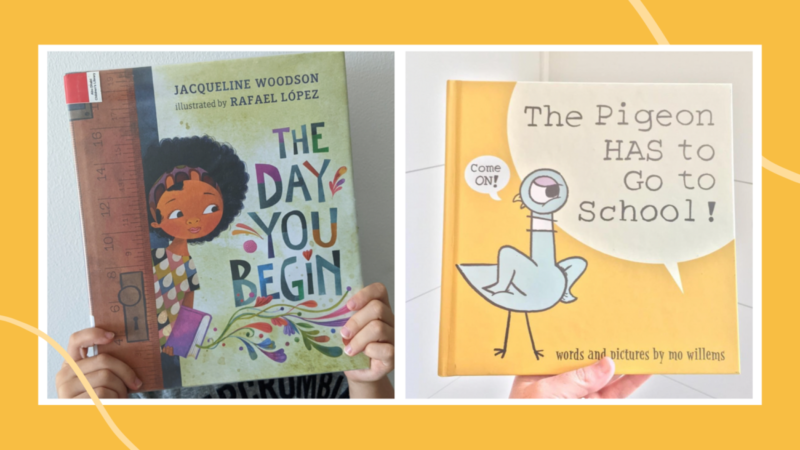
The first days of back-to-school can truly set the stage for the entire school year with students. Get off on the right track with these entertaining and informative read-alouds.
Learn more: Perfect Back-to-School Books To Read Aloud on the First Day
4. Play a round of Classmate Bingo
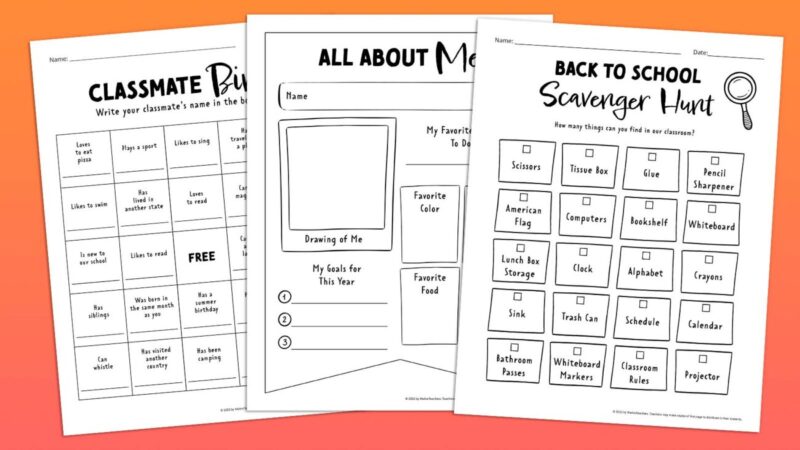
Invite students to mix and mingle as they learn fun facts about one another with this fun, free printable bingo template. And check out the link below for even more awesome first-day printable activities.
Learn more: Fun First-Day-of-School Worksheets
5. Go on a school supply scavenger hunt
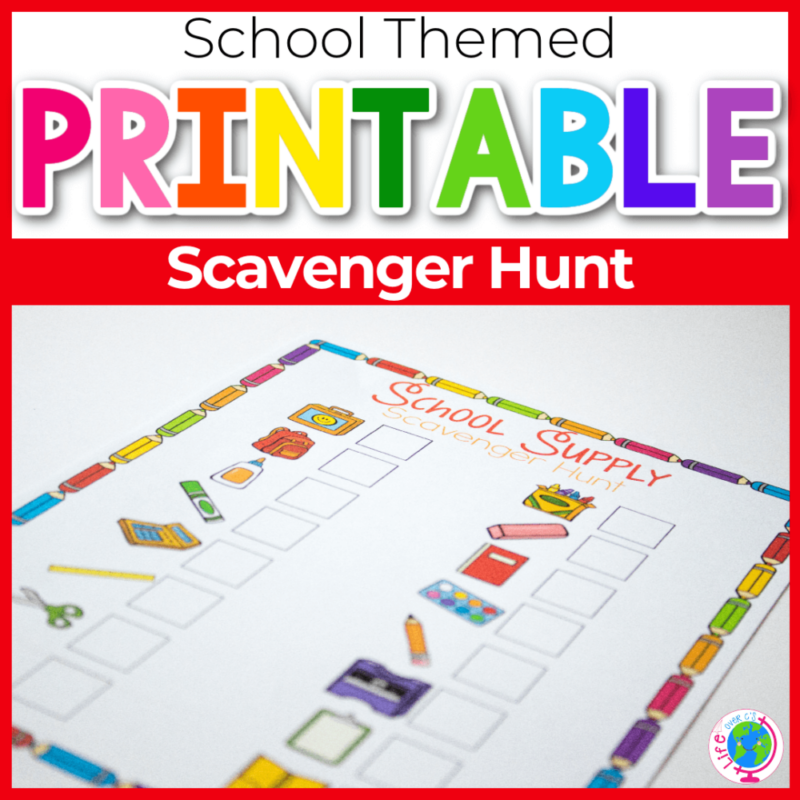
Spending lots of time gathering supplies for each assignment is time-consuming! Use this free printable worksheet to send your students on a scavenger hunt to find everything on the list. Then, when the time comes, they’ll be able to get geared up quickly.
Learn more: Life Over Cs
6. Ask your students about their hopes and dreams
Asking students about their hopes and dreams at the start of the school year gets them excited and enthusiastic about learning in your classroom.
Learn more: Responsive Classroom
7. Break the ice with fun activities
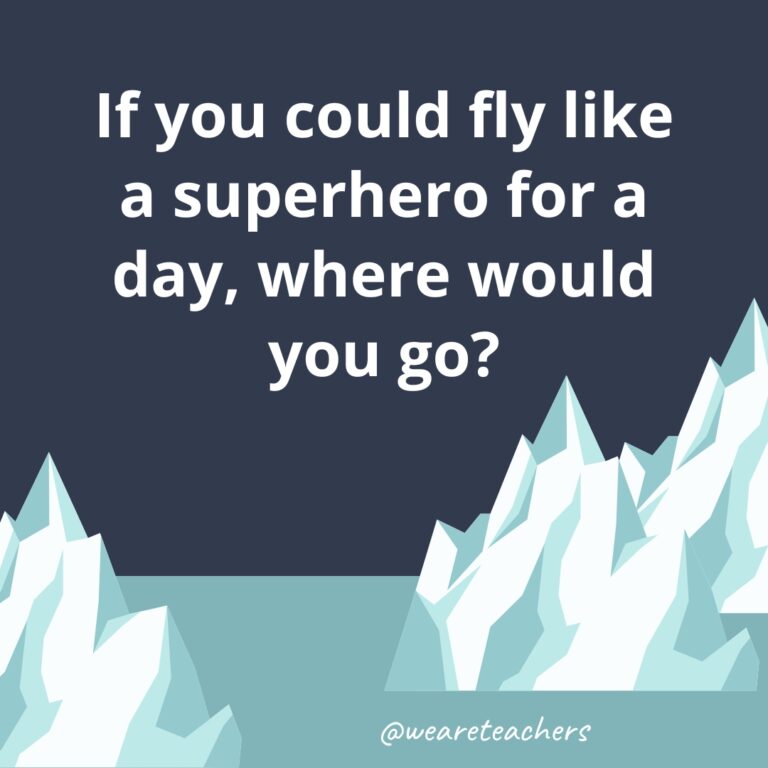
Icebreaker activities help kids form positive relationships from the get-go and are a great way to build community in your classroom. Along with these fun activities, try these Fun Icebreaker Questions for Kids and Teens.
Learn more: Elementary Icebreakers
8. Interview a classmate
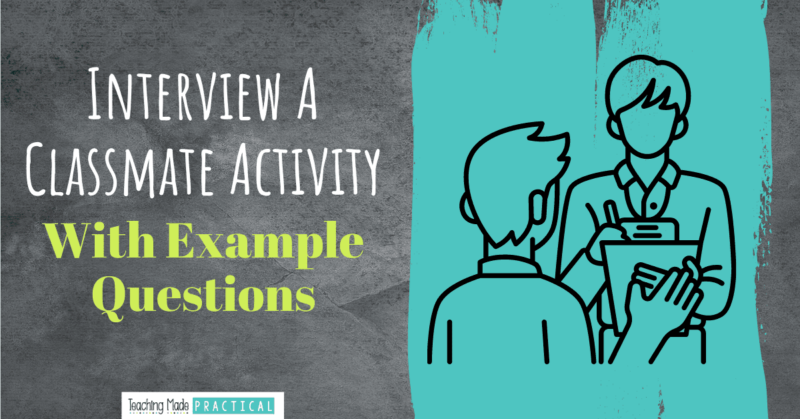
What better way to help students get to know each other those first few weeks of school than by asking each other questions? Have students pair up, ask questions, and take notes on each other. Do this activity a few times, having students switch up partners each time.
Learn more: Teaching Made Practical
9. Write “I Am” poems
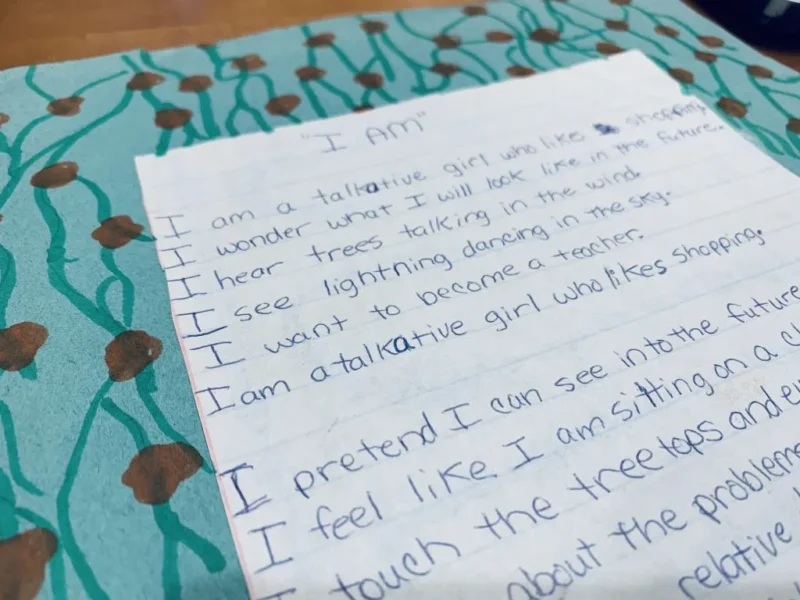
“I Am” poems beautifully capture a snapshot of your students at the beginning of the school year. Their poems reveal their hopes, dreams, and fears and help you get to know them a little better. Write your own along with them, and be sure to share.
Learn more: Mary Hanna Wilson

10. Craft a class contract together
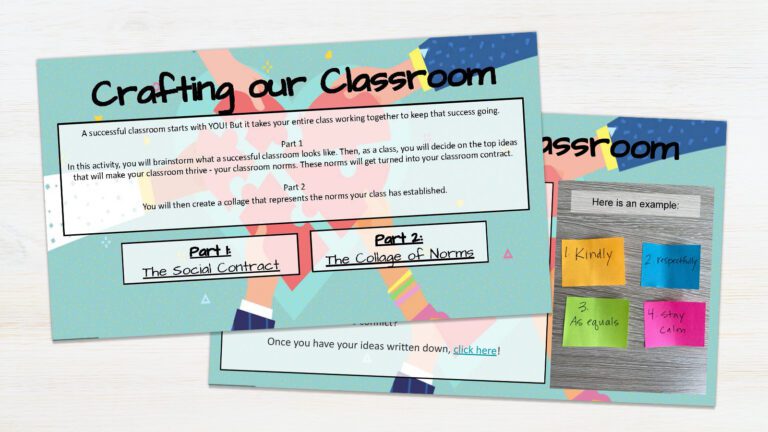
Taking the time to create a classroom contract sets the stage for a supportive environment. Asking questions like “How do you want to treat each other?” and “How should we handle conflict?” opens up the dialogue and lets your students know that their needs are important.
Learn more: 4 Free 15-Minute Icebreakers for Your Classroom
11. Offer a STEM challenge
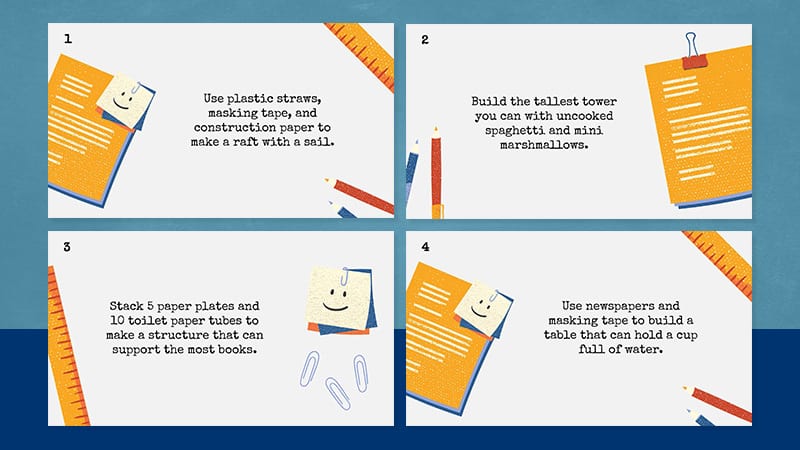
STEM challenges not only encourage kids to work together to solve problems and challenge their thinking skills, they are super fun!
Learn more:
- Kindergarten STEM Challenges
- First Grade STEM Challenges
- Second Grade STEM Challenges
- Third Grade STEM Challenges
- Fourth Grade STEM Challenges
- Fifth Grade STEM Challenges
12. Open up with a teacher Q&A
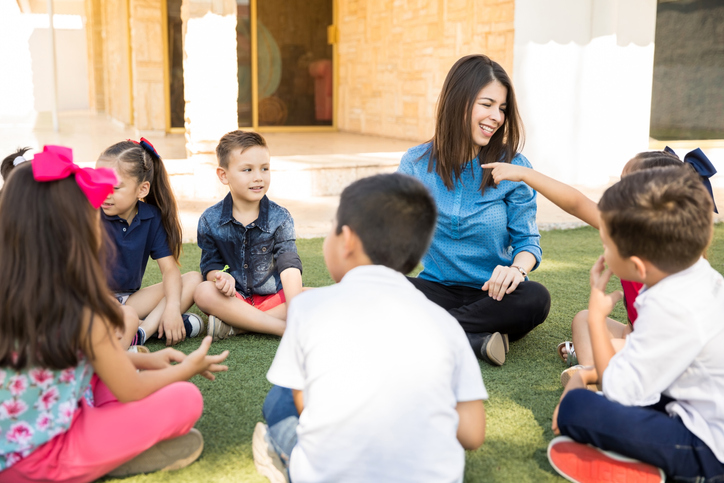
Holding a Q&A session is a great way for your students to know more about you. Sit center stage and open the floor to their questions. Not only will this establish trust and help your students feel more comfortable with you, it is a great way to model how your morning circle works.
Learn more: What I Have Learned
13. Establish a few first-day-of-school traditions
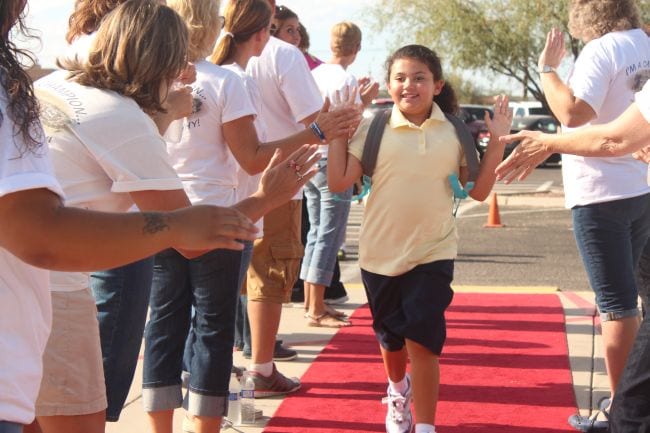
Over the years, you’ll find a few first-day-of-school activities that are keepers. They mark the day as special and help you set the tone for a fun year ahead. Check out the list below and adopt a few as your own.
Learn more: First-Day-of-School Traditions Your Students Will Love
14. Start a goal-setting project
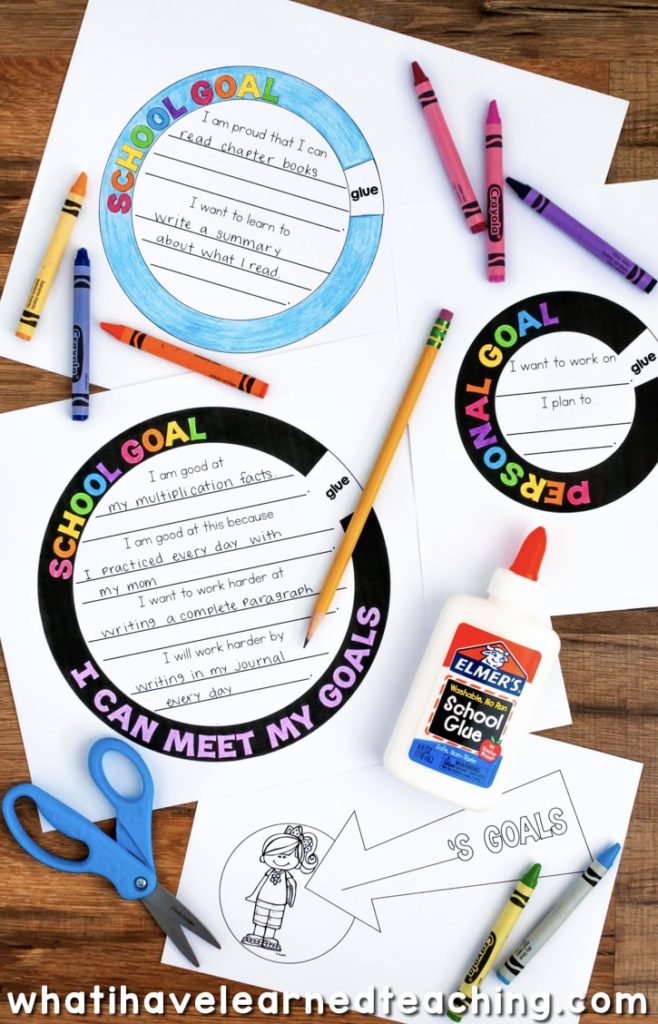
Being able to set goals is an important skill for students to practice all year long. This fun activity helps students identify some of the things they hope to accomplish and document them in an artful, creative way that becomes a colorful display for the classroom and a great keepsake for parents.
15. Get those procedures and routines rolling
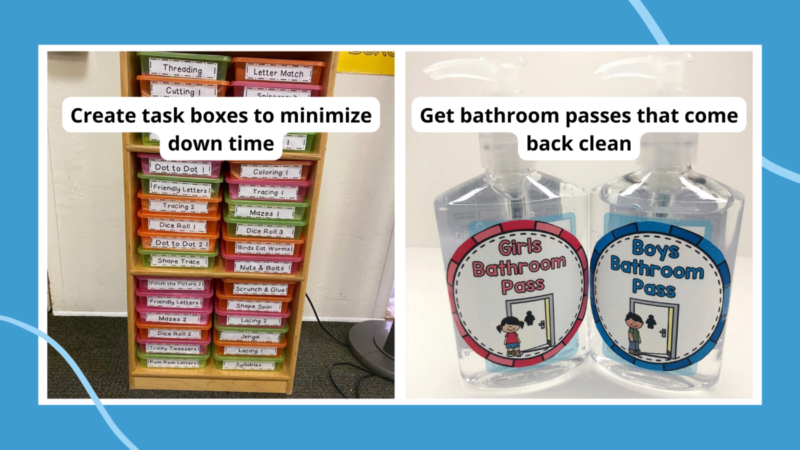
The first days and weeks of school are the ideal time to set the stage for a well-managed classroom. These tips will help you establish, reinforce, and streamline classroom procedures that will really make a difference.
Learn more: Must-Teach Classroom Routines and Procedures
16. Race to build the tallest tower
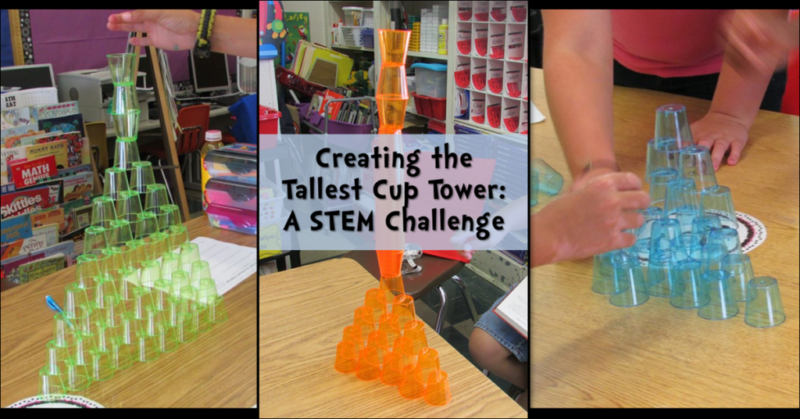
This is another fun STEM challenge and collaborative activity for your students. As your students work, circulate around the classroom and take note of the strengths and challenges you see among your students. Use your notes to plan future coaching sessions.
Learn more: Laura Candler
17. Ask “Would you rather” questions
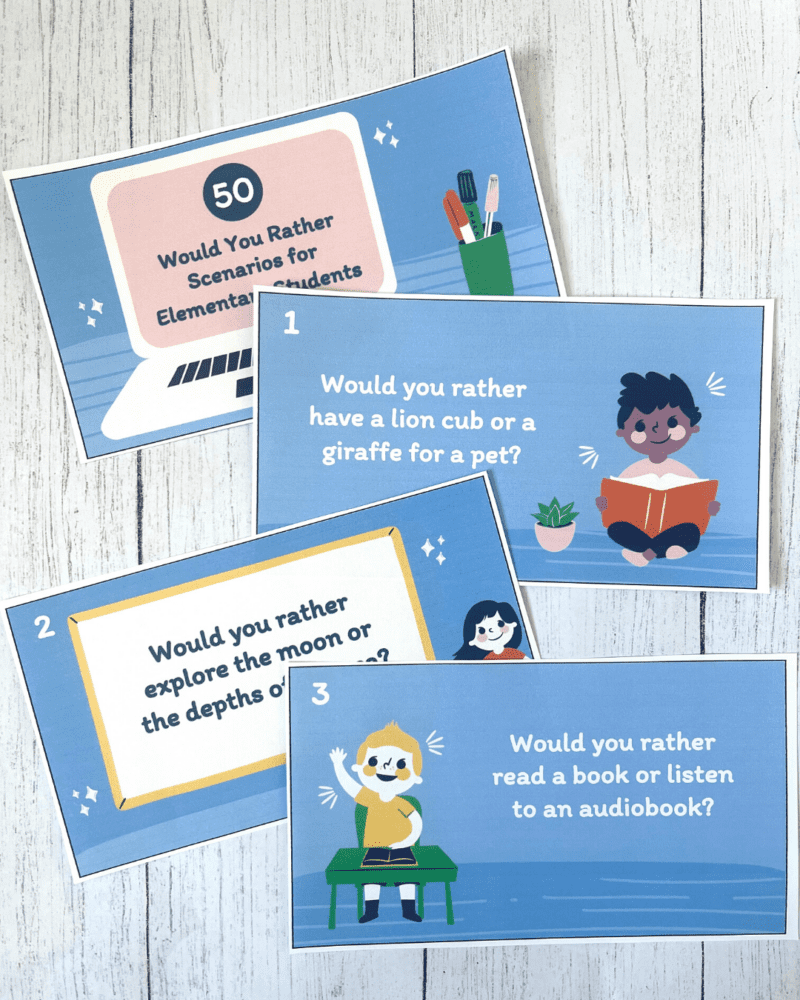
A perennial favorite, “Would you rather” questions delight kids of all ages. Funny, silly, and though-provoking, they loosen up first-day jitters and help kids find common ground with their classmates.
Learn more: Would You Rather? Questions for Elementary School
18. Play “Get To Know You” Jenga
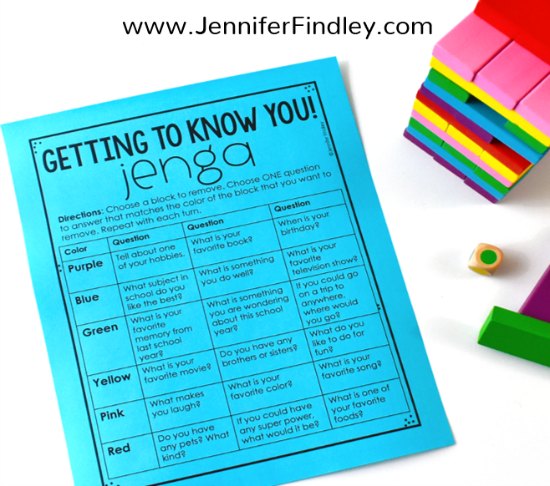
Sometimes direct Q and A can feel a little intimidating. Putting a Jenga spin on it turns it into a game while accomplishing the “get to know you” aspect of this fun first-day-of-school activity.
Learn more: Jennifer Findley
19. Get creative together
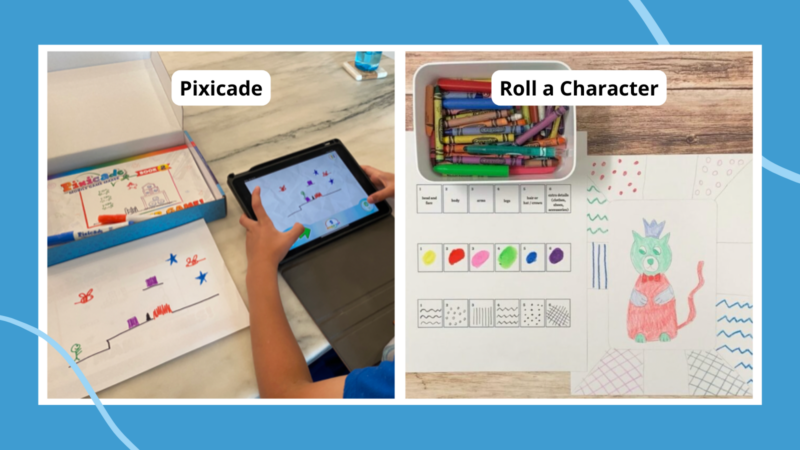
Get your students’ creative juices flowing from the get-go with these fun drawing activities.
Learn more: Clever Drawing Games To Level Up Artistic Skills
20. Find out what your students wish their teacher knew
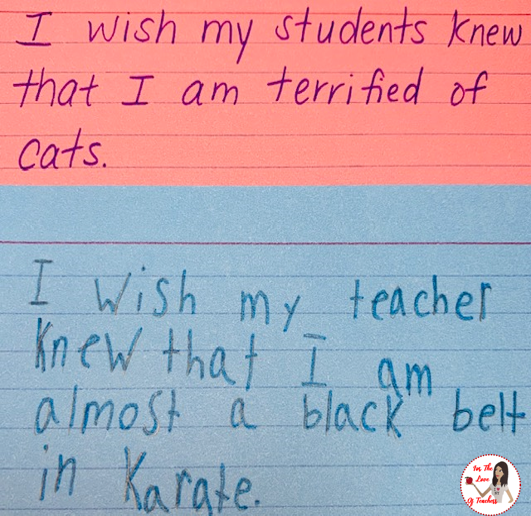
Getting to know your students is the first step toward building meaningful relationships with them. This activity gives your kids the opportunity to share important information about who they are and what is important to them. Share a little bit of yourself as you model this activity for them first.
Learn more: For the Love of Teachers
21. Establish your job/my job expectations
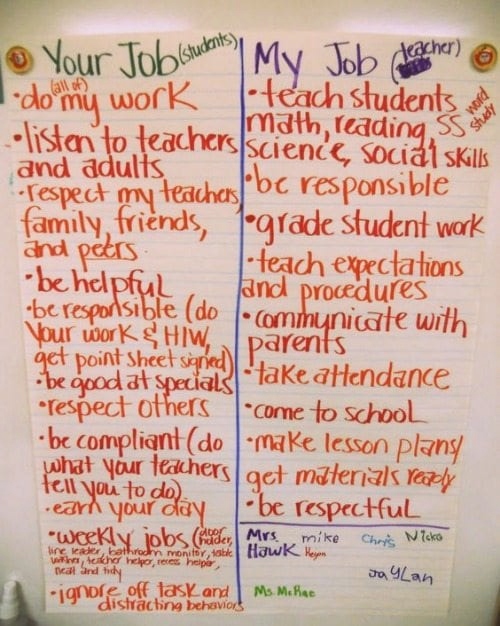
Occasionally kids can get a little overzealous and have some issues with boundaries. This activity is a great reminder for students about their job as a student vs. yours as their teacher.
Learn more: Mrs. Hawk’s Nest
22. Set the stage for a great year
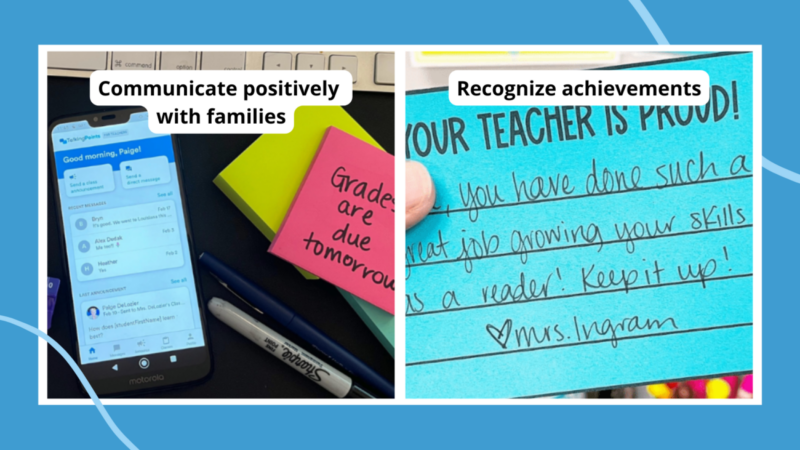
The key to a well-planned classroom management system is finding out what works best for you and for your particular group of individuals each year. Here are 22 teacher-tested management techniques to help you design and maintain your own ideal classroom learning environment.
Learn more: Brilliant Classroom Management Strategies and Techniques
23. Find common ground with Venn diagrams
Venn diagrams are not only a great learning tool, they can be a fun get-to-know-you activity. Watch this fun video together, then pair students up to find out just how much they have in common with one another.
24. Put together a group puzzle
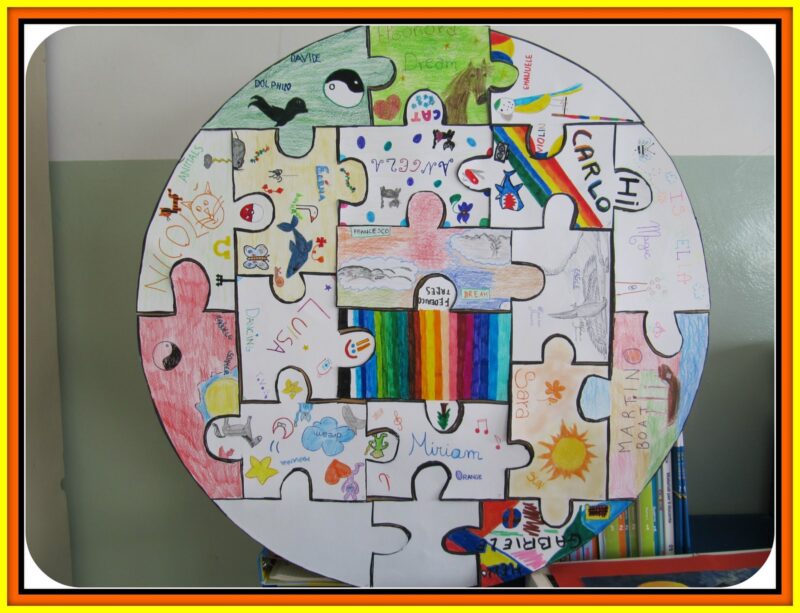
Create a beautiful collage of student art with this group puzzle. Hand out one piece to each student and encourage them to illustrate their piece in a way that expresses their personality. Then, give them time to put it all together. Once they’re done, apply clear contact paper over the puzzle and turn it into a hangable piece of art for your classroom.
Learn more: Teachers Pay Teachers
25. Touch base with some one-on-one time
This teacher-blogger shares one of her favorite activities for the first day of school. “I like to spend a few minutes one-on-one with each student,” she says. “Get to know them, introduce yourself, giggle, and encourage them. Making that personal connection on the first day is so important! You may get some teacher inspiration and insights into your students that you can use all year long!”
26. Sweeten the getting-to-know-you process
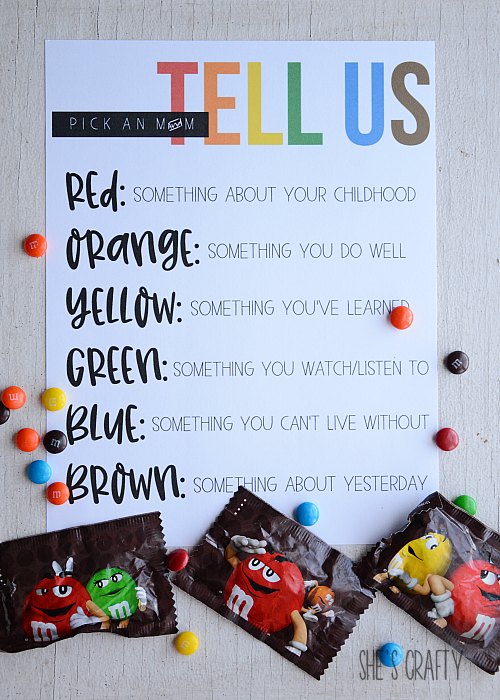
Did someone say M&Ms? This fun activity is sure to catch your students’ attention. Maybe save it until right before recess so they can run off the sugar spike.
Learn more: She’s Crafty
27. Play a team-building game
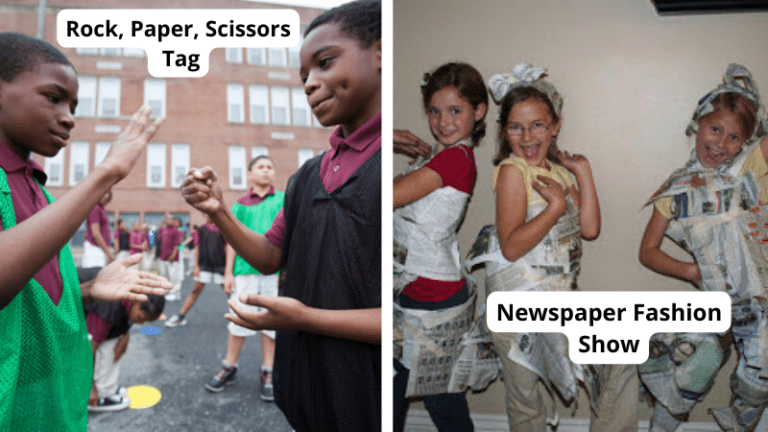
Team-building activities are a super way to kick off the first day of school. They give your students the chance to get to know one another, build trust as a community, and, best of all, have fun!
Learn more: Awesome Team-Building Activities for Kids
28. Set goals with avatars
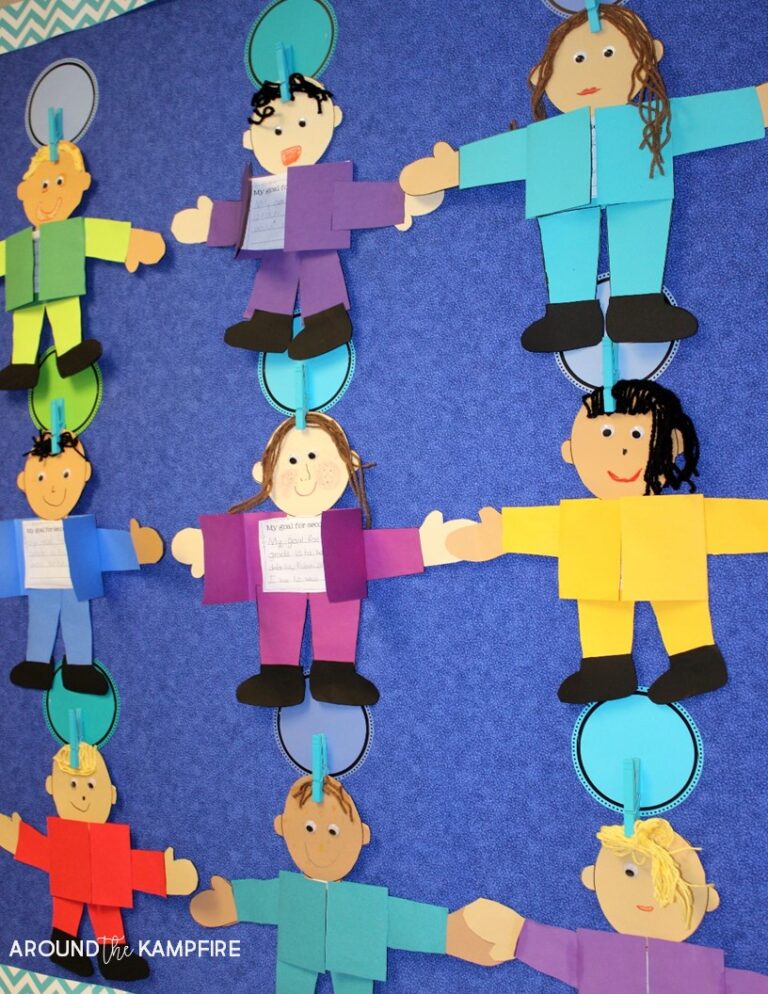
This is another fun way to teach students the importance of setting meaningful goals. And just like the characters they create, have your students focus on their individual strengths and needs as they formulate their goals.
Learn more: Around the Kampfire
What are some of your favorite first-day-of-school activities? We’d love to hear about them in our WeAreTeachers HELPLINE group on Facebook.
Plus, check out welcoming doors for back to school ..
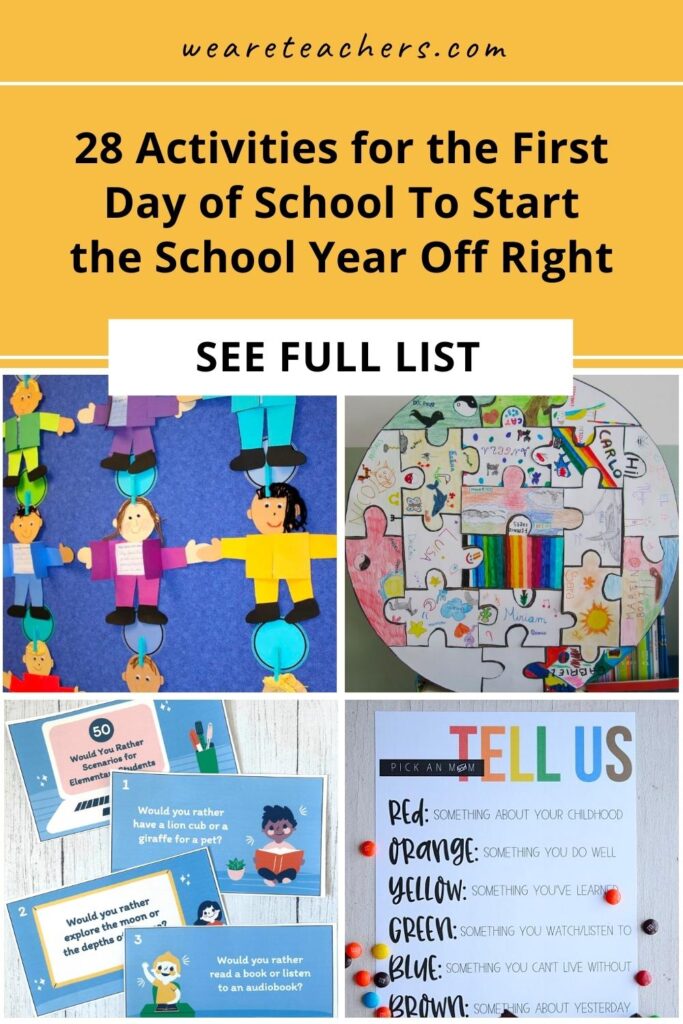
You Might Also Like
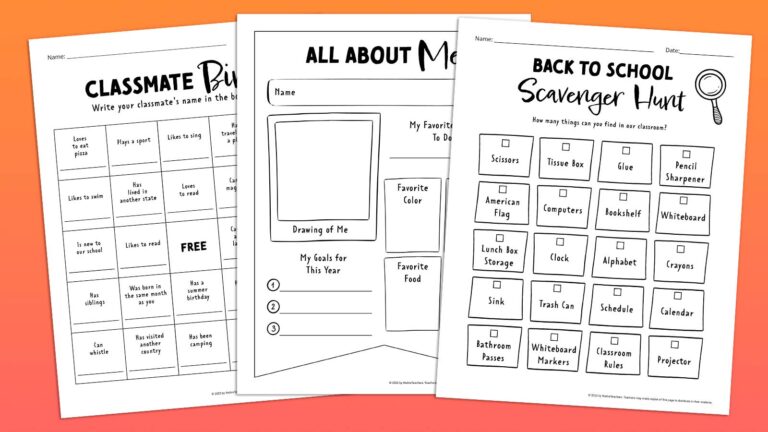
12 Fun First-Day-of-School Worksheets (Free Printables)
Fun activities for the first days and weeks of school. Continue Reading
Copyright © 2024. All rights reserved. 5335 Gate Parkway, Jacksonville, FL 32256
- BookWidgets Teacher Blog
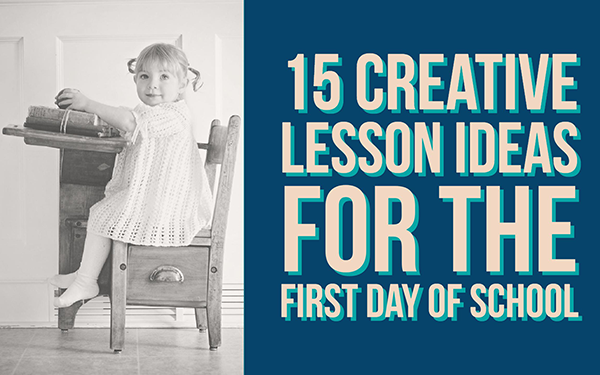
15 creative lesson ideas for the first day of school

Back to school. Finally! In Belgium, school starts on the 1st of September, after a summer break of two months. Other countries have already begun the new school year, others still have a few weeks to go.
There’s one thing we all have in common: the first day of school. A special day for students and teachers. A day full of emotions. Stress, fear, relief, happiness, joy, …
How can you make sure those first-day-of-school emotions are good emotions? I’m betting on creative back-to-school lesson ideas students will find a fun thing to do.
So here they are!
15 fun back to school classroom activities
First day of school activities are based upon one goal: to get to know each other. Most first day of school activities are for elementary, but I included a few as well for middle school students and high school students. Some can be used for all ages too.
💡 Pro tip : Make sure to also check out this blog post with 20+ ready-to-use digital lesson activities for on the first day of school .
First day of school activities for elementary students
1. all about the bag.
Hand out a paper bag to all your students the first day of school and put a little note on it:
Directions: Fill this bag with 4 things or objects that tell something about yourself. (only 4 things, no more, no less) All your objects have to fit in this bag. Decorate the bag if you wish! Bring the bag back tomorrow and be ready to share with the class.
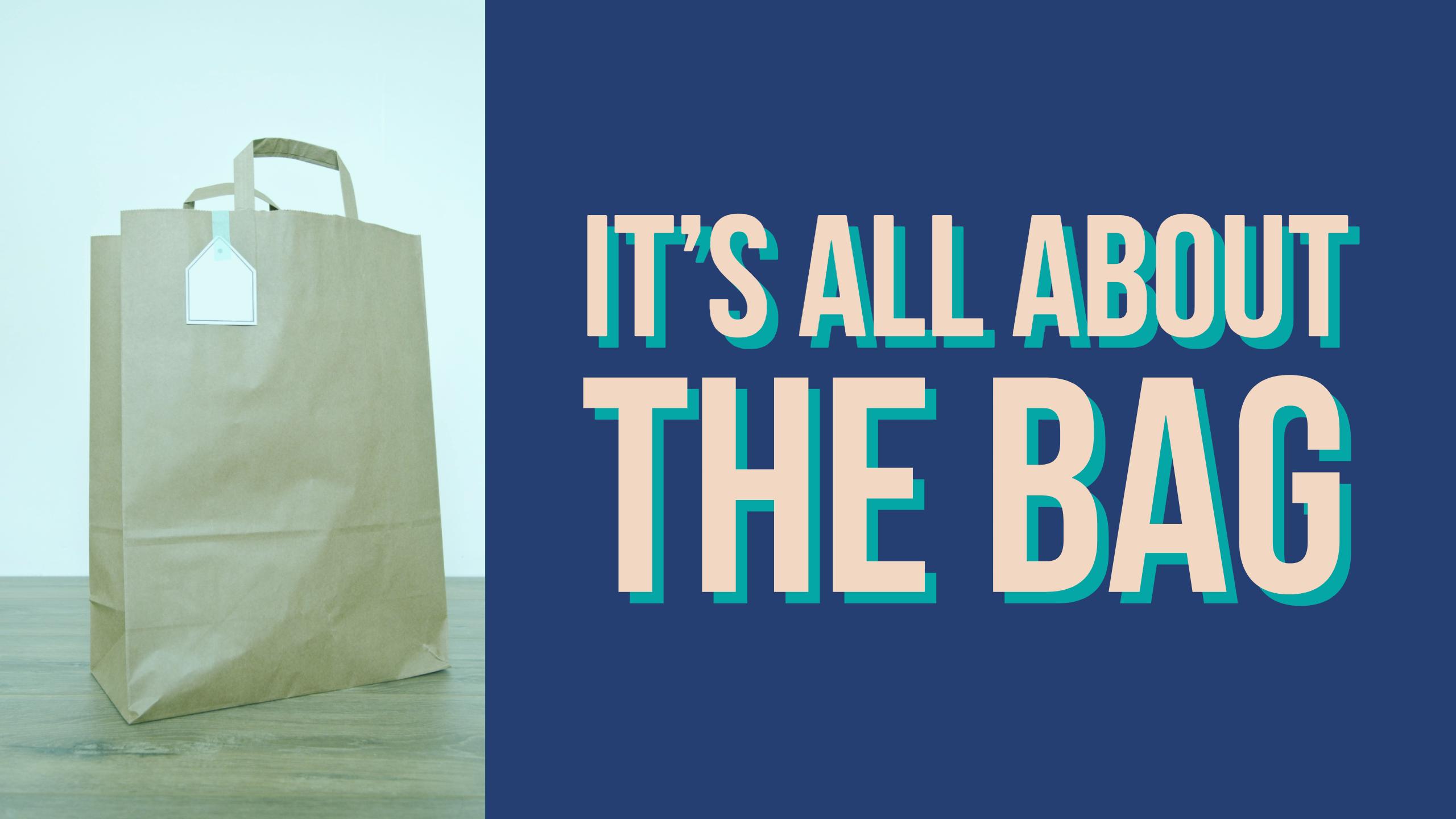
2. Figure me out
In fourth grade, students have already learned arithmetics. You could let them create a profile of themselves, describing some fun facts using arithmetics. Take a look at the image below for an example.
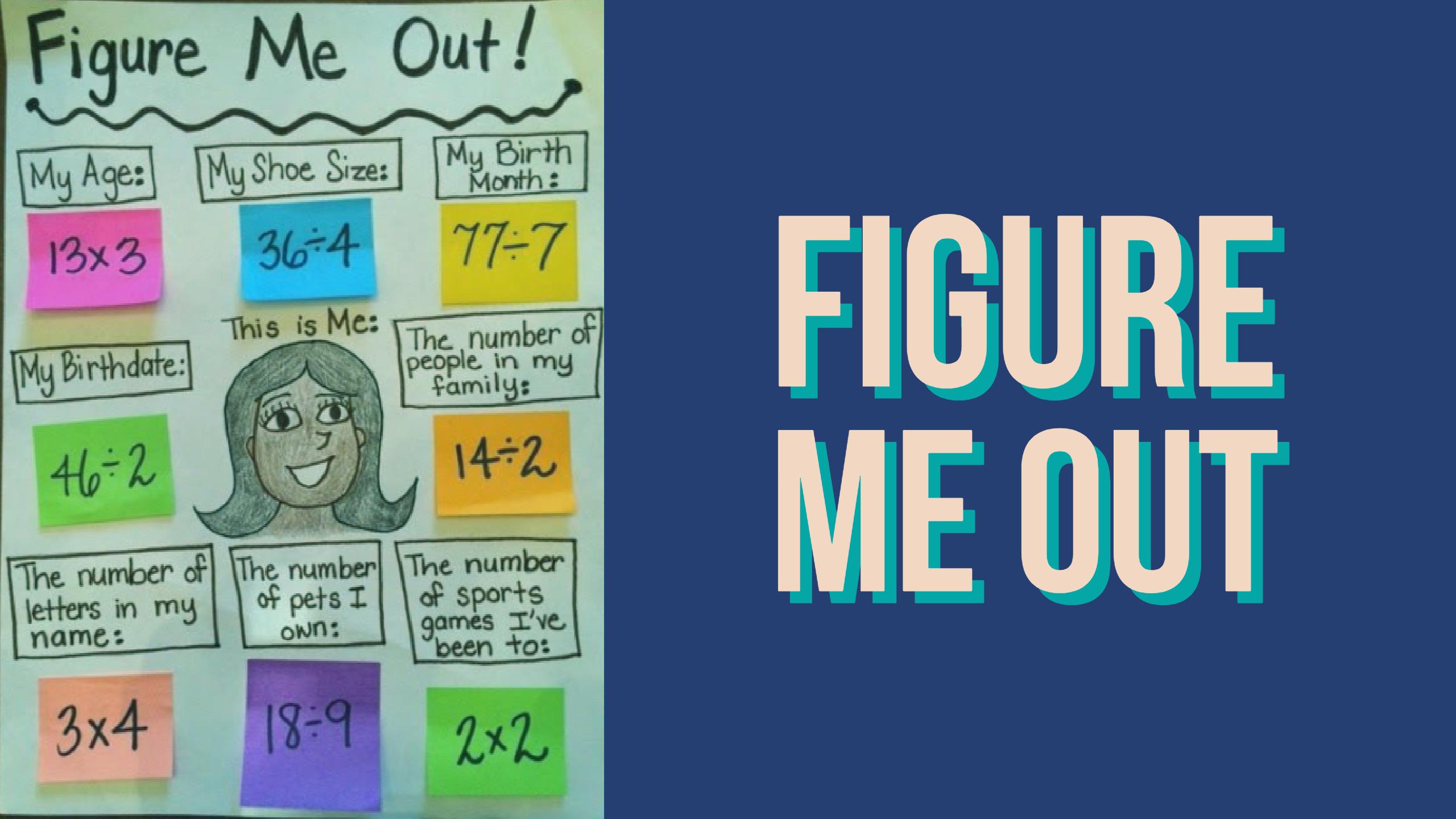
Students have to figure out the person by calculating the facts. Then they have to guess who that person is.
3. Beach ball game
A classroom game to get to know each other better. All you need for this first day of school activity is a beach ball and a marker. Write down several questions on the beach ball in a random order.
Examples of questions:
- What are you most proud of?
- What’s the most heroic thing you did?
- What’s your favorite animal?
- What color is your toothbrush?
- I am thankful for _____
- What’s your favorite movie?
- What’s your favorite sport?
- How many siblings do you have?
- What’s your favorite dessert?
- What do you like to do after school?
- When’s your birthday?
Now form a circle and throw the beach ball to a student. Wherever the student’s left thumb lands, is the question he has to answer. After answering that question, he can throw the ball to another student.
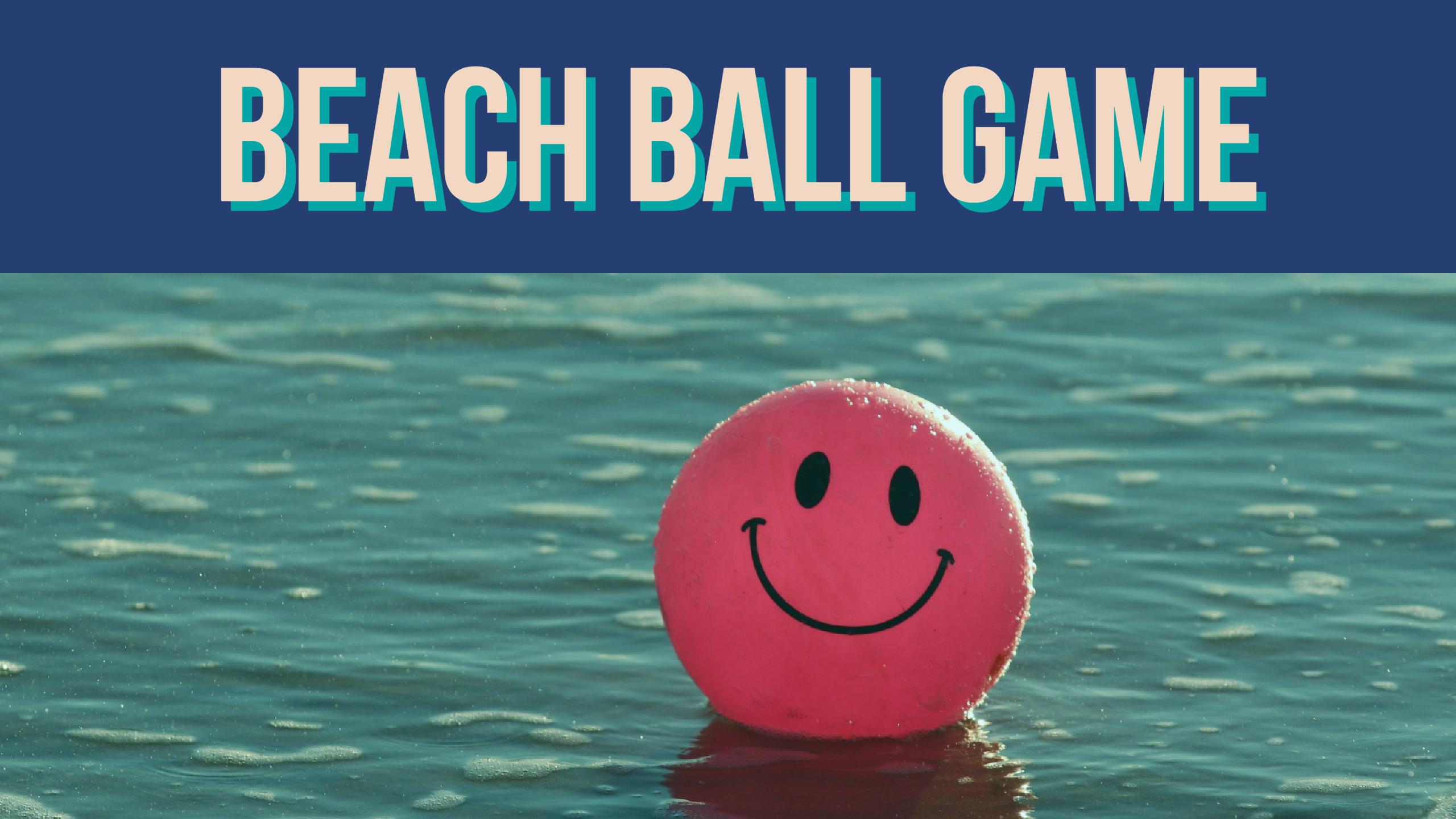
4. Create a time capsule
You probably already know the concept of a time capsule. If you have ideas of your own, go with it. If you don’t, here’s something you could do with a time capsule on the first day of school.
Let your students write down their wishes and hopes for the following school year. What do they want to learn this school year? Then put everything in the time capsule and bury is somewhere safe beneath the ground. You could also put a fun class picture in it.
At the end of the school year, you dig up the time capsule and let your students reflect on what they’ve learned and if their wishes at the beginning of the school year came true. You can also try to make the exact same class picture. It’s fun to see who has changed in one year and who didn’t.
You could do this first day of school activity in college as well! If your students are much older, like college students, you could let them write down the profession they want to practice at the end of their studies. A lot of them will have changed along the way, but it’s fun to see how their dreams and expectations change in time. It’s also fun to just include a bucket list of each student. These are things they want to do during their time as a college student.

5. Nice mnm’ing you
Everyone loves mnm’s. Besides eating them, you could also use them for a fun back to school lesson. Divide the mnm’s over a few cups and share them with your students. Students have to pick out a mnm blindfolded and tell a story or answer the question. Every color represents its own story.
- Red: something about yesterday
- Orange: something you do well
- Yellow: something about your childhood
- Blue: something you learned last week
- Brown: something you can’t live without
- Green: something you watch or listen to
Oh, one more thing… Of course students may eat the mnm’s after finishing the question. Guess who’s going to be the most popular teacher this year? 😉
💡 Pro tip : A variation of this game has already been made with BookWidgets. Check it out here ! It is ready to use with accompanying instructions.
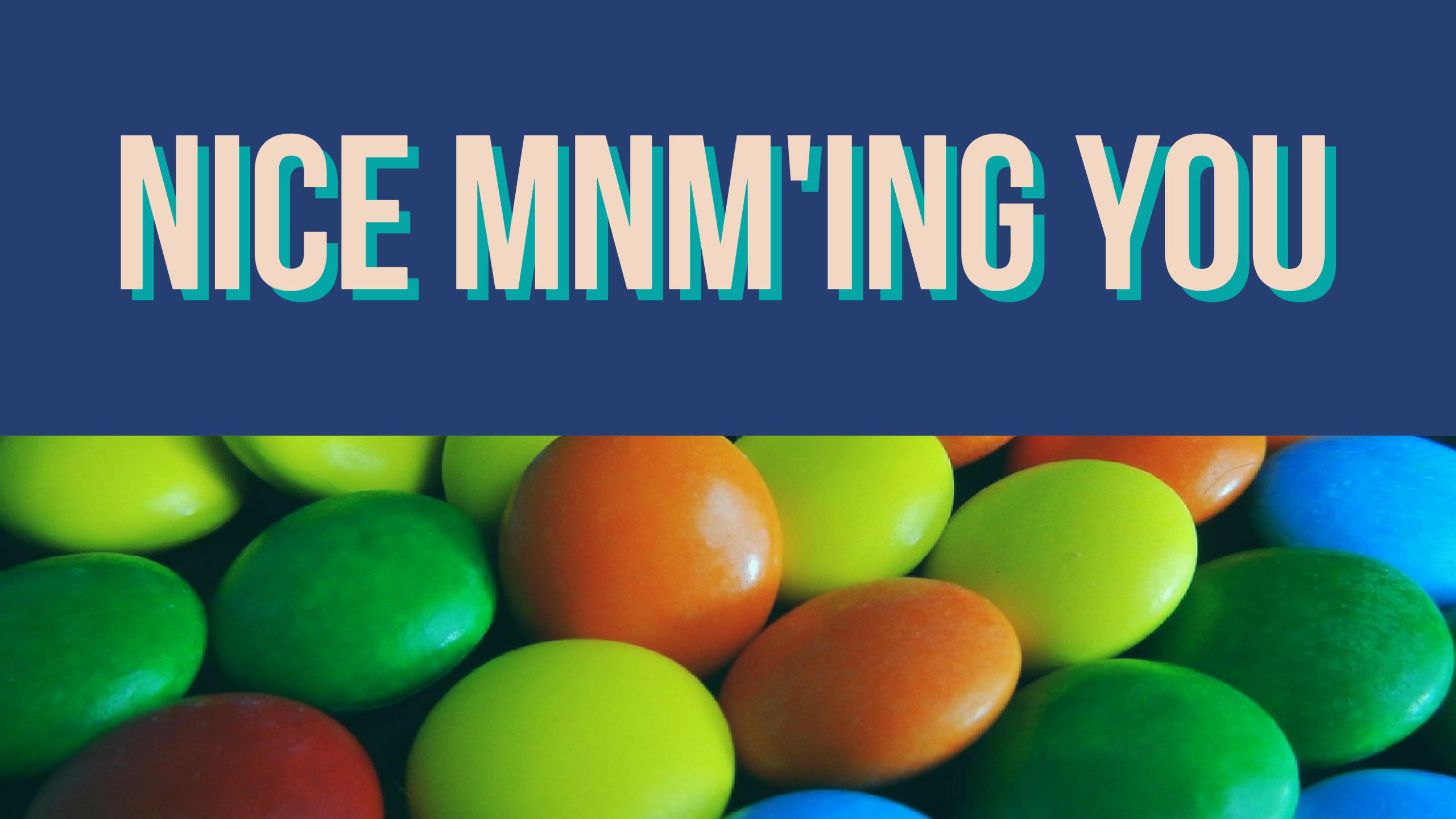
6. Randomness
The Randomness widget from BookWidgets is handy for creating a variety of back-to-school games. Spin the wheel to generate a student and ask them to talk about a randomly selected topic. Alternatively, you can give a specific topic and spin the wheel to see which student is chosen.
Topics you can include:
- What would you do with 1 million euro?
- What is your favorite place on earth?
- What is your biggest dream?
💡 Pro tip : Curious for our example? Click here to find out. Some examples of topics we used: What’s your hobby? Where do you live? So actually some icebreaker questions.
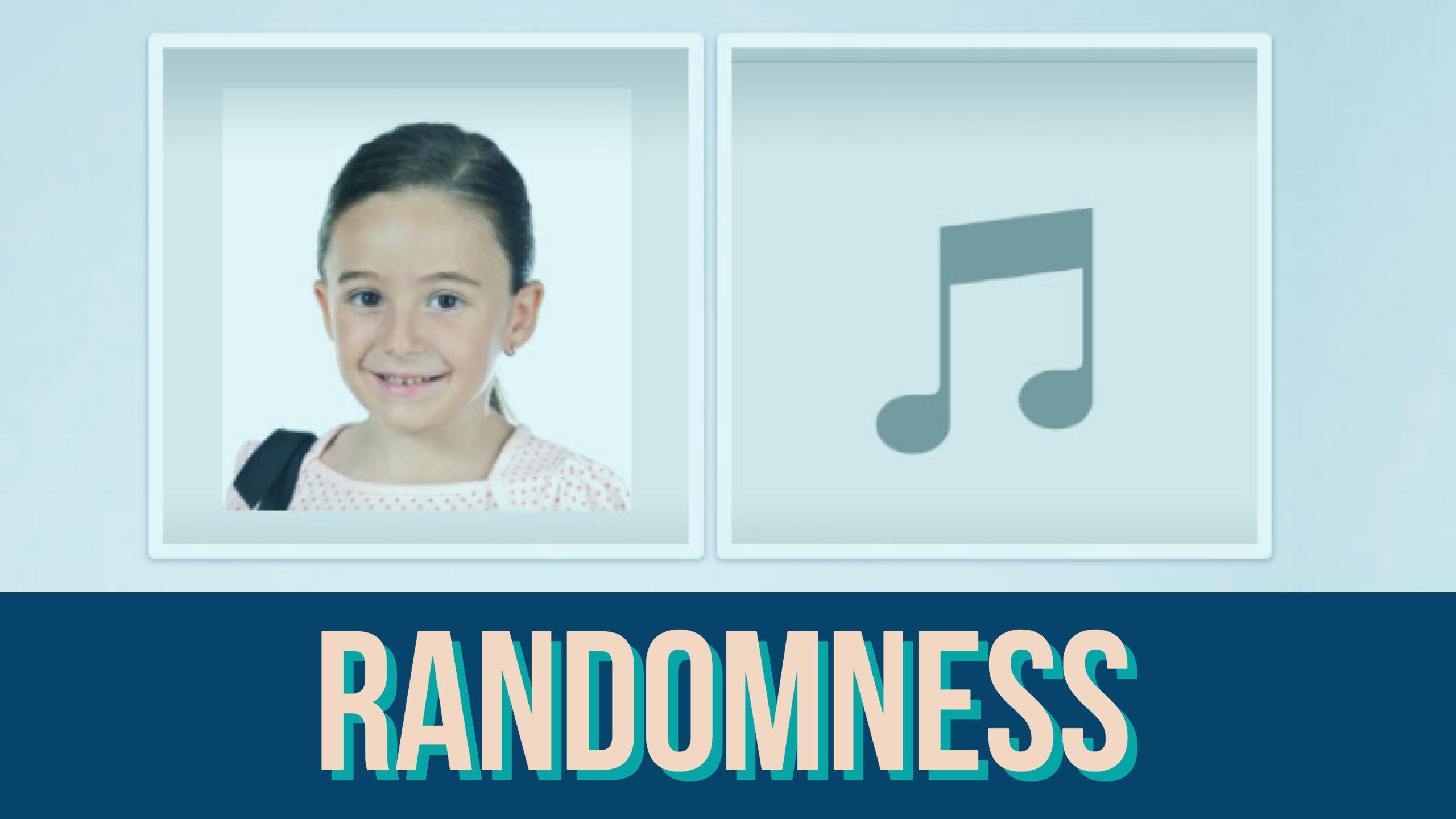
Click here to start creating your own back to school randomness activity with BookWidgets.
7. Would you rather
To get to know your students you could ask them crazy choice questions. Make fun cards and let them pick one. They have to answer the question “would you rather…?”.
Here are some examples:
- Would you rather have to eat raisins every day or eat peas?
- Would you rather walk around with a hole in your pants or with a broken zipper?
- Would you rather eat a salad or liver?
- Would you take a bath or a shower?
- Would you rather have lunch with the president or a famous singer?
- Would you rather wear gloves or a hat in the winter?
- Would you rather eat chocolate or skittles if it’s all you had to eat on a hike?
- Would you rather adopt a cat or a dog?
- Would you rather go snowboarding or skiing?
- Would you rather wear flip flops or sneakers?
- Would you rather have an in ground pool or a horse?
- Would you rather live in Hawaii or in Italy?
- Would you rather get in trouble with your parents or your teacher?
- Would you rather ride on an elephant or a giraffe?
💡 Pro tip : You can also put these questions in a “ randomness widget and let students spin the wheel.
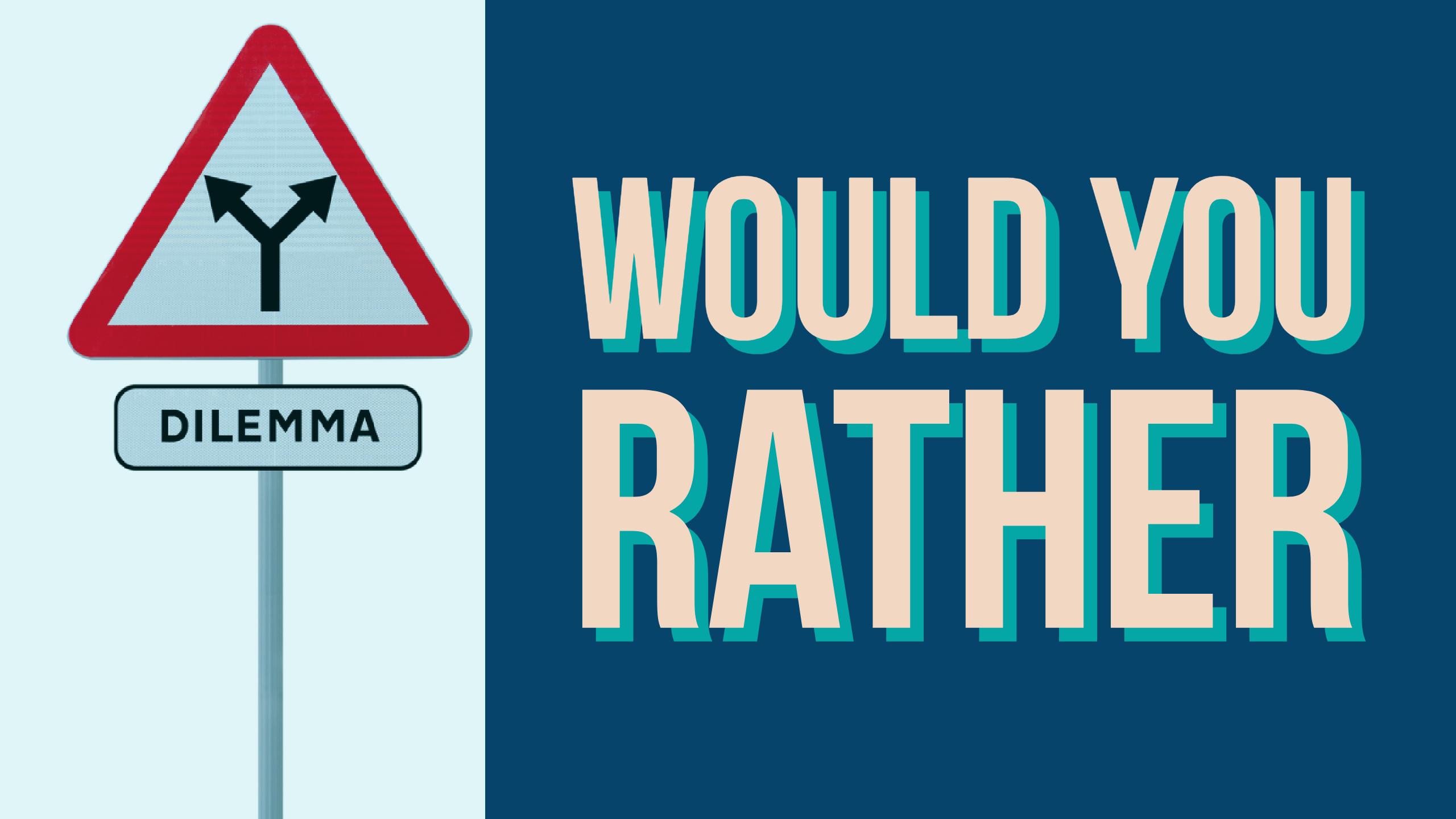
8. Snowball fight
Let each student take out a sheet of paper and write down 3 interesting, but not widely known, facts about him or herself. There can’t be any names on the papers!
Let students crumple up their papers into balls and have a paper “snowball” fight. After a few minutes, all the paper snowballs will be all over the classroom. Now, students have to find a snowball, and unfold the paper. Each student must try to find the student whose snowball he or she retrieved.
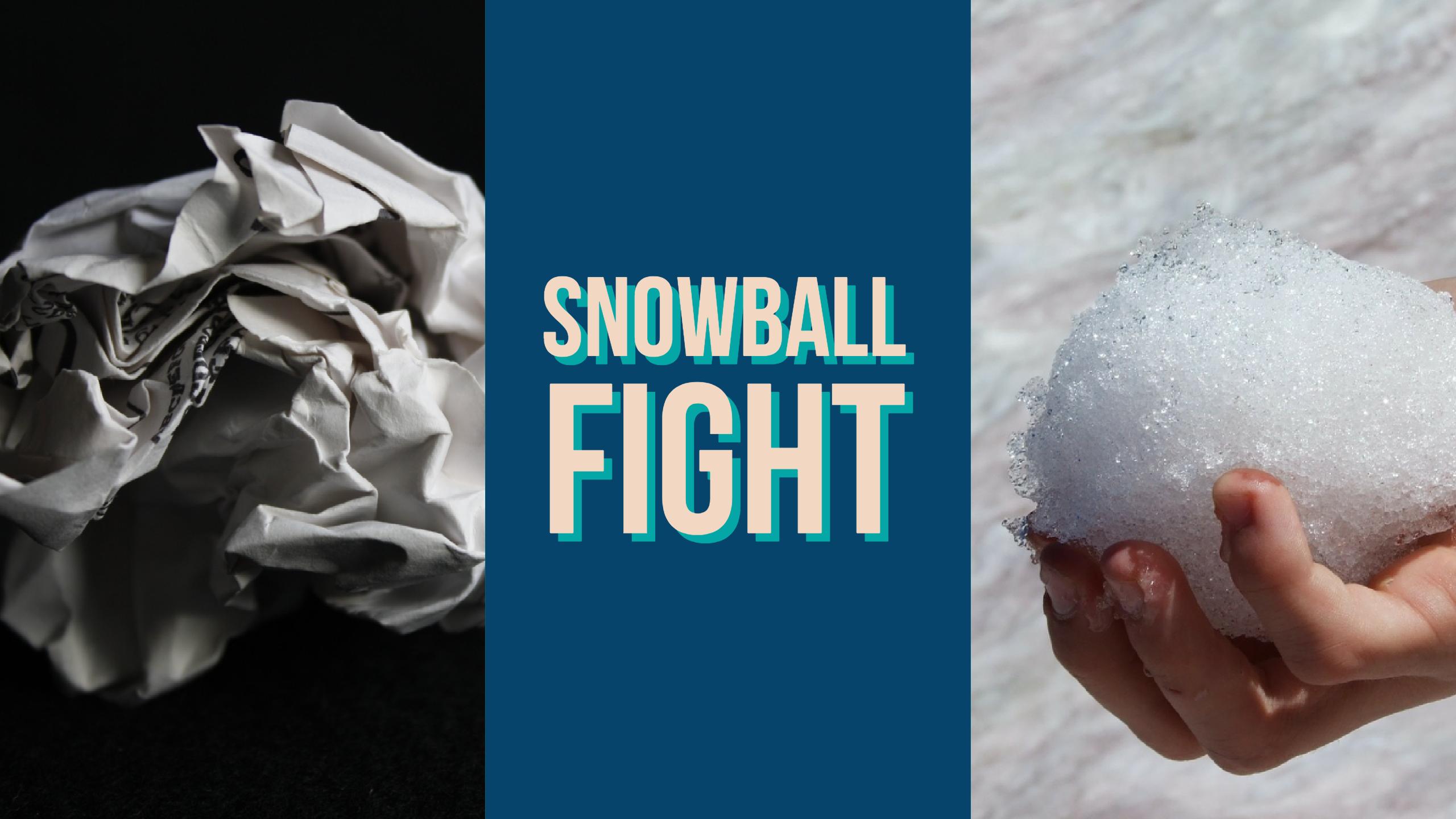
9. Fit in puzzle
Create a giant blank puzzle and hand out a blank piece of the puzzle to every student. They have to decorate the puzzle piece with drawings that say something about themselves. After, you collect the puzzle pieces and complete it again with the help of your students. Now you have something to put on your empty classroom wall!
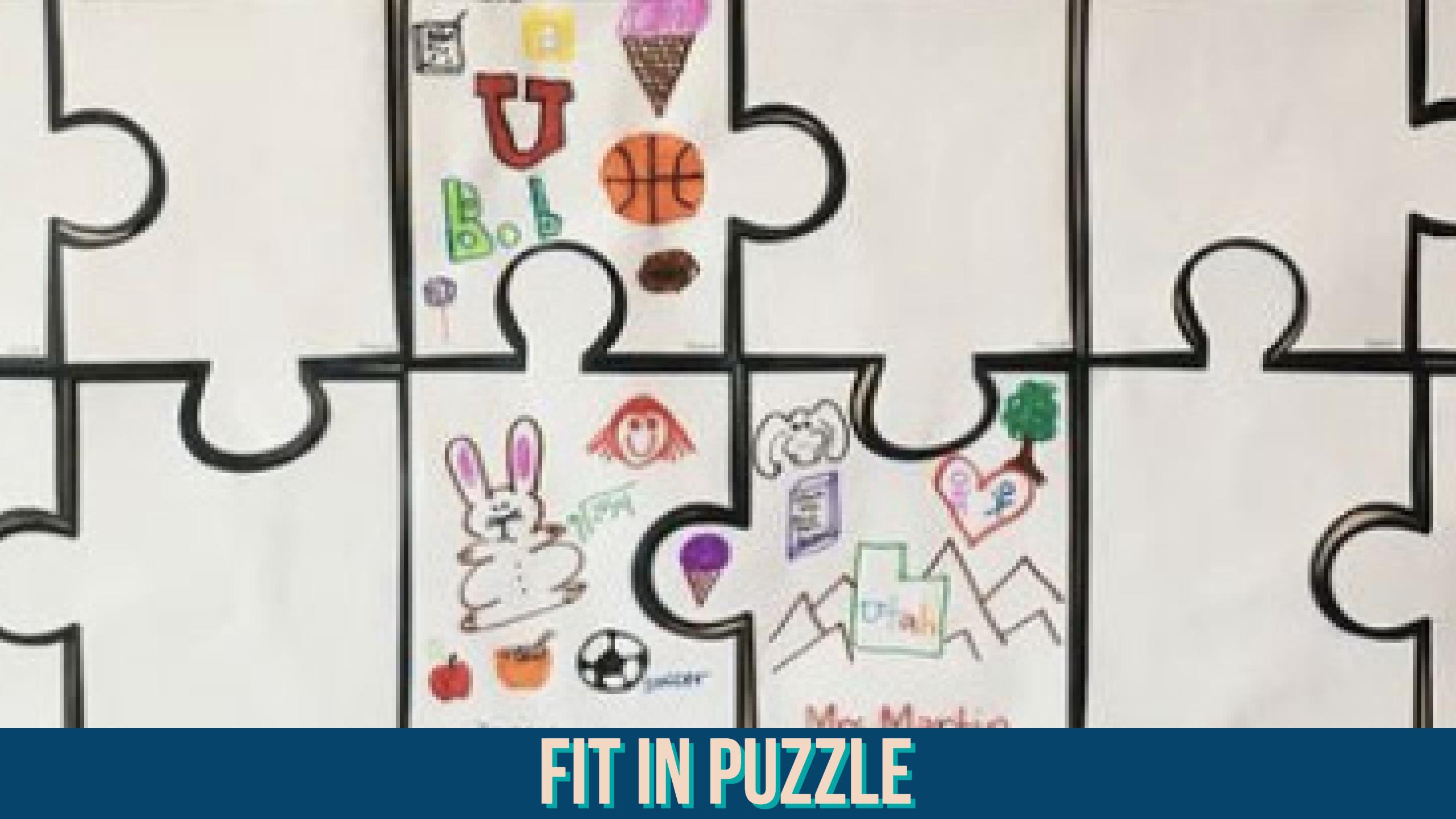
First day of school activities for middle school students
10. tell it with emojis.
Let your students summarize what they did during their summer break using only emojis! If you have new students, you can also let them introduce themselves using emojis.
For example:
- Hobby(s): 🎨 💃🏻
- Family: 👨🏻 👩🏼 👧🏽 👧🏻 👦🏻
- Favorite food: 🍝
💡 Pro tip : Unsure about how to create an exercise like this? Don’t worry, I have you covered! Take a look at this ready-to-use example .

The back to School Bingo is a fantastic icebreaker activity for middle school children as it will help them to get to know their classmates. Create a Bingo Card in BookWidgets and in each square, write a brief description, such as:
- Lives close to school
- Likes pizza
- Has 3 siblings
- Loves sport
Challenge your students to go around the room, asking classmates some questions. When they have a match, they are allowed to tick off that square.
💡 Pro tip : Click here to see how it looks like. Afterward, you can use this activity from BookWidgets in your classroom.
Click here to start creating your own back to school bingo activity with BookWidgets.
12. Art-phone
Social media and smartphones are going to be omnipresent during this school year. This fun classroom activity for the first day of school is a nice reminder of that fact. Let’s get crafty and create an art-phone like the one in the image. Create an Instagram wall, a chat session and a social profile.
For more details, take a look at this Pinterest pin .
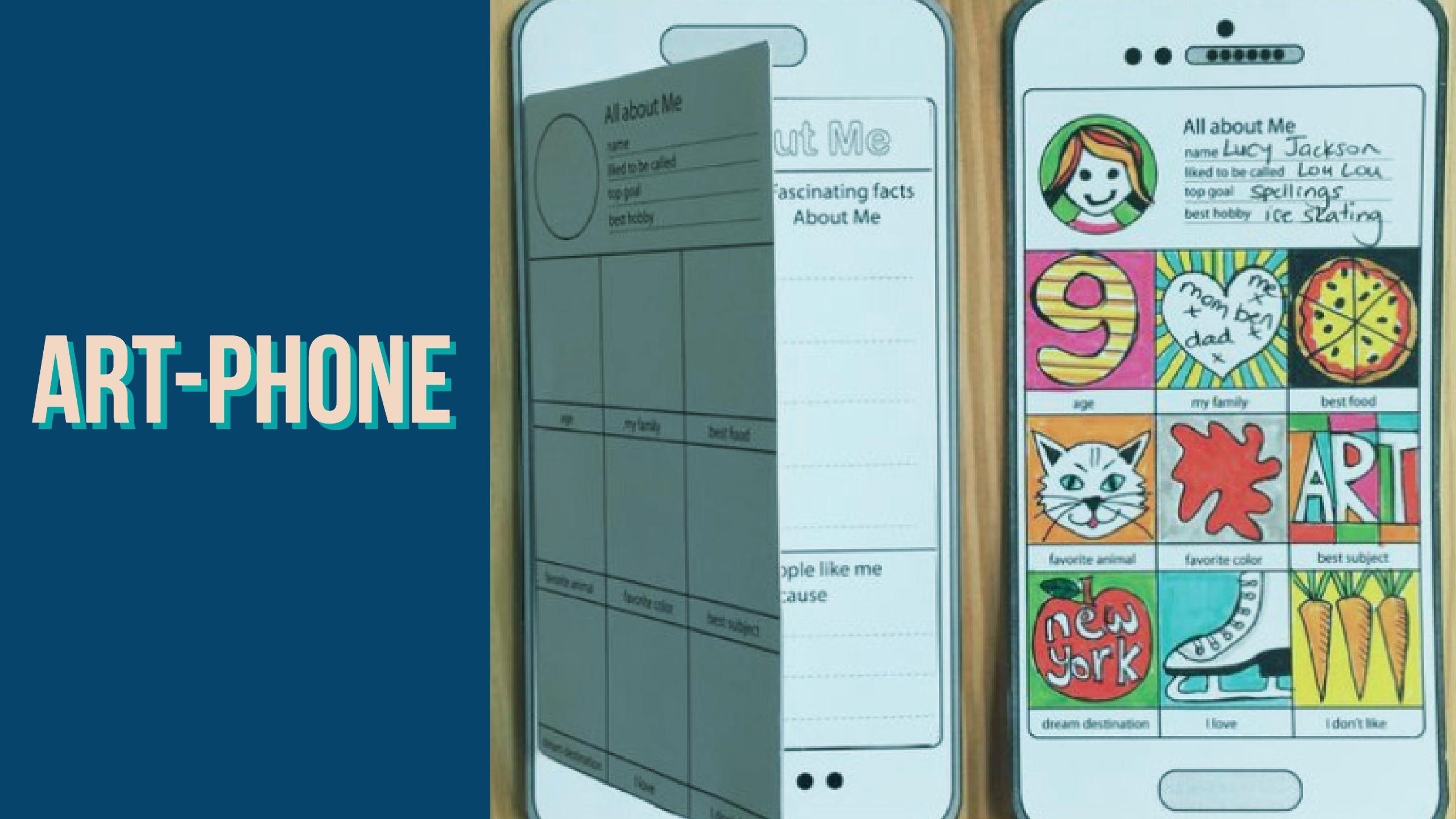
13. (B)all about me
It’s kind of the same as the creative Instagram activity above this one, but still a little bit different.
Students have to decorate their paper ball with drawings of themselves. Check out what I mean by clicking on this Pinterest link . The result is beautiful!
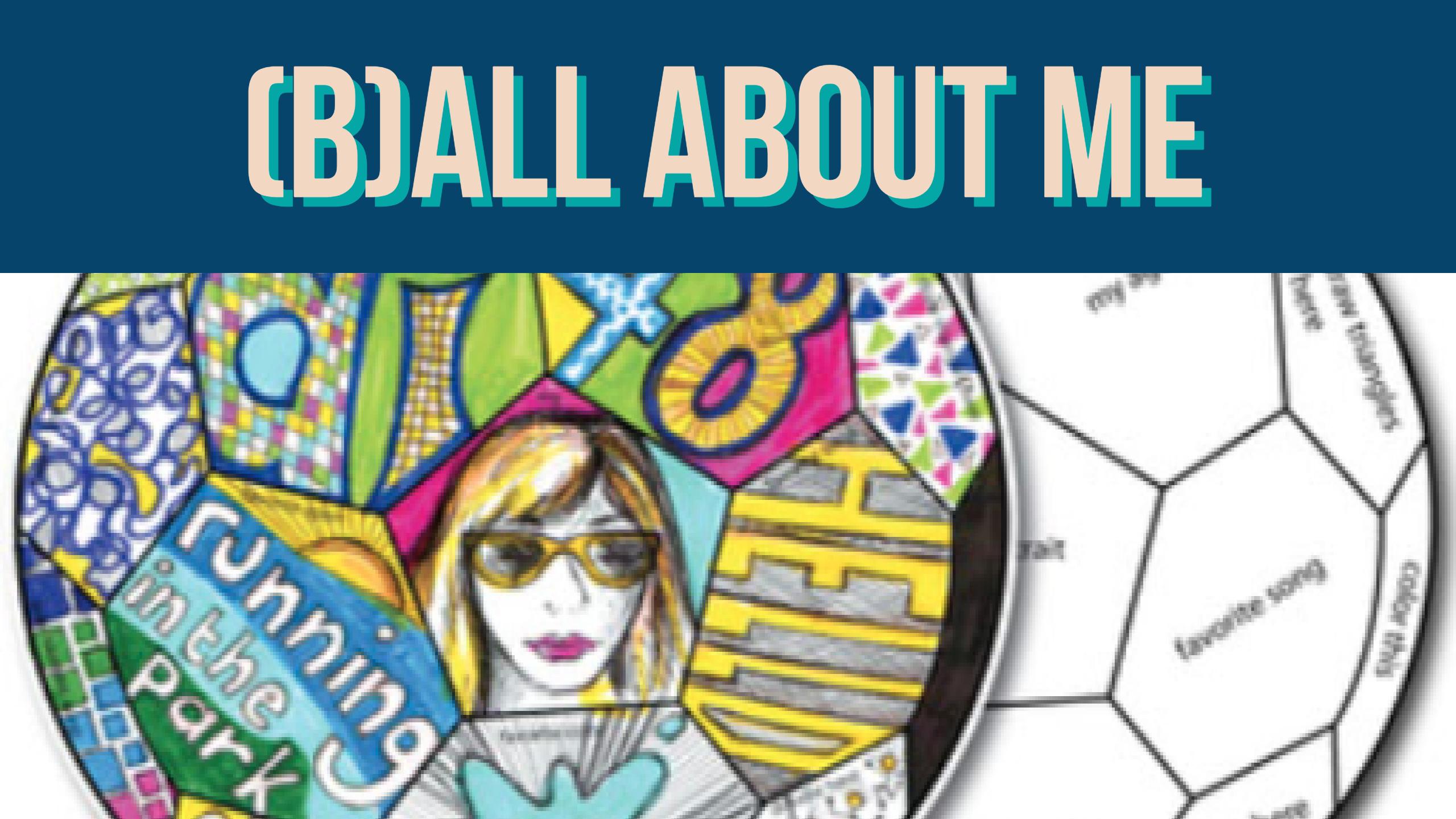
First day of school activities for high school students
14. get on that chair.
For this classroom icebreaker, students need to be flexible and balanced. For every student, the teacher places a chair. All the chairs should be lined up in a single line. Every student has to stand on a chair. Then, the teacher asks them to go stand in a certain order. For example: “I want you to organize yourselves from young to old.” The students now have to change places without touching the ground.
With this 1st day of school activity, the students get to know each other better in an interactive way. The teacher can give other orders like: “from tall to small.” or “from A to Z.” Every time the students have to change their positions without pushing someone off the chairs. If you want to make it more challenging, you can set a time limit.
💡 Pro tip : Do you find it difficult to come up with assignments? Be sure to check out this Randomness activity , it provides a randomly assigned task for this engaging activity.😉

15. Lie to me
This first day of school activity is a fun way to get to know your students better. Not just the basics, like where they live or if they have a brother, but real stories and anecdotes.
The students have to tell 3 facts about their life. Something that happened to them. Two of them should be true, and one should be a lie. The other students have to find out which one is the lie. You’ll be surprised what kind of crazy things can actually happen! (Or how good your students can lie!)
💡 Pro tip : You can make this assignment even more challenging! Let students write down these stories, and the teacher will read them aloud. This way, other students have to figure out whose it is and what the lie is. Use this activity to easily collect the result.

I hope you now know what to do during your first day of school. If this is not the case and you would like other creative lesson ideas, click here. Share this with your teacher colleages to give them some inspiration. Here comes the new school year! 🎉
Other get-to-know you games are also welcome, of course! Share them in our Teaching with BookWidgets Facebook group and don’t forget to follow us on Twitter .
Oh one more tip: here, you can find student introduction games and fun student energizers .
Say hi 👋 to me on LinkedIn

Join hundreds of thousands of subscribers, and get the best content on technology in education.
BookWidgets enables teachers to create fun and interactive lessons for tablets, smartphones, and computers.


Diary Entry Writing: First Day Of School
The first day of school is a significant event that marks the beginning of a new chapter in your academic life. It can be filled with a mix of excitement, anticipation, and nerves. Documenting this experience in a diary can help you process your emotions and serves as a valuable memory to look back on. Here’s a guide to writing a diary entry about your first day of school.
Table of Contents
Step 1: Start with the Date and Setting
Begin your diary entry by noting the date and details about the school you’re attending. This can include the name of the school, the grade or level you’re entering, and any other relevant information.
September 1, 2024. Today was my first day of junior year at Lincoln High School.
Step 2: Describe Your Preparation
Reflect on the lead-up to the first day. What were your preparations like the night before? How did you feel when you woke up? Describe choosing your outfit, packing your bag, and saying goodbye to your summer routine.
I spent last night laying out my clothes and double-checking my school supplies. Waking up this morning, I felt a knot in my stomach, a mix of excitement and the usual first-day jitters.
Step 3: Capture the Arrival Experience
Talk about your arrival at school. What was your first impression upon stepping onto campus? Were there any notable sights, sounds, or smells?
The school courtyard was buzzing with activity. Freshly cut grass, the sound of locker doors slamming shut, and the sight of friends reuniting set the scene for a typical school atmosphere.
Step 4: Express Your Emotions
Be candid about how you felt throughout the day. Were you nervous about meeting new teachers, making friends, or finding your way around? Did you feel confident and prepared?
Walking through the halls, I felt a wave of nervousness, wondering if I’d find my classes on time and how I’d fit in with my new classmates.
Step 5: Introduce New Encounters
Did you meet new teachers or classmates? Describe your first impressions of them and any interactions that stood out.
My history teacher, Mrs. Clark, has a warm smile and a commanding presence that immediately caught my attention. I also met a fellow junior, Alex, who shares my love for soccer.
Step 6: Outline Your Schedule
Write down your class schedule and any initial thoughts about the subjects you’ll be studying. Are there any classes you’re particularly looking forward to or apprehensive about?
My schedule is packed with a mix of excitement and dread. Advanced Biology will be a challenge, but I’m looking forward to Computer Science.
Step 7: Reflect on Key Moments
Highlight any significant moments from the day. This could be a funny incident, a thought-provoking comment from a teacher, or a personal achievement, like answering a question correctly in class.
During lunch, I managed to find a spot with a group of friendly sophomores. We shared a laugh over our mutual confusion about the new cafeteria layout.
Step 8: Discuss Social Aspects
School isn’t just about academics; it’s also a social environment. Write about your interactions with friends, both old and new, and any plans you’ve made for the school year.
It felt great reconnecting with my best friend, Jamie. We’ve promised to join the drama club together this year.
Step 9: Mention After-School Feelings
How did you feel at the end of the day? Were you relieved, tired, enthusiastic, or overwhelmed? Document your post-school emotions and activities.
By the time the final bell rang, I was a mix of tired and energized. I’m excited to see what the rest of the year brings.
Step 10: Look Forward
End your entry with thoughts about the future. What are your hopes and goals for the school year? Is there anything you’re determined to accomplish or improve?
This year, I’m determined to be more organized and proactive with my studies. I’m hopeful that I’ll make new friends and create lasting memories.
Additional Tips:
- Use Sensory Details : Incorporate what you saw, heard, tasted, smelled, and touched to bring your entry to life.
- Include Direct Speech : If you had an interesting conversation, write it down. It can help you remember the exact emotions you felt.
- Be Honest : Don’t hold back on your feelings. Your diary is a safe space for genuine self-expression.
- Add Visuals : If you’re artistically inclined, doodle in the margins or stick in a photo that captures part of your day.
- Reflect : Use your diary entry as an opportunity to reflect on your personal growth and how you’ve changed since the previous first day of school.
Diary Entry First Day Of School Example #1
Dear Diary,
Today was the first day of school, and it was a day filled with excitement, nervousness, and anticipation. As I walked through the halls and met my classmates and teachers, I couldn’t help but feel a mixture of emotions.
The day began with a welcome assembly, where we met our new principal and teachers, and learned about the goals and expectations for the year. It was a great opportunity to connect with the school community and get a sense of what was to come.
Afterwards, we went to our homeroom classes and met our classmates. It was a great chance to reconnect with old friends and make new ones, and to get to know the people who we would be spending the year with.
In the afternoon, we had our first classes, where we learned about the subjects we would be studying and the expectations for the year. It was a great opportunity to get a sense of what was to come and to start thinking about our goals and aspirations for the year.
As I reflected on the day, I felt grateful for the opportunities that school provides, and for the chance to learn and grow. I thought about the importance of setting goals and working towards them, and of taking advantage of the opportunities that come our way. I felt inspired to make the most of the year ahead, and to appreciate the friendships and connections that we form along the way.
Until next time, Diary.
Diary Entry First Day Of School Example #2
Today was the first day of school, and it was a day filled with excitement, anticipation, and a little bit of nervousness. As I walked through the halls and met my classmates and teachers, I couldn’t help but feel a sense of wonder about the year ahead.
The day began with a welcome assembly, where we met our new principal and teachers, and learned about the theme of the year. It was a great opportunity to connect with the school community and get a sense of what was to come.
Afterwards, we went to our homeroom classes and met our classmates. It was a great chance to catch up with old friends and make new ones, and to get a sense of the energy and enthusiasm of the group.
In the afternoon, we had our first classes, where we learned about the subjects we would be studying and the expectations for the year. It was a great opportunity to get a sense of the challenges and opportunities that lay ahead, and to start thinking about how we could make the most of the year.
As I reflected on the day, I felt grateful for the opportunities that school provides, and for the chance to learn and grow. I thought about the importance of staying curious and open-minded, and of embracing new challenges and opportunities. I felt inspired to make the most of the year ahead, and to appreciate the friendships and connections that we form along the way.
Diary Entry First Day Of School Example #3
Today was the first day of school, and it was a day filled with excitement, curiosity, and a little bit of anxiety. As I walked through the halls and met my classmates and teachers, I couldn’t help but feel a sense of wonder about the year ahead.
The day began with an orientation session, where we learned about the school’s policies and procedures, and got a sense of the culture and values of the community. It was a great opportunity to start building a sense of belonging and connection.
Afterwards, we went to our homeroom classes and got to know our classmates. It was a great chance to connect with people who shared similar interests and values, and to start building the relationships that would carry us through the year.
In the afternoon, we had our first classes, where we learned about the subjects we would be studying and the expectations for the year. It was a great opportunity to start thinking about our passions and interests, and to start exploring the topics that we would be studying throughout the year.
As I reflected on the day, I felt grateful for the opportunities that school provides, and for the chance to learn and grow. I thought about the importance of staying curious and engaged, and of embracing new experiences and challenges. I felt inspired to make the most of the year ahead, and to appreciate the friendships and connections that we form along the way.
About Mr. Greg
Mr. Greg is an English teacher from Edinburgh, Scotland, currently based in Hong Kong. He has over 5 years teaching experience and recently completed his PGCE at the University of Essex Online. In 2013, he graduated from Edinburgh Napier University with a BEng(Hons) in Computing, with a focus on social media.
Mr. Greg’s English Cloud was created in 2020 during the pandemic, aiming to provide students and parents with resources to help facilitate their learning at home.
Whatsapp: +85259609792
[email protected]

My First Day At School Essay
500 words my first day at school essay.
Our lives are full of new events which we experience on different days. Similarly, going to school for the first time is also memorable. How can one forget their first day, it is only natural to remember the day, no matter good or bad. Thus, my first day at school essay will take you through my experience.

A New Experience
My first day at school was a completely new experience for me. It is because the atmosphere completely changes for any child. You always stay in the comfort and safety of your own home.
However, your first day at school opens door to unknown experiences and opportunities. Much like any other child, I was also scared on my first day. I remember clearly not letting go of my mother’s hand, hesitant to go in the classroom.
On my first day, I got up excited and put on my uniform for the first time. The feeling it gave me was so memorable, I can never forget it. As it was my first day, both my parents went to drop me off.
I remember seeing the classroom full of little children. Some crying while the others playing with others. I looked at my mother and gave her the look that I didn’t want them to leave. They had to go so I kept crying but eventually, my teacher consoled me.
Once I settled in the class, I talked with the other kids and started playing with them. The colourful walls of the classroom fascinated me a lot. We got many toys to play with so it all the other kids also got distracted and stopped crying.
Get the huge list of more than 500 Essay Topics and Ideas
My Sister My Saviour
My advantage was that my sister was also studying in the same school. She is 3 years older than me so she was my senior. During recess, I was starting to miss my parents so I got teary-eyed.
But, then my sister came to meet me and I feel she was no less than a saviour for me that day. She took permission from the teacher to take me out and I went with her to the playground.
We were swinging throughout recess. All my worries went away because I had a known face with me. After eating and swinging together, the bell rang to mark the end of the recess . So, she dropped me back to my class.
Before leaving, she gave me a kiss and patted my head. It was enough for me to go through the rest of the day without crying. Thus, it made me feel extremely blessed that I had my sister there for me.
Conclusion of My First Day At School Essay
Thus, my first day at school was really pleasant. It fills me with pride when I look back at it and share my experience with others. I feel my first day helped me become confident in school which ultimately shaped the rest of my years there. Thus, it was indeed a memorable experience for me.
FAQ on My First Day At School Essay
Question 1: Why is the first day of school memorable?
Answer 1: We usually remember the first day of school because it is a new experience for us completely. It is the first time we step out from the comfort of our home as kids, so it will be memorable.
Question 2: Does everyone have a good first day at school?
Answer 2: Not necessarily. Everyone’s experience differs, some kids enjoy a lot on their first day. While some which are maybe shy or feel homesick don’t enjoy it that much. Nonetheless, it grows on you and eventually kids start to love going to school.
Customize your course in 30 seconds
Which class are you in.

- Travelling Essay
- Picnic Essay
- Our Country Essay
- My Parents Essay
- Essay on Favourite Personality
- Essay on Memorable Day of My Life
- Essay on Knowledge is Power
- Essay on Gurpurab
- Essay on My Favourite Season
- Essay on Types of Sports
Leave a Reply Cancel reply
Your email address will not be published. Required fields are marked *
Download the App

100 Creative Writing Prompts for Middle & High School – 2024
April 15, 2024

Some high school students dream of writing for a living, perhaps pursuing an English major in college, or even attending a creative writing MFA program later on. For other students, creative writing can be useful for school assignments, in English and other subjects, and also for preparing their Common App essays . In a less goal-oriented sense, daily freewriting in a journal can be a healthy life practice for many high schoolers. Not sure where to start? Continue reading for 100 creative writing prompts for middle school and high school students. These middle/high school writing prompts offer inspiration for getting started with writing in a number of genres and styles.
Click here to view the 35 Best Colleges for Creative Writing .
What are Creative Writing Prompts?
Similar to how an academic essay prompt provides a jumping-off point for forming and organizing an argument, creative writing prompts are points of initiation for writing a story, poem, or creative essay. Prompts can be useful for writers of all ages, helping many to get past writer’s block and just start (often one of the most difficult parts of a writing process).
Writing prompts come in a variety of forms. Sometimes they are phrases used to begin sentences. Other times they are questions, more like academic essay prompts Writing prompts can also involve objects such as photographs, or activities such as walking. Below, you will find high school writing prompts that use memories, objects, senses (smell/taste/touch), abstract ideas , and even songs as jumping-off points for creative writing. These prompts can be used to write in a variety of forms, from short stories to creative essays, to poems.
How to use Creative Writing Prompts
Before we get started with the list, are a few tips when using creative writing prompts:
Experiment with different formats : Prose is great, but there’s no need to limit yourself to full sentences, at least at first. A piece of creative writing can begin with a poem, or a dialogue, or even a list. You can always bring it back to prose later if needed.
Interpret the prompt broadly : The point of a creative writing prompt is not to answer it “correctly” or “precisely.” You might begin with the prompt, but then your ideas could take you in a completely different direction. The words in the prompt also don’t need to open your poem or essay, but could appear somewhere in the middle.
Switch up/pile up the prompts : Try using two or three prompts and combine them, or weave between them. Perhaps choose a main prompt, and a different “sub-prompt.” For example, your main prompt might be “write about being in transit from one place to another,” and within that prompt, you might use the prompt to “describe a physical sensation,” and/or one the dialogue prompts. This could be a fun way to find complexity as you write.
Creative Writing Prompts for Middle School & High School Students (Continued)
Write first, edit later : While you’re first getting started with a prompt, leave the typos and bad grammar. Obsessing over details can take away from your flow of thoughts. You will inevitably make many fixes when you go back through to edit.
Write consistently : It often becomes easier to write when it’s a practice , rather than a once-in-a-while kind of activity. For some, it’s useful to write daily. Others find time to write every few days, or every weekend. Sometimes, a word-count goal can help (100 words a day, 2,000 words a month, etc.). If you set a goal, make sure it’s realistic. Start small and build from there, rather than starting with an unachievable goal and quickly giving up.
100 Creative Writing Prompts for Middle School & High School Teens
Here are some prompts for getting started with your creative writing. These are organized by method, rather than genre, so they can inspire writing in a variety of forms. Pick and choose the ones that work best for you, and enjoy!
Prompts using memories
- Begin each sentence or group of sentences with the phrase, “I remember…”
- Describe a family ritual.
- Choose an event in your life, and write about it from the perspective of someone else who was there.
- Pick a pathway you take on a regular basis (to school, or to a friend’s house). Describe five landmarks that you remember from this pathway.
- Write about your house or apartment using a memory from each room.
- Write an imaginary history of the previous people who lived in your house or apartment.
- Write about an ancestor based on stories you’ve heard from relatives.
- What’s your earliest memory?
- Who was your first friend?
- Write a letter to someone you haven’t seen since childhood.
- Write about yourself now from the perspective of yourself twenty, or eighty, years from now.
- Write about the best month of the year.
- Write about the worst day of the year.
- Rant about something that has always annoyed you.
- Write about the hottest or coldest day you can remember.
- Visualize a fleeting moment in your life and as though it’s a photograph, and time yourself 5 minutes to write every detail you can remember about the scene.
- Draw out a timeline of your life so far. Then choose three years to write about, as though you were writing for a history book.
- Write about a historical event in the first person, as though you remember it.
- Write about a memory of being in transit from one place to another.
Objects and photographs as creative writing prompts
- Describe the first object you see in the room. What importance does it have in your life? What memories do you have with this object? What might it symbolize?
- Pick up an object, and spend some time holding it/examining it. Write about how it looks, feels, and smells. Write about the material that it’s made from.
- Choose a favorite family photograph. What could someone know just by looking at the photograph? What’s secretly happening in the photograph?
- Choose a photograph and tell the story of this photograph from the perspective of someone or something in it.
- Write about a color by describing three objects that are that color.
- Tell the story of a piece of trash.
- Tell the story of a pair of shoes.
- Tell the story of your oldest piece of clothing.
Senses and observations as creative writing prompts
- Describe a sound you hear in the room or outside. Choose the first sound you notice. What are its qualities? It’s rhythms? What other sounds does it remind you of?
- Describe a physical sensation you feel right now, in as much detail as possible.
- Listen to a conversation and write down a phrase that you hear someone say. Start a free-write with this phrase.
- Write about a food by describing its qualities, but don’t say what it is.
- Describe a flavor (salty, sweet, bitter, etc.) to someone who has never tasted it before.
- Narrate your day through tastes you tasted.
- Narrate your day through sounds you heard.
- Narrate your day through physical sensations you felt.
- Describe in detail the physical process of doing an action you consider simple or mundane, like walking or lying down or chopping vegetables.
- Write about the sensation of doing an action you consider physically demanding or tiring, like running or lifting heavy boxes.
- Describe something that gives you goosebumps.
- Write a story that involves drinking a cold glass of water on a hot day.
- Write a story that involves entering a warm house from a cold snowy day.
- Describe someone’s facial features in as much detail as possible.
Songs, books, and other art
- Choose a song quote, write it down, and free-write from there.
- Choose a song, and write a story in which that song is playing in the car.
- Choose a song, and write to the rhythm of that song.
- Choose a character from a book, and describe an event in your life from the perspective of that character.
- Go to a library and write down 10 book titles that catch your eye. Free-write for 5 minutes beginning with each one.
- Go to a library and open to random book pages, and write down 5 sentences that catch your attention. Use those sentences as prompts and free-write for 5-minutes with each.
- Choose a piece of abstract artwork. Jot down 10 words that come to mind from the painting or drawing, and free-write for 2 minutes based on each word.
- Find a picture of a dramatic Renaissance painting online. Tell a story about what’s going on in the painting that has nothing to do with what the artist intended.
- Write about your day in five acts, like a Shakespearean play. If your day were a play, what would be the introduction, rising action, climax, falling action, and resolution?
- Narrate a complicated book or film plot using only short sentences.
- Read a short poem. Then write a poem that could be a “sister” or “cousin” of that poem.
Abstract ideas as creative writing prompts
- Write about an experience that demonstrates an abstract idea, such as “love” or “home” or “freedom” or “loss” without ever using the word itself.
- Write a list of ways to say “hello” without actually saying “hello.”
- Write a list of ways to say “I love you” without actually saying “I love you.”
- Do you believe in ghosts? Describe a ghost.
- Invent a mode of time travel.
- Glass half-full/half-empty: Write about an event or situation with a positive outlook. Then write about it with a miserable outlook.
- Free-write beginning with “my religion is…” (what comes next can have as much or as little to do with organized religion as you’d like).
- Free-write beginning with “my gender is…” (what comes next can have as much or as little to do with common ideas of gender as you’d like).
- Write about a person or character that is “good” and one that is “evil.” Then write about the “evil” in the good character and the “good” in the evil character.
- Write like you’re telling a secret.
- Describe a moment of beauty you witnessed. What makes something beautiful?
Prompts for playing with narrative and character
- Begin writing with the phrase, “It all started when…”
- Tell a story from the middle of the most dramatic part.
- Write a story that begins with the ending.
- Begin a story but give it 5 possible endings.
- Write a list of ways to dramatically quit a terrible job.
- Write about a character breaking a social rule or ritual (i.e., walking backwards, sitting on the floor of a restaurant, wearing a ballgown to the grocery store). What are the ramifications?
- You are sent to the principal’s office. Justify your bad behavior.
- Re-write a well-known fairytale but set it in your school.
- Write your own version of the TV show trope where someone gets stuck in an elevator with a stranger, or a secret love interest, or a nemesis.
- Imagine a day where you said everything you were thinking, and write about it.
- Write about a scenario in which you have too much of a good thing.
- Write about a scenario in which money can buy happiness.
- Invent a bank or museum heist.
- Invent a superhero, including an origin story.
- Write using the form of the scientific method (question, hypothesis, test, analyze data conclusion).
- Write using the form of a recipe.
Middle School & High School Creative writing prompts for playing with fact vs. fiction
- Write something you know for sure is true, and then, “but maybe it isn’t.” Then explain why that thing may not be true.
- Write a statement and contradict that statement. Then do it again.
- Draft an email with an outlandish excuse as to why you didn’t do your homework or why you need an extension.
- Write about your morning routine, and make it sound extravagant/luxurious (even if it isn’t).
- You’ve just won an award for doing a very mundane and simple task. Write your acceptance speech.
- Write about a non-athletic event as though it were a sports game.
- Write about the most complicated way to complete a simple task.
- Write a brief history of your life, and exaggerate everything.
- Write about your day, but lie about some things.
- Tell the story of your birth.
- Choose a historical event and write an alternative outcome.
- Write about a day in the life of a famous person in history.
- Read an instructional manual, and change three instructions to include some kind of magical or otherwise impossible element.
Prompts for starting with dialogue
- Write a texting conversation between two friends who haven’t spoken in years.
- Write a texting conversation between two friends who speak every day and know each other better than anyone.
- Watch two people on the street having a conversation, and imagine the conversation they’re having. Write it down.
- Write an overheard conversation behind a closed door that you shouldn’t be listening to.
- Write a conversation between two characters arguing about contradicting memories of what happened.
- You have a difficult decision to make. Write a conversation about it with yourself.
- Write a conversation with a total lack of communication.
- Write a job interview gone badly.
Final Thoughts – Creative Writing Prompts for Middle School & High School
Hopefully you have found several of these creative writing prompts helpful. Remember that when writing creatively, especially on your own, you can mix, match, and change prompts. For more on writing for high school students, check out the following articles:
- College Application Essay Topics to Avoid
- 160 Good Argumentative Essay Topics
- 150 Good Persuasive Speech Topics
- Good Transition Words for Essays
- High School Success

Sarah Mininsohn
With a BA from Wesleyan University and an MFA from the University of Illinois at Urbana-Champaign, Sarah is a writer, educator, and artist. She served as a graduate instructor at the University of Illinois, a tutor at St Peter’s School in Philadelphia, and an academic writing tutor and thesis mentor at Wesleyan’s Writing Workshop.
- 2-Year Colleges
- Application Strategies
- Best Colleges by Major
- Best Colleges by State
- Big Picture
- Career & Personality Assessment
- College Essay
- College Search/Knowledge
- College Success
- Costs & Financial Aid
- Dental School Admissions
- Extracurricular Activities
- Graduate School Admissions
- High Schools
- Law School Admissions
- Medical School Admissions
- Navigating the Admissions Process
- Online Learning
- Private High School Spotlight
- Summer Program Spotlight
- Summer Programs
- Test Prep Provider Spotlight

“Innovative and invaluable…use this book as your college lifeline.”
— Lynn O'Shaughnessy
Nationally Recognized College Expert
College Planning in Your Inbox
Join our information-packed monthly newsletter.
I am a... Student Student Parent Counselor Educator Other First Name Last Name Email Address Zip Code Area of Interest Business Computer Science Engineering Fine/Performing Arts Humanities Mathematics STEM Pre-Med Psychology Social Studies/Sciences Submit
It's Lit Teaching
High School English and TPT Seller Resources
- Creative Writing
- Teachers Pay Teachers Tips
- Shop My Teaching Resources!
- Sell on TPT
Teaching Creative Writing: Tips for Your High School Class

When I was first told that I’d be teaching creative writing, I panicked. While I had always enjoyed writing myself, I had no idea how to show others how to do it creatively. After all, all of my professional development had focused on argumentative writing and improving test scores.
Eventually, though, I came to love my creative writing class, and I think you will too. In this post, I hope to help you with shaping your own creative writing class.
Disclosure: This post may contain affiliate links that earn me a small commission, at no additional cost to you. I only recommend products that I personally use and love, or think my readers will find useful.

The Importance of Teaching Creative Writing
Before getting into the nitty-gritty of how to teach creative writing, let’s first remind ourselves why you should teach a creative writing class.
How often do you see students freeze in your English class, wondering if what they’re writing is “right”? How often do your students beg you to look over their work to make sure that they’re doing it “right”?
We English teachers know that there’s no such thing as “right” when it comes to writing. But our students really struggle with the idea of there being no one correct answer. Creative writing is one solution to this problem.
By encouraging our students to explore, express themselves, and play with language, we show them how fun and exploratory writing can be. I know there have been many times in my life when writing clarified my own ideas and beliefs for me; creative writing provides this opportunity for our high school students.
Plus, creative writing is just downright fun! And in this modern era of standardized testing, high-stakes grading, and just increased anxiety overall, isn’t more fun just what our students and us need?
Creative writing is playful, imaginative, but also rigorous. It’s a great balance to our standard literature or composition curriculum.
Whether you’re choosing to teach creative writing or you’re being voluntold to do so, you’re probably ready to start planning. Make it as easy as possible on yourself: grab my done-for-you Creative Writing Class here !
Otherwise, preparing for an elective creative writing class isn’t much different than preparing for any other English class .
Set your goals and choose the standards you’ll cover. Plan lessons accordingly. Then, be sure to have a way to assess student progress.
Teaching Creative Writing Tip #1: Get Clear on Your Goals
First, what do you want to achieve with your creative writing class? In some school, Creative Writing is purely a fun elective. The goal is create a class that students enjoy with a side of learning.
For other schools or district cultures, however, Creative Writing might be an intensely academic course. As a child, I went to an arts middle school. Creative writing was my major and it was taken very seriously.
The amount of rigor you wish to include in your class will impact how you structure everything . So take some time to think about that . You may want to get some feedback from your administrator or other colleagues who have taught the course.
Some schools also sequence creative writing classes, so be sure you know where in the sequence your particular elective falls. I’ve also seen schools divide creative writing classes by genre: a poetry course and a short story course.
Know what your administrator expects and then think about what you as an instructor want to accomplish with your students.
Teaching Creative Writing Tip #2: List Out Your Essential Skills
Regardless of your class’s level of rigor, there are some skills that every creative writing course should cover.

First, you need to cover the writing process. Throughout the course, students should practice brainstorming, outlining, writing, and editing their drafts. In nearly every Poem Writing Activity that I use in my class, students follow the same process. They examine a model text, brainstorm ideas, outline or fill out a graphic organizer, put together a final draft, and then share with a peer for feedback.
That last step–sharing and critiquing work–is an essential skill that can’t be overstated. Students are often reluctant to share their work, but it’s through that peer feedback that they often grow the most. Find short, casual, and informal ways to build in feedback throughout the class in order to normalize it for students.

Literary terms are another, in my opinion, must-cover topic for teaching a creative writing class. You want your students to know how to talk about their writing and others’ like an actual author. How deep into vocabulary you want to go is up to you, but by the end of the course, students should sound like writers honing their craft.
Lastly, you should cover some basic writing skills, preferably skills that will help students in their academic writing, too. I like to cover broad topics like writing for tone or including dialogue. Lessons like these will be ones that students can use in other writing assignments, as well.
Of course, if you’re teaching a creative writing class to students who plan on becoming creative writing majors in college, you could focus on more narrow skills. For me, most of my students are upperclassmen looking for an “easy A”. I try my best to engage them in activities and teach them skills that are widely applicable.
Teaching Creative Writing Tip #3: Make Sure Your Materials are Age-Appropriate
Once you know what you’re teaching, you can begin to cultivate the actual lessons you’ll present. If you pick up a book on teaching creative writing or do a quick Google search, you’ll see tons of creative writing resources out there for young children . You’ll see far less for teens.

Really, the content and general ideas around creative writing don’t change much from elementary to high school. But the presentation of ideas should .
Every high school teacher knows that teens do not like to feel babied or talked down to; make sure your lessons and activities approach “old” ideas with an added level of rigor or maturity.
Take for example the haiku poem. I think most students are introduced to haikus at some point during their elementary years. We know that haiku is a pretty simple poem structure.
However, in my Haiku Poem Writing Lesson , I add an extra layer of rigor. First, students analyze a poem in which each stanza is its own haiku. Students are asked not only to count syllables but to notice how the author uses punctuation to clarify ideas. They also analyze mood throughout the work.
By incorporating a mentor text and having students examine an author’s choices, the simple lesson of writing a haiku becomes more relevant and rigorous.

Teaching Creative Writing Tip #4: Tell Students What They Should Not Write About
You’ll often be surprised by just how vulnerable your students are willing to be with you in their writing. But there are some experiences that we teachers don’t need to know about, or are required to act on.
The first day of a creative writing course should always include a lecture on what it means to be a mandated reporter. Remind students that if they write about suicidal thoughts, abuse at home, or anything else that might suggest they’re in danger that you are required by law to report it.
Depending on how strict your district, school, or your own teaching preferences, you may also want to cover your own stance on swearing, violence, or sexual encounters in student writing. One idea is to implement a “PG-13” only rule in your classroom.
Whatever your boundaries are for student work, make it clear on the first day and repeat it regularly.

Engage your students in more creative writing!
Sign up and get five FREE Creative Writing journal prompts to use with your students!
Opt in to receive news and updates.
Keep an eye on your inbox for your FREE journal prompts!
Teaching Creative Writing Tip #5: Give Students Lots of Choice

Creative writing should be creative . Yes, you want to give students parameters for their assignments and clear expectations. But you want them to feel a sense of freedom, also.
I took a class once where the story starters we were given went on for several pages . By the time we students were able to start writing, characters had already been developed. The plot lines had already been well-established. We felt written into a corner, and we all struggled with wrapping up the loose ends that had already been created.

I’ve done an Author Study Project with my class in which students were able to choose a poet or short story author to study and emulate. My kids loved looking through the work of Edgar Allan Poe, Elizabeth Acevedo, Neil Gaiman, and Jason Reynolds for inspiration. They each gravitated towards a writer that resonated with them before getting to work.
Another example is my Fairy Tale Retelling Project. In this classic assignment, students must rewrite a fairy tale from the perspective of the villain. Students immediately choose their favorite tales, giving them flexibility and choice.
I recommend determining the form and the skills that must be demonstrated for the students . Then, let students choose the topic for their assignment.
Teaching Creative Writing Tip #6: Use Hands-On Activities
If you’re teaching a class full of students who are excited to write constantly, you can probably get away writing all class period. Many of us, however, are teaching a very different class. Your students may have just chosen an elective randomly. They might not even have known what creative writing was!
(True story–one of my creative writing students thought the class would be about making graffiti. I guess that is writing creatively!)
For students who have no long-term writing aspirations, you need to make your lessons and activities a little more engaging.
When possible, I try to make writing “hands-on.” Adding some tactile activity to a standard lesson breaks up class, engages students, and makes the lesson more memorable.

For example, when I teach students the old adage “Show. Don’t Tell” , I could just give them a scene to write. Instead, I print simple sentences onto strips of paper and have students randomly select one from a hat. (Then they turn this simple sentence into a whole “telling” scene.)
Simply handing students a strip of paper that they can touch and feel makes the lesson more exciting. It creates more buy-in with students.
Another one of my favorite hands-on activities is a Figurative Language Scavenger Hunt. I hang up posters of mentor poems around the room, each full of different figurative language techniques.
Then, students must get up and explore the posters around the room in an attempt to find an example of 10 different figurative language techniques.
We could do the same lesson on a worksheet, but having students up and moving increases engagement, collaboration, and gives everyone a break from constantly sitting.

Teaching Creative Writing Tip #7: Incorporate Mentor Texts
One way to make sure that your creative writing class is rigorous–and valuable–enough for high school students is to use mentor texts .
Mentor texts are essential for older students because it shows them what’s possible . Many of my students will rush through an assignment just to be done with it. If you ask them what they could do to improve their writing, they say that they think it’s fine.
But when they’re shown mentor texts or exemplar products produced by their peers, suddenly students see a myriad of ways in which they could improve their own work. They’re quick to make edits.
I try to always include a mentor text and several examples whenever I introduce students to new ideas or teach a new lesson. You can pull mentor texts from classic writers. However, I also recommend including writing from more modern poets and writers as well.
Teaching Creative Writing truly is a special job. Your students trust you with writing that many adults in their lives will never see. You’ll be able to watch students grow and bloom in a totally new way.
That doesn’t mean that teaching creative writing is without challenges or difficulties, however. If you want an easy place to start, or just want to save yourself a ton of planning time, I highly recommend checking out my Complete Creative Writing Class .
Inside this bundle, you’ll receive daily warm-ups, weekly lessons, two projects, several activities, a lesson calendar, and more! It’s truly everything you need for an engaging 9-week elective course!

Join the Mailing List to receive advance information about Jeff’s new books and signings. Join now and you will be able to read “Fear,” an original essay/short story by Jeff about fear in writing suspense.
No. 1 International Bestselling Author
Jeffery deaver, main navigation, search site, the first day of school.
A short story written by Jeffery Deaver for teachers and educators.
Indian summer in a small Midwestern suburb, a hot, hot day in early September.
His heavy book bag slung over his shoulder, Jim Martin—slim, sandy-haired, freckled—trudged along the pitted sidewalk at 7:30 this morning, on his way to Thomas Jefferson Middle School.
He walked slowly, enjoying the heat, enjoying the spongy feel of his new running shoes, enjoying the familiar sights along the route.
Filled with excitement, filled with anticipation, filled with curiosity.
Nervous, too.
This was, after all, the first day of school.
At the bottom of the hill, exactly a mile from his house, he turned the corner and saw the school in front of him.
It wasn’t really a very nice building. Single story, squat, yellowish stone. Nothing stood out except the tall flagpole that would ring like a clock chime when the rope slapped it on windy days. Today, in the still air, the pole was silent.
Taking a shortcut through a hedge, Jim walked over the football field, dew leaping from the toes of his shoes, grasshoppers jumping out of his path.
He glanced to his right and noticed a shaded spot on the field near the home team bleachers and a memory suddenly came back to him—a spring day on that very spot. He and Sam Gordon facing each other, fists balled up, ready to slug it out. Sam was an 8th grader, a big kid—he’d been held back a year. He dressed in dark clothes that smelled of cigarettes and motor oil and he wore his anger the way some women wear too much costume jewelry. For no particular reason he’d taken an instant disliking to quiet Jim, who was a year younger and fifty pounds lighter. Sam had mercilessly tormented him all year until finally Jim had had enough and agreed to Sam’s taunt to fight it out after school.
The boys circled, Jim terrified but defiant. Sam threw the first punch. Jim blocked it but then the bully’s left fist appeared from nowhere and clocked Jim in the cheek. He went down on his knees and Sam leapt on him, flailing away, Jim’s thin arms helpless to protect him from the stunning blows. The big boy then stood and was about to deliver a vicious kick to Jim’s ribs when a man’s voice cut through the April air.
“Boys! That’s enough.”
Coach LaBell stepped forward, pulled Sam away and ordered him to the principal’s office. Sneering, the boy stalked away.
The coach then helped Jim up and surveyed the damage to his face. The man said, “First the nurse, but I’m afraid you’re going to the principal too, Jim.”
“Yessir.”
The grizzled, crewcut man handed Jim a Kleenex for the blood, and the tears, waited a moment and then he said, “I want to tell you something, young man.”
“Yessir?” Jim asked.
“You want to know what I think the biggest difference is between being a child and being an adult?”
“What’s that?”
“Knowing the difference between the times you have to fight and the times you should walk away. You know what I’m saying?”
Jim nodded.
“Good. Now go see the nurse. Get that cut cleaned up.”
As Jim walked sullenly toward the door, Coach LaBell called, “Oh, Jim?”
The boy turned. “Yessir?”
“About those times you do have to fight?” The man pointed a stubby finger at Jim. “You better learn to watch out for left hooks. Or you’re gonna lose some teeth.”
“I’ll do that, coach.”
Now, this hot, hot first day of school, trudging through the dewy grass, Jim shifted his heavy book bag to the other shoulder, and he thought about how the coach’s words had really made a difference in the way he looked at life.
Closer to the school now, walking past the buses, yellow as pollen, watching the students and teachers, the impatient parents in the car pool lane. Jim waved hello to a few of the kids but he was still lost in his thoughts. He was glancing at a nearby classroom, Mr. Carter’s math class.
Oh, Jim hated math. He did all the homework; he’d spend hours studying for tests, but he could never do better than a C plus, at best. He now thought of one of Mr. Carter’s classes, early in the semester. The teacher had passed out a graded test—Jim’d gotten a C minus. After all that work, he was so frustrated, so discouraged. The teacher must’ve seen the look in his eyes and called him up after class.
“Having some trouble, I see, Jim.”
“I just don’t get it,” the boy said. “I mean, I try. I do the work. But it’s like it’s overwhelming. I freeze up and, you know, I panic.”
Soft-spoken Mr. Carter pulled a slip of paper out of his desk and wrote down several names. He said, “These’re math tutors, Jim. I want you and your parents to call one of them. I think they’ll be a big help.”
“Okay,” Jim said uncertainly. Then he took a deep breath and confessed, “The thing is, Mr. Carter, I just, I mean, I just don’t like math. I’m never going to like it. I know that.”
The teacher smiled at this. “Don’t like math? . . . .” He nodded. “Well, Jim, you have to understand something. Your goal here isn’t to learn to like math. I don’t want to teach you that. I don’t even care about that.”
“You don’t?”
“No, no, no . . . . I want to teach you to love learning about math, that’s all.” He repeated it. “I want you to love learning whatever it is you study.”
And Jim nodded, digesting this. He took the note home and he and his parents got a tutor and his grades improved a bit, not much. But he started to get some B minuses. The important thing for Jim, though, wasn’t the grade but what his teacher had told him. And he thought now, as he walked through the doorway to Thomas Jefferson Middle on this first day of school, about how the math teacher’s words, like Coach LaBell’s, had made a real difference in the way he thought about things.
Walking through the cool halls now, Jim smelled fresh paint and girls’ perfume and those weird biology lab smells. He got a drink at the fountain and headed for home room.
As he did he passed another classroom and another memory hit him. Ah, Mrs. Peabody’s English class. She was a stern, older woman the kids called psychic because she magically knew which students had read the real assignment and which had read the Cliff notes.
Jim thought about the time Mrs. Peabody had given the class a writing assignment. “Write about summer vacation,” she said. “Be as creative as you can. But,” the stern woman added, as she always did, “make sure you use proper spelling and grammar.”
Well, that night Jim sat at his desk at home and stared unhappily at a blank sheet of paper. He didn’t want to write a stupid essay about his summer vacation. For one thing it’d been a dog. A water park, two weeks of camp, his paper route. Boring . . . He’d actually been happy to get back to school.
So he gave up on the assignment and wrote what he wanted to. Not an essay at all but a short story. Science fiction. It was about a distant planet that didn’t have summer—it was spring all the time. And it didn’t have vacations either. The aliens on the planet worked 24 four hours a day.
The next morning he handed in the story but that night he lay awake until three a.m., thinking, Why did I do that? I totally ignored the assignment. What the heck was I thinking of? And here English was his favorite class. Maybe it’d take Mrs. Peabody a few days to grade the essays. He’d beg her for a chance to write another one, the sort she wanted.
But when he got to class the next morning it turned out that Mrs. Peabody had read and graded the essays.
And when he saw the way she glanced at him with a strange look in her stern, psychic eyes, he wished he’d stayed home sick.
The teacher said, “I’m going to pass back your summer vacation essays in a minute, but I want to say something first. When you write, when you put your words out for other people to read, you have to learn to take criticism. You have to remember that a critic’s words aren’t attacking you as human beings; they’re only an opinion about something you’ve created, no matter how harsh the opinion seems. . . . . And in this case I’m afraid I’ve got some rather harsh words to say.”
I’m in trouble, Jim thought, blushing already, betrayed by his freckles. Staring at the floor.
Mrs. Peabody continued, “Almost everyone in class wrote an essay about his or her summer vacation . . . . Almost everyone.”
This’s bad, Jim thought. I’m getting an F, I know it.
“But,” the teacher said, “one student decided he didn’t feel like doing that.”
Jim glanced up long enough to see her eyes focused on him.
This’s worse than an F. . . . I’m in note-to-the-parents territory now.
Then Mrs. Peabody looked away from Jim and studied the rest of the class. “All of your essays read as if they were written in your sleep. It’s clear to me that you didn’t take the assignment seriously and none of you spent more than ten minutes on it. Just one of you had the courage to be as imaginative as I asked you to be. Jim Martin is only one who got an A on the assignment. Now I’m going to ask him to come up here and read his story to you as an example of thinking independently and being creative.” Then, being Mrs. Peabody, she added sternly, “though he should’ve a little more attention to proper spelling and grammar.”
Hands trembling, Jim walked to the front of the classroom in triumph, as if he were climbing to the summit of Mount Everest or were the first person to step onto the surface of Mars.
What a small thing really, he now reflected as he dodged through the crowded hallway, just a single assignment. But what a difference that moment had made to him.
Strolling into his home room now, Jim unslung his book bag and sat down as the last of the students filed in. He could see that some of them too were filled with excitement, some with anticipation.
Some with curiosity.
And some were nervous. Just like him, on this hot, hot Indian Summer morning in September.
Then the bell rang, a jarring noise, and eventually silence filled the room, silence broken only by the shuffle of papers, the click of pens, the snapping clasps of purses. The students looked toward the teacher’s desk.
Silence . . .
Jim took a deep breath, paused and he stood. He turned around and picked up a marker. He wrote on the white board, “Mr. Jim Martin, Home Room and Eighth-grade English.” And he added his office hours beneath his name.
He turned back and said, “Good morning, class.” And with a smile he looked over his students on this, the first day of school . . . and his very first day as a teacher. How strange it was, he thought, to be starting his career here at Thomas Jefferson, the same school where he himself had been a student so many years ago and where he’d learned so much.
Like knowing when to fight and when to walk away—but always looking out for left hooks.
And loving learning for itself, whatever the subject you’re studying, even if you only get a C plus.
And always having the courage to think for yourself and to be creative—but making sure you use proper spelling and grammar.
Then he pulled his lesson plan and class roster out of his book bag and as he called the name of each of his students he thought again briefly about Coach LaBell and Mr. Carter and Mrs. Peabody and the teachers here and in the other schools Jim had attended throughout his life and he knew that, like them, he too was going to make a difference.
(C) 2002 Jeffery W. Deaver Use and reproduction permitted for personal and nonprofit purposes only.
Join Jeffery Deaver’s Mailing List
- International
- Schools directory
- Resources Jobs Schools directory News Search

Write A Story Called 'The First Day At School' (9-14 years)
Subject: English
Age range: 11-14
Resource type: Lesson (complete)
Last updated
13 September 2022
- Share through email
- Share through twitter
- Share through linkedin
- Share through facebook
- Share through pinterest

25 pages in length
Creative Story Writing work packs cut down preparation time when planning creative writing tasks. Easy to follow, each pack includes an example of how you can build on a title, to first plan a story for 9-12 year olds and then write it.
How To Use Your Work Pack:
Make sure the child/children know that stories must be planned
Read the model story in the pack
Ask the child/children to write down the names of the characters in the story
Ask the child/children to write down where the setting takes place
Ask the child/children to write down what the plot is
Identify the most exciting part of the story (the climax of the story or suspense)
Ask the child/children to plan a similar story - with a beginning, a middle and an end
Ask the child/children to rewrite their own version of the story
Ask the child/children to read their version of the story aloud
Creative Story Writing work packs are essential for all students wanting to develop their literacy skills and improve their grades in English assignments and examinations. The work packs will guide students through the story writing process, as if they had a tutor by their side. Each pack is designed to help the child with thinking up ideas, providing starting points for writing, structuring and organizing their writing into paragraphs. It features writing a good introduction with characters, setting and plot, building up suspense and winding up the plot with a suitable resolution.
Attention is given to making writing more interesting by varying sentence types, using punctuation and good grammar. The student will investigate different narrative structures for writing stories, exploring various viewpoints so they can decide if they write in first or third person. They will learn to evoke mood and atmosphere by using good vocabulary. Each pack includes an exciting range of model answers and sample texts written by children and provides practice questions to test them. Common errors made by students are highlighted and corrected. Each pack contains vital hints and tips on gaining those top grades.
Tes paid licence How can I reuse this?
Your rating is required to reflect your happiness.
It's good to leave some feedback.
Something went wrong, please try again later.
This resource hasn't been reviewed yet
To ensure quality for our reviews, only customers who have purchased this resource can review it
Report this resource to let us know if it violates our terms and conditions. Our customer service team will review your report and will be in touch.
Not quite what you were looking for? Search by keyword to find the right resource:
Accessibility links
- Skip to content
- Accessibility Help
BBC 500 Words 2023
Click the link below for 500 words 2023.
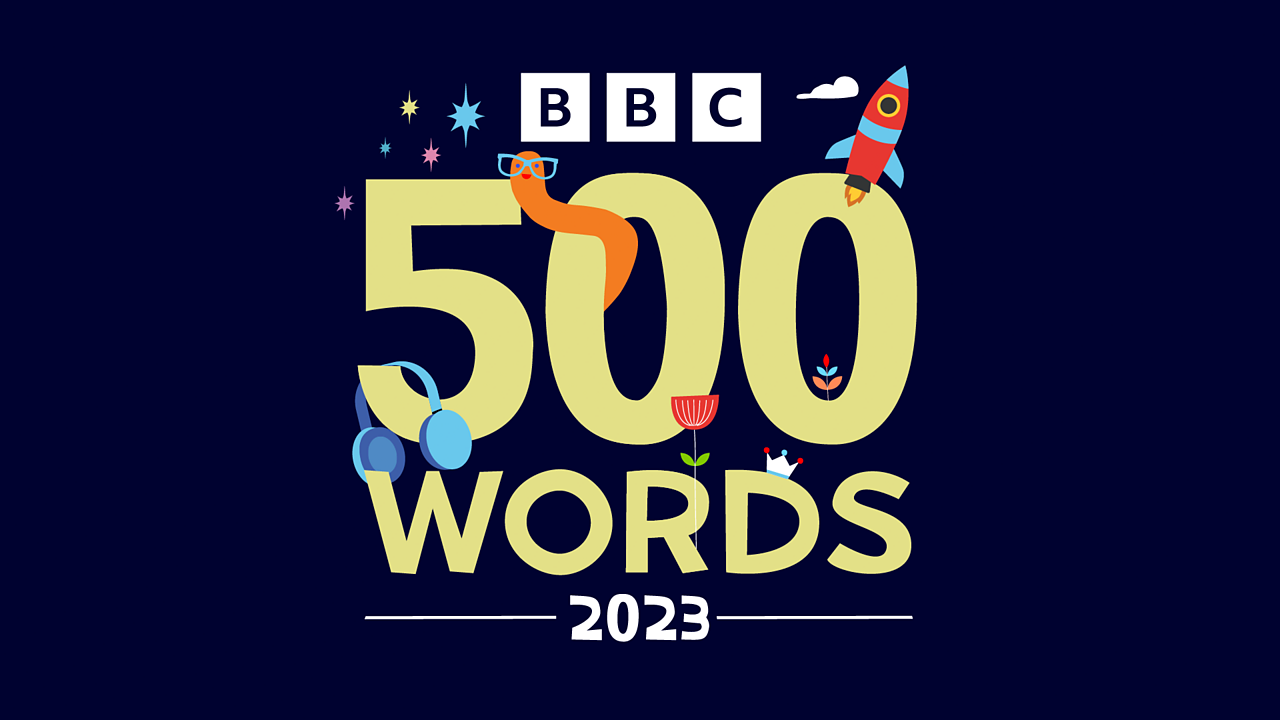
Click here for everything you need to know about 500 Words 2023

IMAGES
VIDEO
COMMENTS
Here you'll see 15 fabulous first day of school writing activities — This list of ideas is packed full of fun and engaging ways to interact with the new group of kids in your classroom. Plus, you'll find nine first day of school writing ideas, twelve new school year resolutions, 8 ice breakers, and 5 school success tips. Oh yeah….
10. Write about two habits you need to change plus what you will do in order to improve. 11. Describe the perfect school day. 12. The topic is the first week of school. Now generate a list of actions and things related to the topic for every letter of the alphabet. 13. Explain the best ways to study for a test.
17 Fun First Day Of School Writing Activities. By Shane Mac Donnchaidh July 23, 2021April 1, 2024 April 1, 2024. The smell of freshly painted halls, the excited chatter of returning students bursting with two months' worth of gossip to share—it must be the first day at school again. Rusty pens and dusty pencils are hastily pulled from the ...
Write a letter to your younger self, and then another to your older self. One important rule of creative writing is to "Show Don't Tell.". Write a 1,500-word short story in your favorite genre, following this rule. Write a local wildlife guide to your backyard, neighborhood, local park, or even the school itself.
As the school year begins, teachers eagerly brainstorm ways to engage their students from day one. One powerful tool is writing prompts. By using thought-provoking topics, educators can encourage creativity, self-expression, and critical thinking skills. In this article, we'll explore some captivating first day of school writing prompts that will inspire and engage students right from the ...
Not to worry we have come up with 56 back-to-school writing prompts that will help your child settle in and take away those first-day fears. We all know how the first day of school is daunting for most kids, that's why it is important to slowly prepare your kids for the back-to-school routine. One way to support your child is to encourage ...
By incorporating new writing prompts and creative writing ideas, the beginning of the year is a perfect time to introduce a regular writing practice to your students. As a bonus, you can use different writing prompts as conversation starters for a fun first week of school! ... 189 MORE Back to School Writing Ideas. 15 First Day of School ...
Here are 20 journal prompts about your expectations for the first day: Write about three things that you are most excited about for the first day. List five of your worries about your first day of school. Pen down your plan of action if your day starts going off-track. Imagine the best case scenario for your first day.
15. Journal. One of the simplest first-day-of-school writing activities is journaling. Journaling allows students the opportunity to reflect, express themselves, and release frustrations all while developing their writing skills. Use monthly writing calendars to kickstart journaling on the first day of school. 16.
Describe all the emotions and feelings a middle schooler may feel on the first day of school. 18. Summarize your favorite summer memory. 19. Write a comparison between your first day of school this year and your first day a few years ago. 20. Tell about what one of your classrooms looks and feels like. 21.
Brian A. Klems. Aug 25, 2016. Write about a first day of school—it can be your very first day, it can be the first day of a particular year or at a particular school, it can be a fictional first day. Dive into the emotions you felt as well as what you thought that year may hold. Post your response (500 words or fewer) in the comments below.
The First Day of School. This writing activity is straight forward and simply allows students to share how they felt when they woke up in the morning. It's also a perfect follow up activity to the book First Day Jitters by Julie Danneberg . The story has an awesome message about how teachers are nervous on the first day also!
It's also time to meet new people, make new friends, and learn different perspectives. These first-day-of-school activities will help you start off the year with a bang as you and your students form your community and begin your journey together. 1. Take first-day photos. Mark the occasion!
A wonderful list of Creative Writing Prompts High School students will love— Oh yeah! we think it's important for students to play with language. ... 15 Free First Day of School Writing Activities; 251 Creative Writing Prompts for Kids; Search. Now Offering You 18,000+ Prompts! Hello! I'm Journal Buddies Jill. ...
12. Art-phone. Social media and smartphones are going to be omnipresent during this school year. This fun classroom activity for the first day of school is a nice reminder of that fact. Let's get crafty and create an art-phone like the one in the image. Create an Instagram wall, a chat session and a social profile.
Step 1: Start with the Date and Setting. Step 2: Describe Your Preparation. Step 3: Capture the Arrival Experience. Step 4: Express Your Emotions. Step 5: Introduce New Encounters. Step 6: Outline Your Schedule. Step 7: Reflect on Key Moments. Step 8: Discuss Social Aspects.
FAQ on My First Day At School Essay. Question 1: Why is the first day of school memorable? Answer 1: We usually remember the first day of school because it is a new experience for us completely. It is the first time we step out from the comfort of our home as kids, so it will be memorable. Question 2: Does everyone have a good first day at ...
3. Write three goals you want to achieve this school year plus how you plan to reach them. 4. Draft a first day of school story that is rather unusual. 5. Tell about your typical morning routine. 6. Describe the steps you plan to take to achieve your academic goals and how you'll stay motivated. 7.
She served as a graduate instructor at the University of Illinois, a tutor at St Peter's School in Philadelphia, and an academic writing tutor and thesis mentor at Wesleyan's Writing Workshop. Creative Writing Prompts - We offer 100 fresh creative writing prompts for middle school and high school students.
Teach Creative Writing to High School Students Step #2: Choose Your Final Assessments and Big Projects. ... There are a ton of ways to implement peer interaction in a creative writing class. I often do this on the first day of class with a writing game. You've probably heard of it: everyone writes a sentence on a piece of paper, then everyone ...
Teaching Creative Writing Tip #2: List Out Your Essential Skills. Regardless of your class's level of rigor, there are some skills that every creative writing course should cover. My Poem Writing Activities always include examples or mentor texts. First, you need to cover the writing process.
The First Day Of School. A short story written by Jeffery Deaver for teachers and educators. Indian summer in a small Midwestern suburb, a hot, hot day in early September. His heavy book bag slung over his shoulder, Jim Martin—slim, sandy-haired, freckled—trudged along the pitted sidewalk at 7:30 this morning, on his way to Thomas Jefferson ...
Write A Story Called 'The First Day At School' (9-14 years) 25 pages in length. Creative Story Writing work packs cut down preparation time when planning creative writing tasks. Easy to follow, each pack includes an example of how you can build on a title, to first plan a story for 9-12 year olds and then write it.
The UK's biggest children's short story writing competition, 500 Words, is back at the BBC and we need your help! ... School Radio; Young Reporter; Teacher Support; BBC 500 Words 2023.